Back
We have another leave of absence lined up for 2012 at which time we plan to ride from Germany east across Russia to Japan and back via Southeast Asia. When Audrey's sister Helena (who lives near Munich) mentioned that there might be a wedding in the offing for the summer of 2011 we immediately thought of the possibility of flying our bikes to Europe, having a great summer vacation, enjoying the wedding and then storing the bikes in Germany until the summer of 2012. That would mean one less hassle before our departure in 2012 and an opportunity to finally ride to Nordkapp, Norway after the failed attempt in 2007 (See the Africa Section).
The Motorcycle Express website (a company that specializes in shipping motorcycles between North America and Europe with air cargo) showed that they would be able to fly our bikes into Amsterdam and checking Expedia.ca indicated that KLM now offered direct flights from Calgary to Amsterdam. Perfect, we could then visit relatives in the Netherlands, head north to Norway and return to Germany for the wedding. The KLM flights were booked early in order to secure the best possible price. A couple of months prior to departure we contacted Motorcycle Express to arrange the shipment to Amsterdam and were taken by surprise when we learned that their website had not been showing the most current information. Schiphol no longer took Dangerous Cargo and so Motorcycle Express couldn't ship our bikes there after all. What a rookie mistake from a couple of veteran travellers. Always arrange the motorcycle shipment first since it's easy to fly people anywhere in the world but bikes are a bit more difficult. The closest destination to Amsterdam that Motorcycle Express could take the bikes was Frankfurt and since it was quite expensive to change our flights with KLM we took the opportunity to arrange for a train ride from Amsterdam to Frankfurt.
A few days prior to departure we dropped the bikes at YYC Freight Services. Audrey dropped the F650 one day and the next day I rode the Adventure to the airport, making sure that the bikes were on reserve. We really hoped that we could store all of our camping gear in the hard luggage of the bikes and when we asked they said it would be no problem at all. We simply disconnected the batteries and left the bikes with YYC Freight Services to put on to the next flight to Frankfurt. On Saturday, July 2, we drove our car to Airdrie to leave at my parent's house (they were away on vacation) and then called a cab to take us to the airport where we boarded KLM's "Ingrid Bergman" for a pleasant flight to Amsterdam.
Audrey at YYC Freight Services dropping off her bike for shipment to Frankfurt
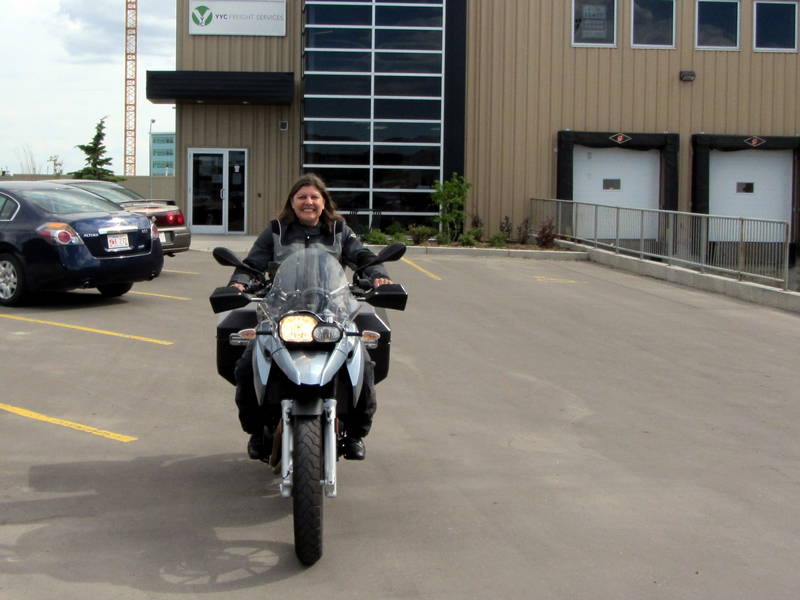
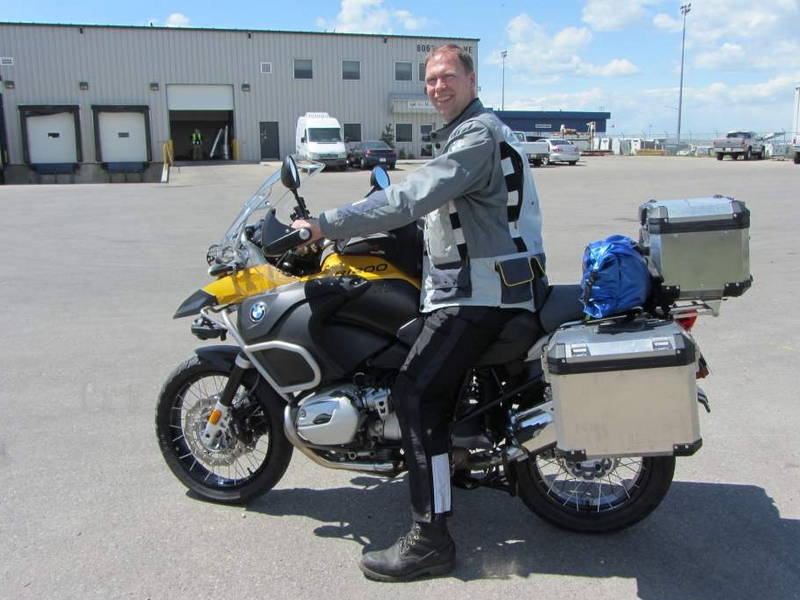
We flew KLM while our bikes went on Air Transat
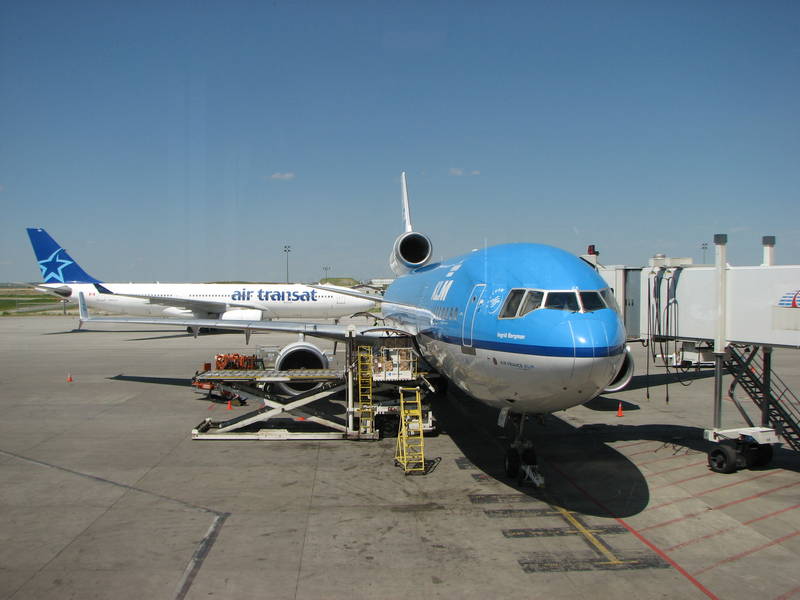
Oom Alle picked us up at Schiphol Airport on Sunday morning and brought us back to his apartment for a great breakfast. My uncle is quite the traveller so it was fun getting caught up on his latest trips. In fact, that afternoon he was going to a concert in Belgium (isn't Europe great?) so we walked to the local train station together. He went one way and we took a train the other way, towards downtown Amsterdam. We knew that the best thing for jet lag was to get outside in the sunshine and get as close as possible to the current time with our biological clocks as soon as possible. So we were determined to stay awake and be active. At Centraal Station we started walking. And walking. It was a beautiful day and we were in a great city for walking but it was getting increasingly difficult to stay awake. A lengthy break at a cafe rejuvenated us so that we could continue exploring. Later in the afternoon we found ourselves sitting on a dock beside a canal enjoying the sunshine. When I fell asleep and nearly tumbled into the canal we thought that it was about time to head back to my uncle's apartment. Once we collapsed on the train we had to prod each other every now and again in order to remain awake and get off at the right station. A few more feeble attempts to stay awake were made but in the end, resistance was futile. We made it to about 8:00 PM before falling into bed and didn't hear oom Alle return later that evening.
Oom Alled at Schiphol
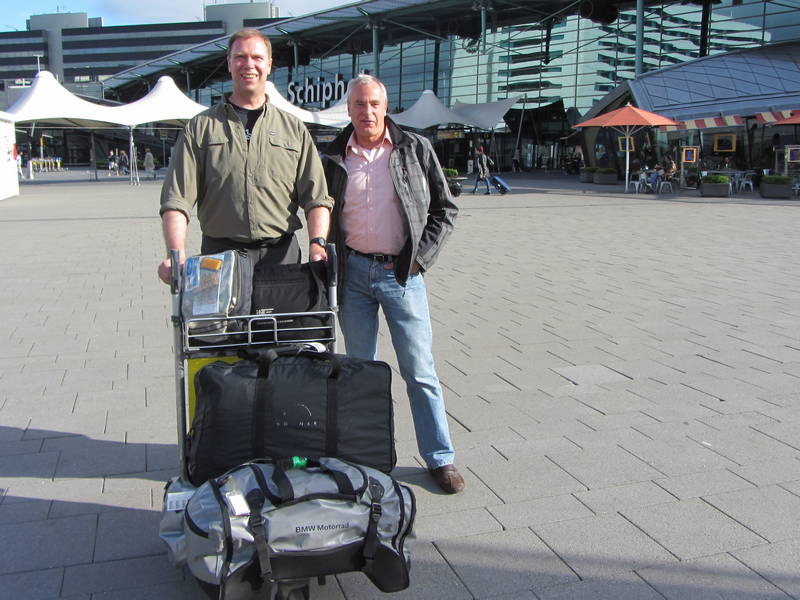
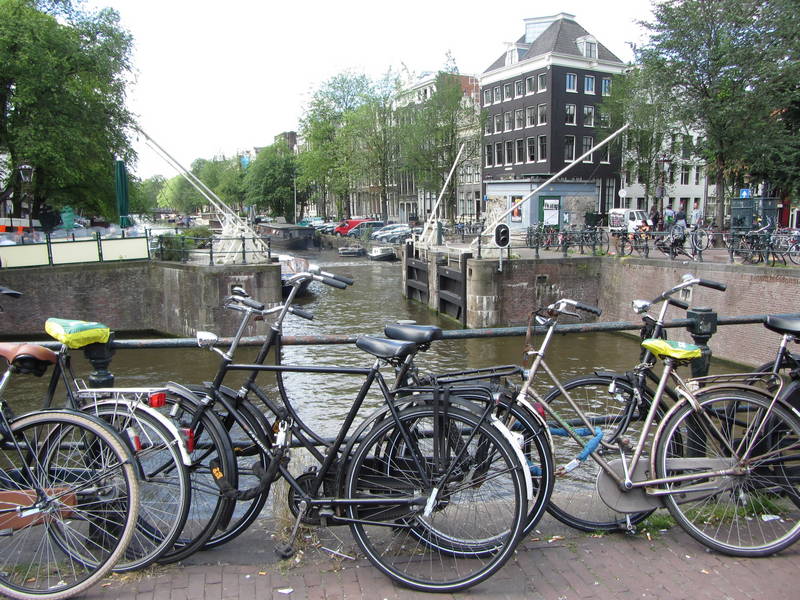
Ekke almost falls into the canal...
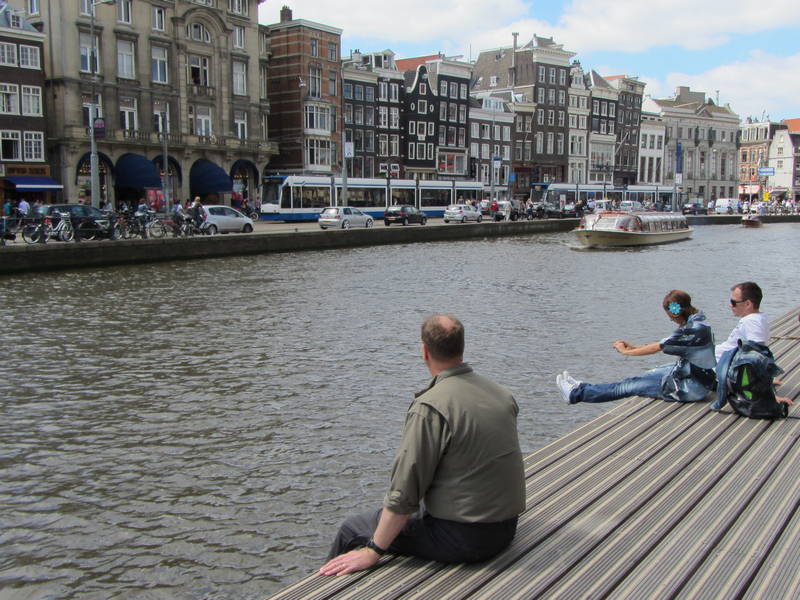
OK, how can they be the Sauce Masters but the price does not include the sauce???

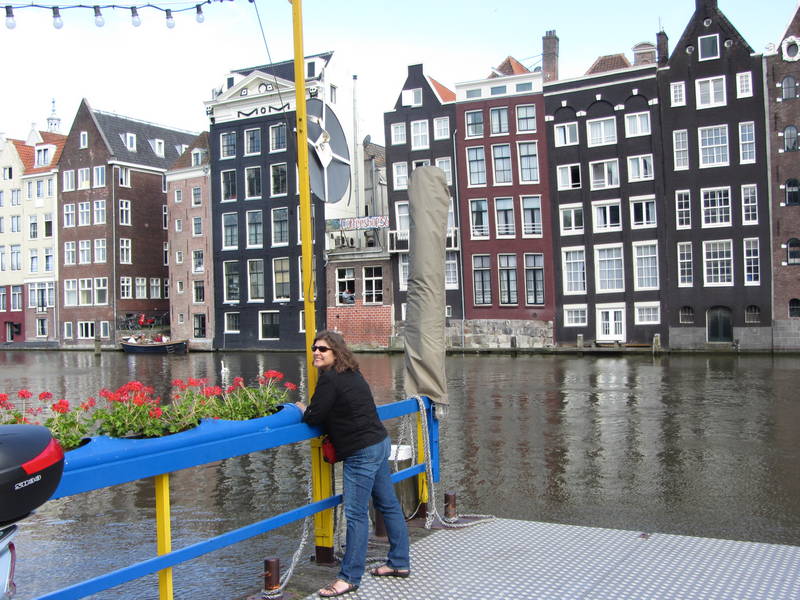
After breakfast on Monday morning oom Alle drove us down to the Centraal Station (easier than taking the commuter train with our entire luggage) and we hopped on board an Intercity Express train bound for Frankfurt, arriving in the early afternoon. We weren't planning to pick up the bikes right away, especially since we were still a bit jetlagged, but we did have to pick up the European insurance. So after taking the short cab ride from the train station to the same Ibis Accor hotel we had stayed at in 2002 we used the GPS to walk to the nearest ADAC (German automobile club) store. In 2007 insurance was 22 euros per month per bike so we were floored by the new price of 105 euros. Since I was flying back to Canada on August 6 we needed a month plus a couple of days of coverage. At 22 euro we would have happily paid for an entire extra month for those few days but at 105 it didn't make a lot of sense (105 x 2 euro = $320) so we planned to put the bikes in storage a few days earlier than anticipated. From the ADAC office we walked to the nearest BMW motorcycle store so that Audrey could purchase rain gear. She had mail ordered new rain gear in Canada but a postal strike meant that we didn't receive it before we left home. A stroll along the river Main, stopping for dinner at a riverside café, brought us back to the hotel ready to collapse into bed after a fairly full day.
Altstadt Frankfurt am Main

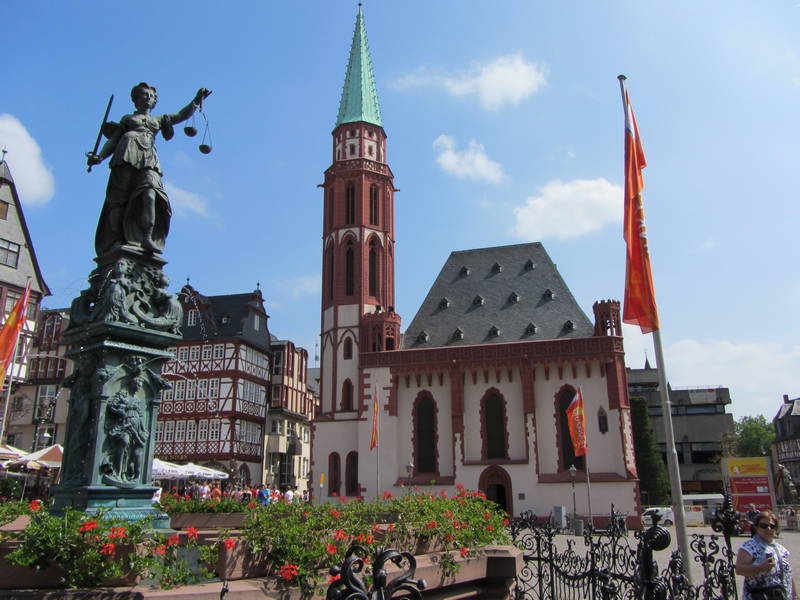
Audrey tries out for the FIFA Women's Football tournament but finds the ball a bit bigger than it looks on TV
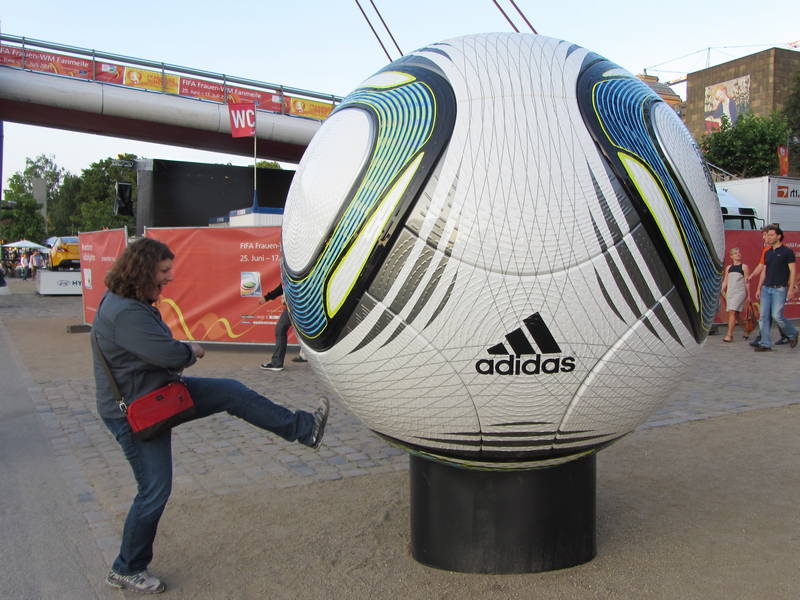
Rock band am Main
Tuesday we finally hit the road. We walked up to the train station and took the S-bahn to the airport where we hired a cab to drive us around to the cargo terminal. Again, super friendly people helped us through the process of getting bikes out. After an hour or so the bikes were brought out by a forklift and we could free them. We worked slowly and methodically so as not to injure anyone this time around. We rode back to the hotel in time to check out, loaded our stuff on board (will we ever learn not to overpack?) and wobbled out of Frankfurt, heading north. As Audrey's bike was well and truly onto Reserve we needed to find a gas station right after we got out of the city but that was a bit of a challenge once on the Autobahn. We ended up doing a U-turn to get back to a Shell on the other side of the highway. A great restaurant (it seems all German Autobahn restaurants are great) gave us some respite from the heat before going back north. 150 kilometres further up, while stopping for a drink, we decided to use the GPS to find the closest campground. Finally, off the Autobahn, we enjoyed 25 kilometres of small, winding roads through picture-perfect German villages to get to Frielendorf and a lovely campground. We took stock of our stuff and decided to mail to Helena the helmet bags and other gear we had needed for the airplane ride. I also thought that with the 30 degree heat a down-filled jacket was just taking up space that I could use for carrying important things like Nutella.
Carefully taking the bikes off the pallets at the cargo terminal
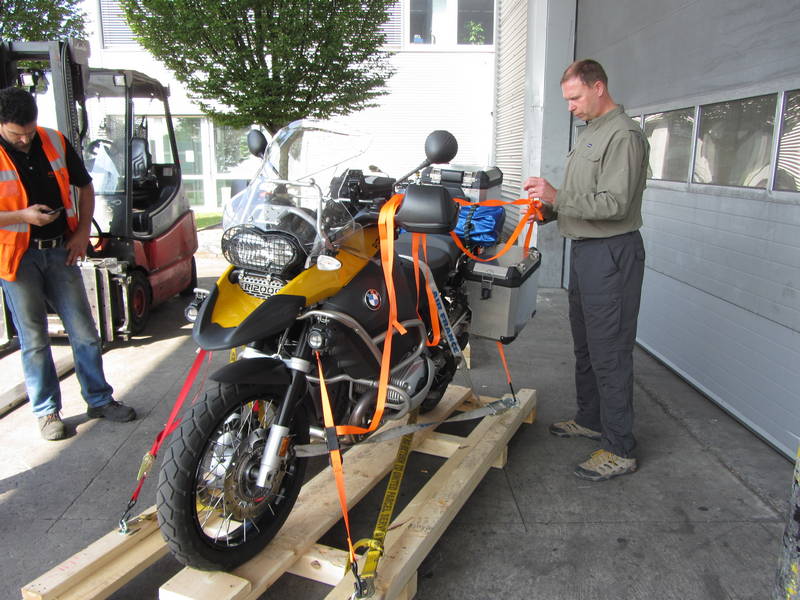
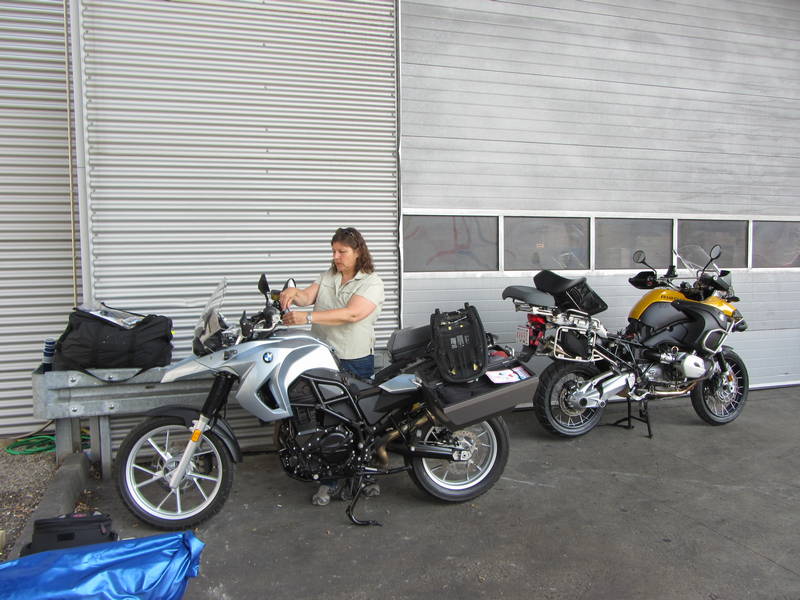
Our favourite hotel in downtown Frankfurt, cheap, clean and central
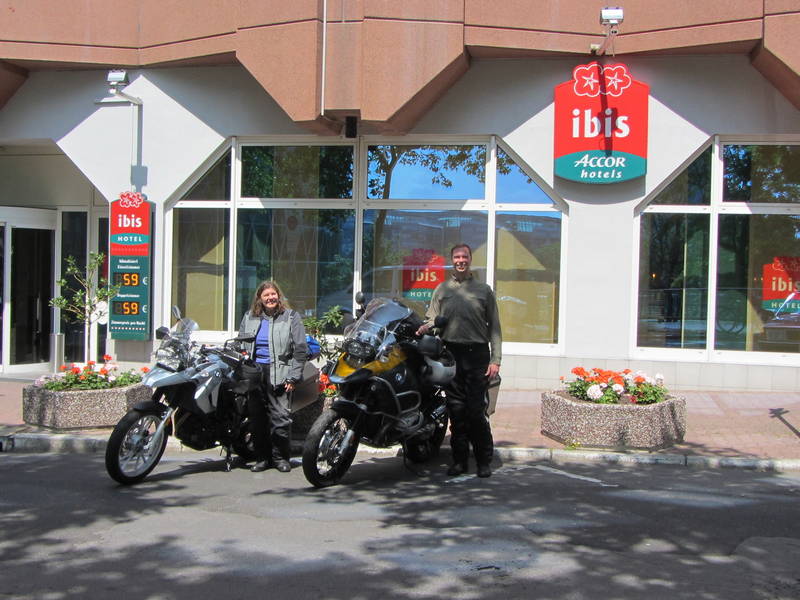
An autobahn gas station restaurant

After a typical (for us) German breakfast of fresh buns with Butterkäse (literally butter cheese) and Nutella we stopped off at the local post office in Frielendorf and sent the package south. A lovely ride through the countryside got us back on the autobahn towards Hamburg where we were greeted by a traffic jam. Traffic jam sounds so nice. I think the German word "stau" has a more unpleasant sound to it and more accurately reflects sitting in heavy traffic on a hot motorcycle. In any case, once clear of the stau and out of Hamburg the sky got darker and darker but it was quite warm and we didn't want to get into all the rain gear just to get soaked with sweat. Just a few kilometres from the campground we had chosen, while sitting at a railroad crossing waiting for a train, the skies simply opened up. We were instantly drenched. Amazing. We must have looked like drowned rats as we sloshed into the camp office and stood dripping in front of the counter. Rather than putting up the tent in the rain we hopped on the bikes and went out for supper which, except for nearly losing Audrey on the entrance to the autobahn and the GPS leading us down a dead-end, muddy path, was eventless. That evening, as I was laying my head down on a jacket and pile of clothes, I thought to myself, "Who thought it was a good idea to send away the fleece-lined pillow case and down-filled jacket?"
July 7 dawned foggy but dry so we packed up the wet tent and headed to a roadside stop for breakfast. The crossing into Denmark was a bit too uneventful and it wasn't even possible to take a photo at the border as we crossed into a new country. After paying a 155 kroner toll we took a beautiful bridge across the Storebælt and onto the island of Zealand where we stopped at the town of Køge to look for a cash machine. Køge had a beautiful medieval town centre with half-timbered houses, a cash machine and delicious ice cream. After wandering around while licking ice cream cones we jumped back on the bikes and rode the remaining distance into Copenhagen and to the Absalon Campground arriving at about 6:00 PM.
Crossing an 18 kilometre long bridge to Zealand in Denmark
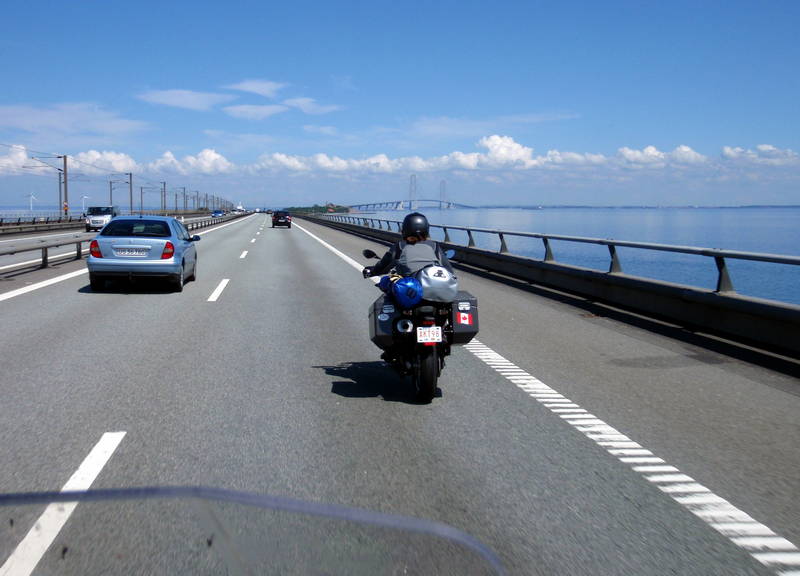
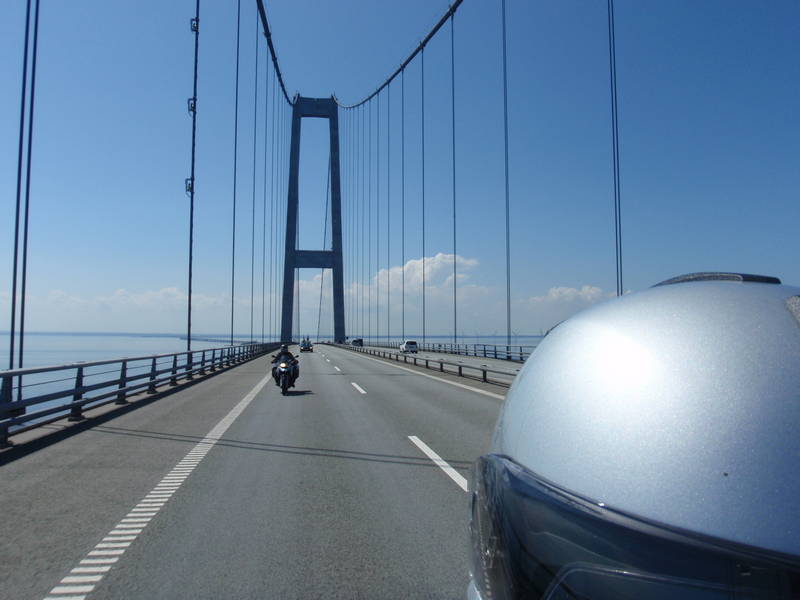
Køge
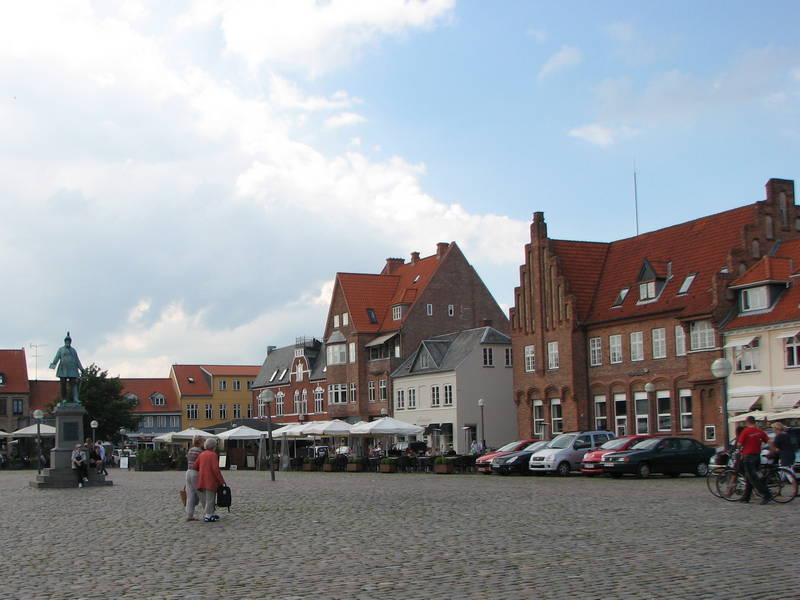
Audrey writes:
We stayed at the Absalon campground in Copenhagen and took the train into the wonderful city for a day of sightseeing. Our umbrellas came in handy for some torrential showers and we slipped into the Nationalmuseet to escape the rain. The Viking artefacts were fantastic, with plenty of cauldrons, horns, jewellery and weapons and the treasures were really quite advanced with sophisticated designs and decoration. Giant rune stones were very impressive, painted with runic inscriptions that had marked graves or important events such as when King Harald Bluetooth brought Christianity to the region. What a thrill to look at oak coffins that still contained remains of important Danes and had undergone a preservation process similar to mummification, with clothing and jewellery still intact.
National Museum



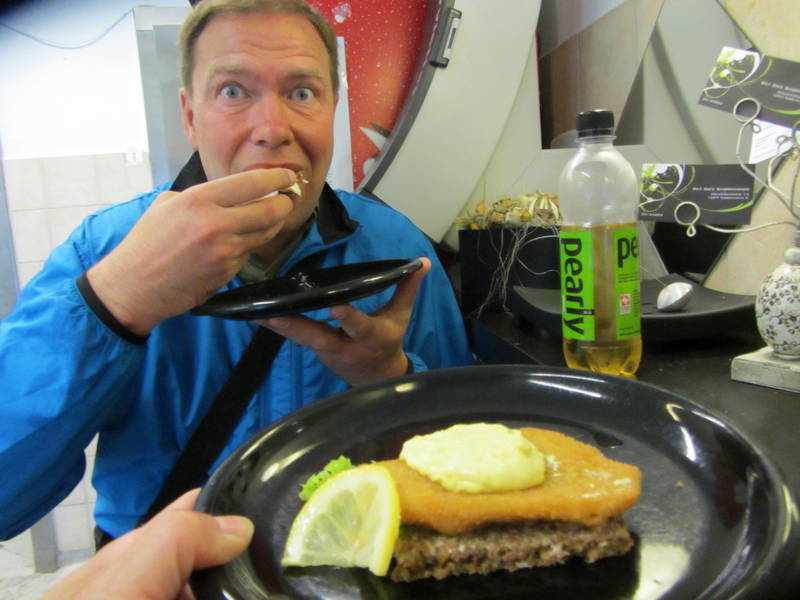
It was fun just walking around and enjoying the palaces and monuments built by great Danish kings, the oldest monarchy in Europe. Our favourite area was quayside Nyhavn with its pastel-coloured canal-side townhouses from the 17th century. Sailors had frequented here, enjoying beer and other activities, but now restaurants and shops had taken over. As it was still raining, we caught a harbour boat tour, the one with the roof. The scenery was beautiful but the most entertaining part was when a couple of tourists got pretty excited when any new sight was announced: the best restaurant in the world, Amelienborg palace, the opera house. When the tour guide announced that the Little Mermaid was up ahead, they went completely ballistic, screaming in delight. From the boat, we saw the back of the famous mermaid and I was, quietly, delighted. The sun eventually came out, which made a walk to Rosenborg Slot castle, the Latin Quarter and Tivoli gardens quite pleasant. The Tivoli is an antique amusement park, and a lot of it took us back to the Victorian era. The modern roller-coasters have now taken over.
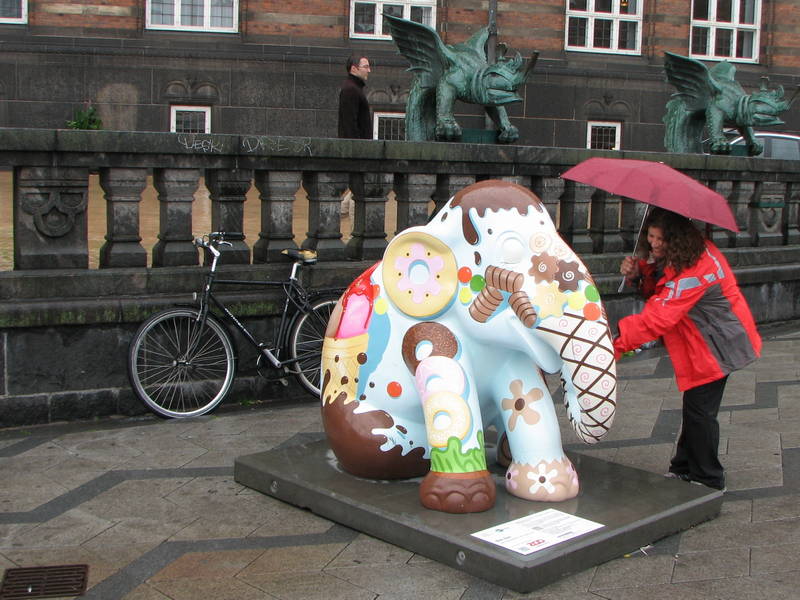
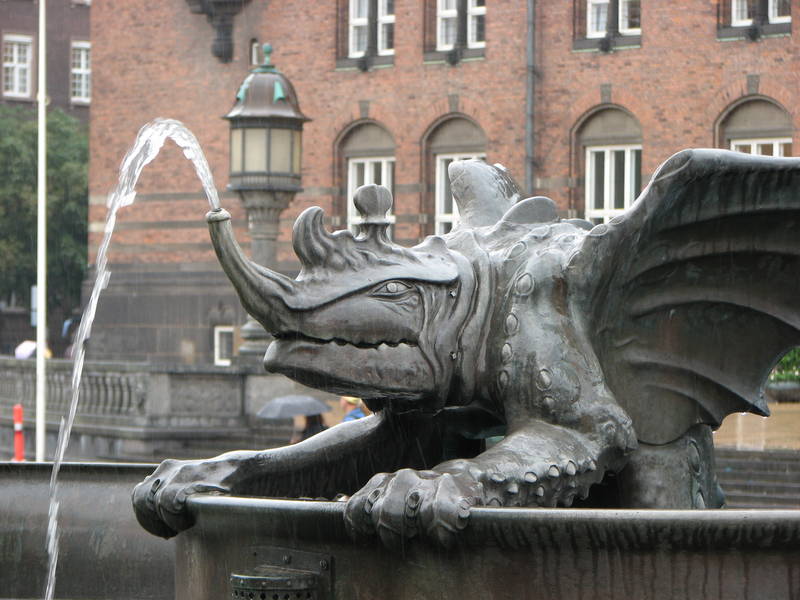
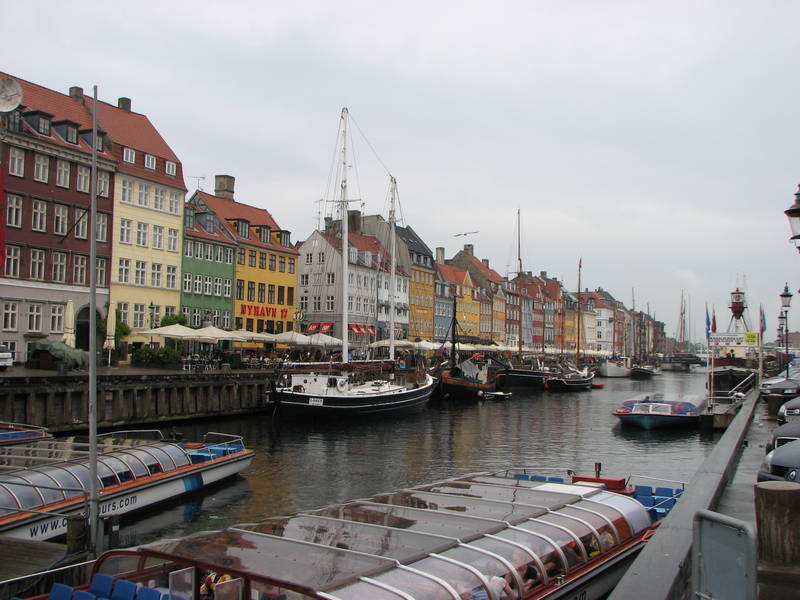
An excitable tourist...

... who went completely insane at the sight of the Little Mermaid
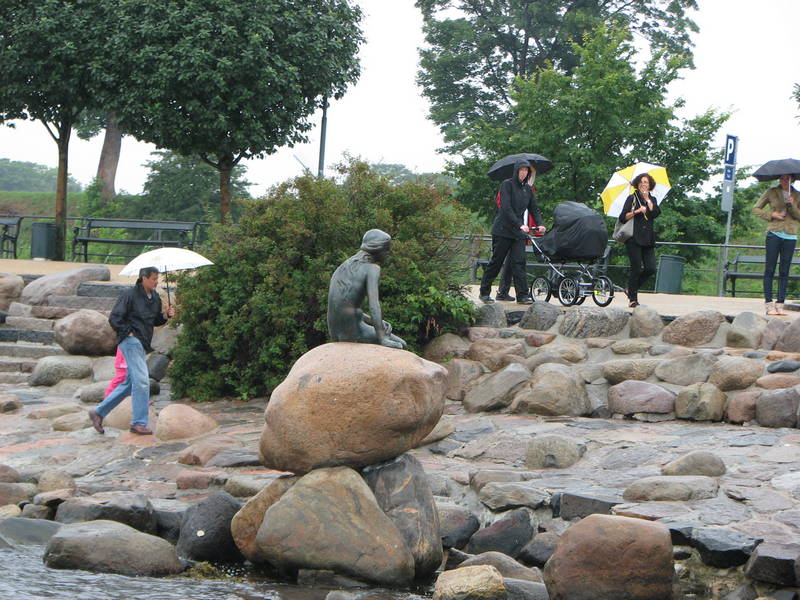
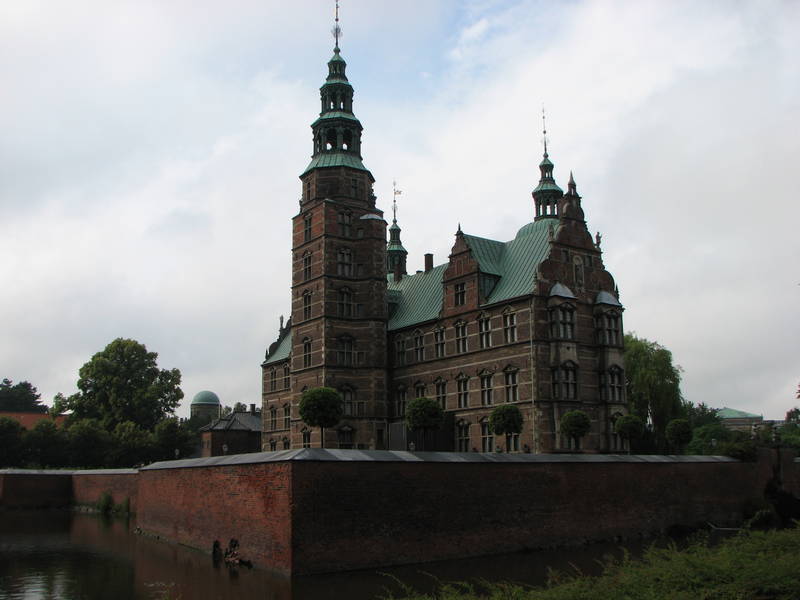
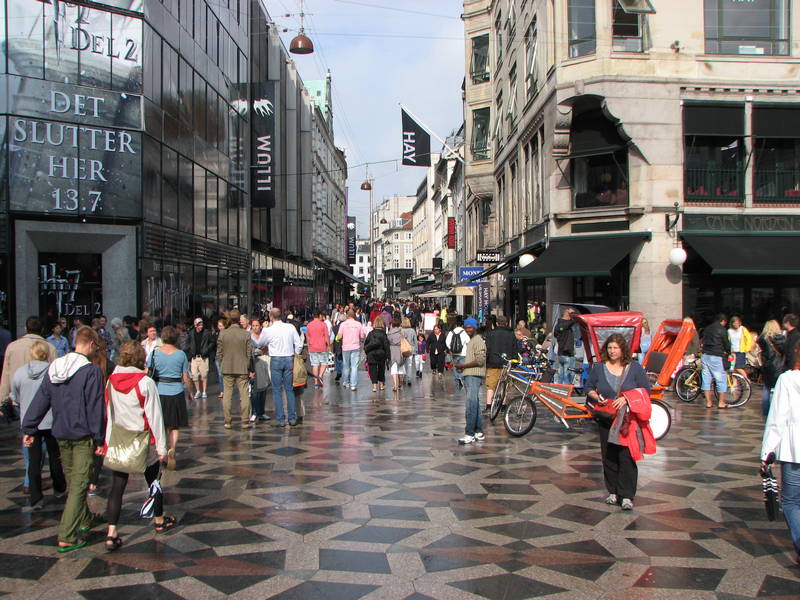

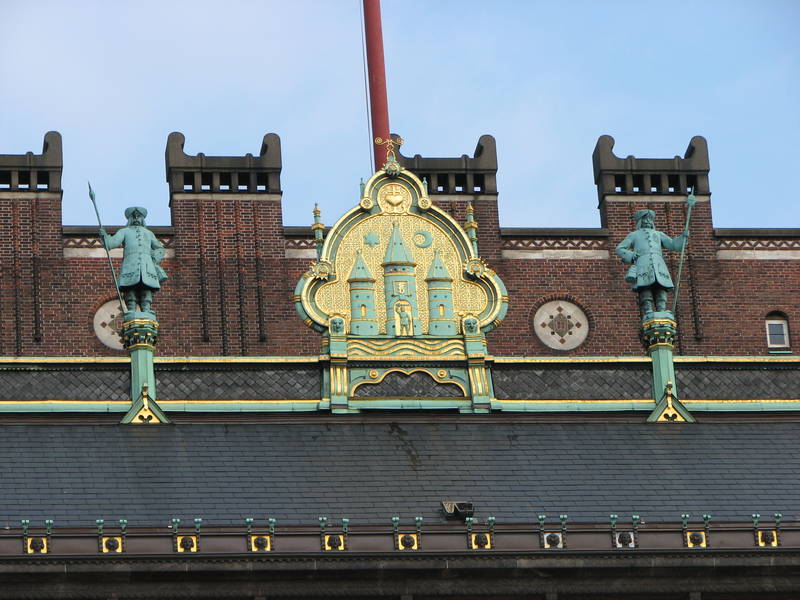
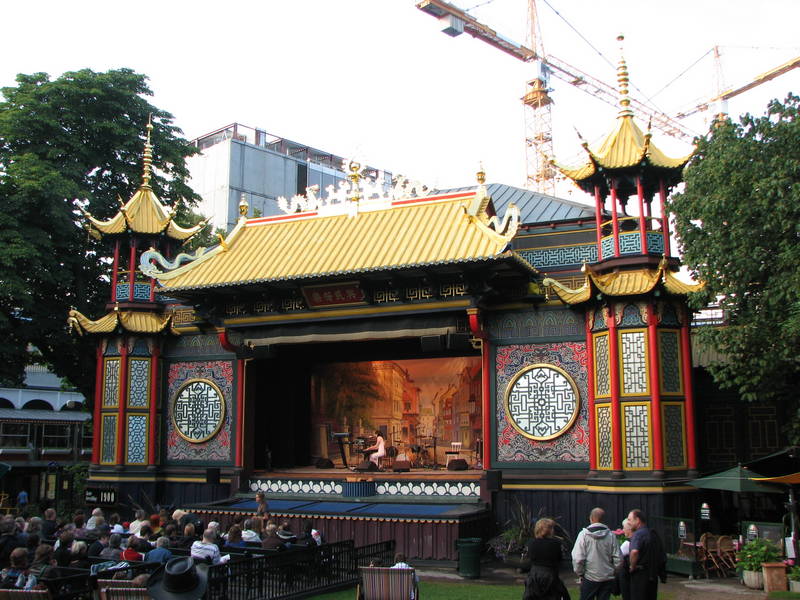
With no groceries with us, we searched out some fast food for breakfast. I don't think McDonald's breakfasts have caught on in Denmark as the McDonald's near the campground wasn't open in the morning. In fact, the next day in a McDonalds in Sweden we saw an illustrated pamphlet explaining what an egg McMuffin was. So we just continued riding, through a four km long tunnel and over the Oresund bridge. The 8 kilometres of bridge cost us motorcyclists 160 Kronor ($28) each. This was the first of many costly bridges, toll roads and ferries that we would encounter on the trip. Getting around Scandinavia by highway is expensive. At a little rest area in Malmo, I dug out the 160 Swedish Krona I had purchased in Canada, about $25. It barely paid for a couple of ham, brie and salmon sandwiches and coffee for breakfast at a rest area. Yikes. But we found a small town with a bank machine and replenished our Krona supply. We wanted to make good time so we headed north on the four-lane highway with speed limits of up to 120 kph, past Goteborg. But we didn't want to pay for toll highways if possible, so Ekke then set the GPS to avoid them. This took us to some quaint little side roads, which were a lot of fun. The narrow two-lane roads wound through cottage country beside sparkling lakes and green forests, and the curvy roads were a motorcyclist's playground. Every time we stopped we had big grins on our faces at the thrilling ride. My BMW F650 GS twin finally had a chance to show what it could do and it effortlessly carved through the turns, with little help from me. Crossing into Norway was a non-event, with just a small sign to mark the new country. A three-country day.

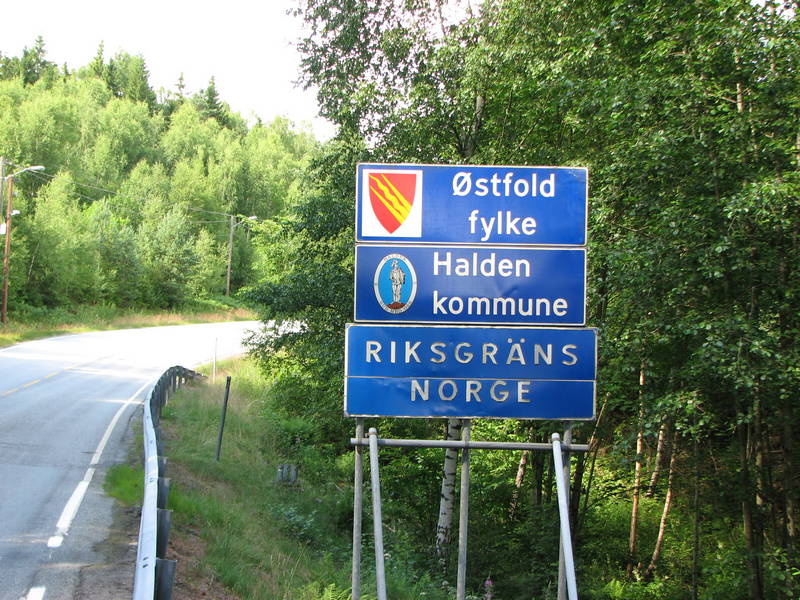
Ekke easily found the campground in Oslo, a big, crowded spot but with great views of the city and fjord. There were plenty of motorcyclists, and after supper we sat down and chatted with Richard from Southampton, England. He had been travelling for a couple of months, and regaled us with tales of his journey through Eastern Europe and Scandinavia. He had been to the Horizons Unlimited motorcycle world travellers meeting in Germany, which was very cool, as we help host the same meeting in Canada. www.horizonsunlimited.com
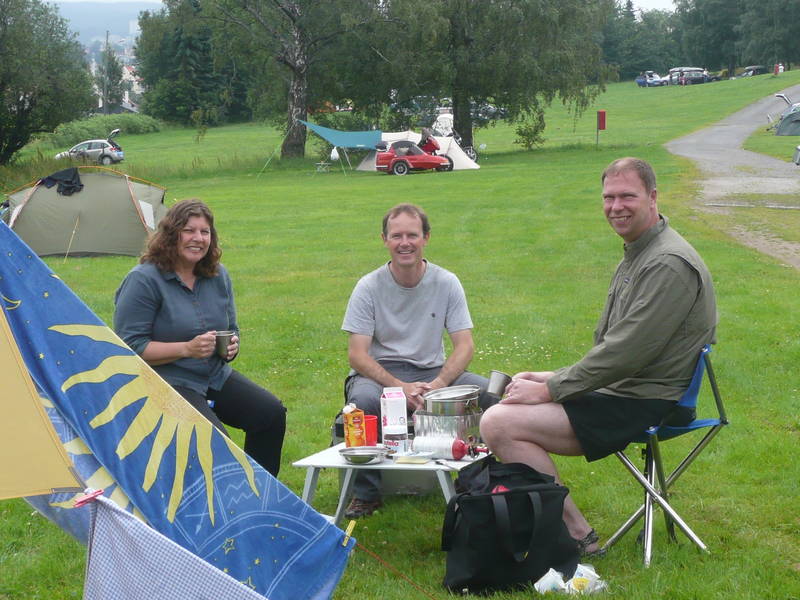
A day in Oslo was not enough to see all the sites but we tried our best. A sea-ferry took us over to three very different museums on the Bygdoy peninsula. Outside the Viking Ship Museum we were greeted by a statue of Helge and Anne Stine Ingstad, the very couple who discovered the L'Anse Meadows viking settlement in Newfoundland, which we had visited in 2008. What a great connection to our own country. A couple of the Viking ships were completely intact, and one could imagine the marauding that had been done in them. They had been excavated from under burial mounds, and contained plenty of artefacts, like silk clothing and carved wooden sleds. It was an eerie feeling seeing little leather booties, fully preserved, worn by the important woman or her slave girl, who had both been buried in the boat.
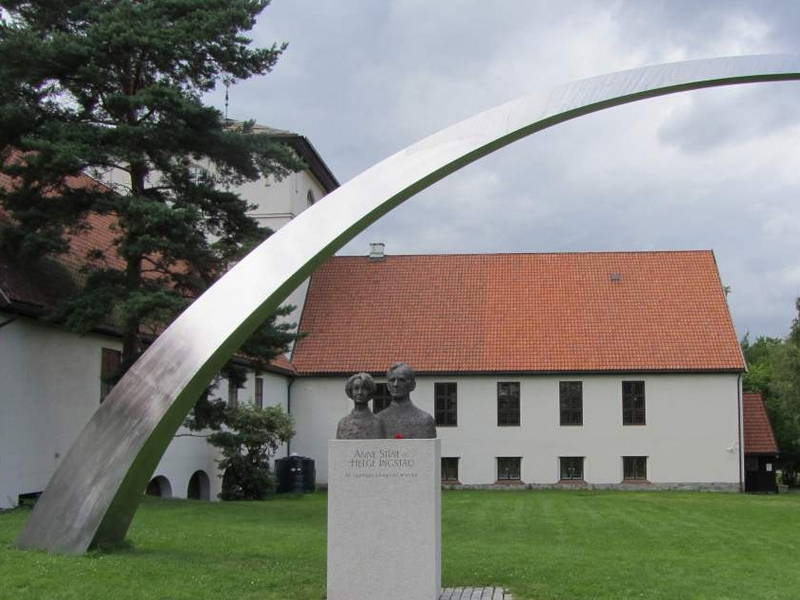

The Kontiki Museum contained replicas of Thor Heyerdahl's balsa wood and reed boats that had taken him across the Pacific and Indian oceans. He wanted to prove that ancient peoples could have survived long trips on the water. His documentary film about the expeditions had won an Oscar, which, to my delight, was on display.
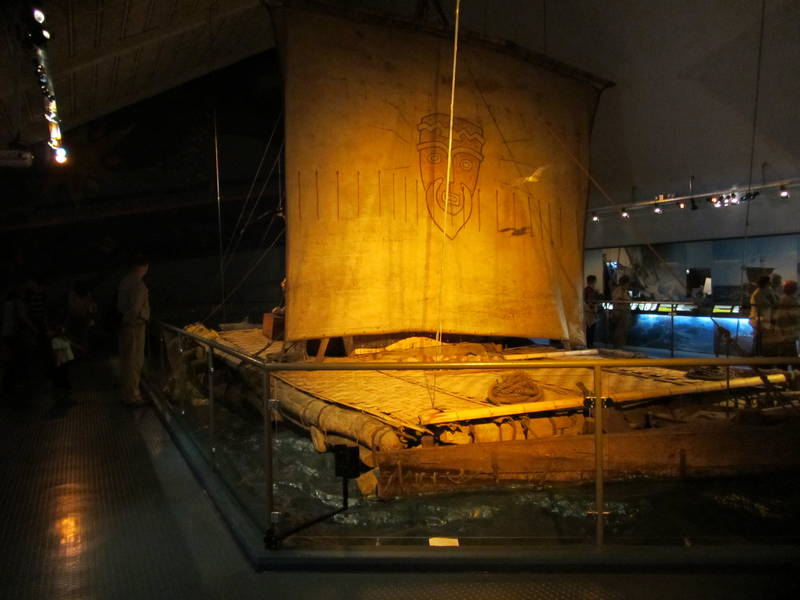
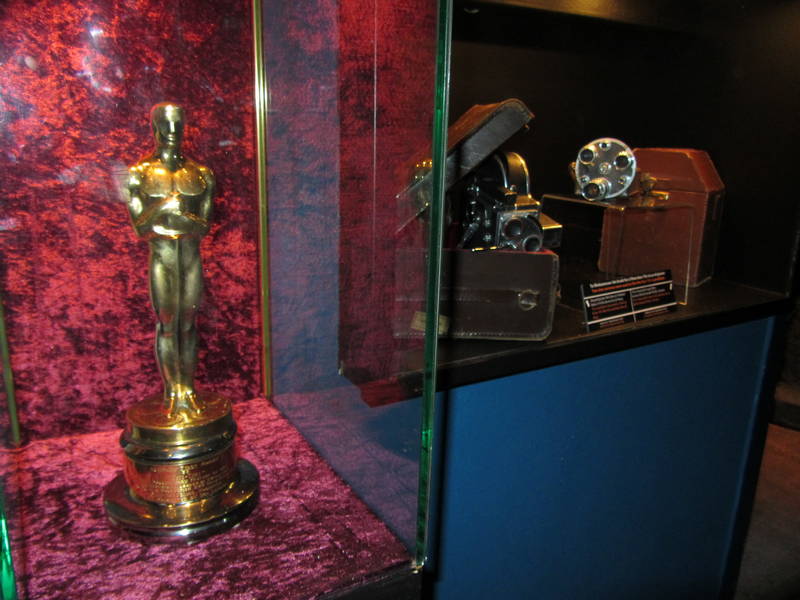
A totally different museum, the Fram, housed the ship that explorers Amundsen and Nansen had taken on polar expeditions. These Norwegians really got around.
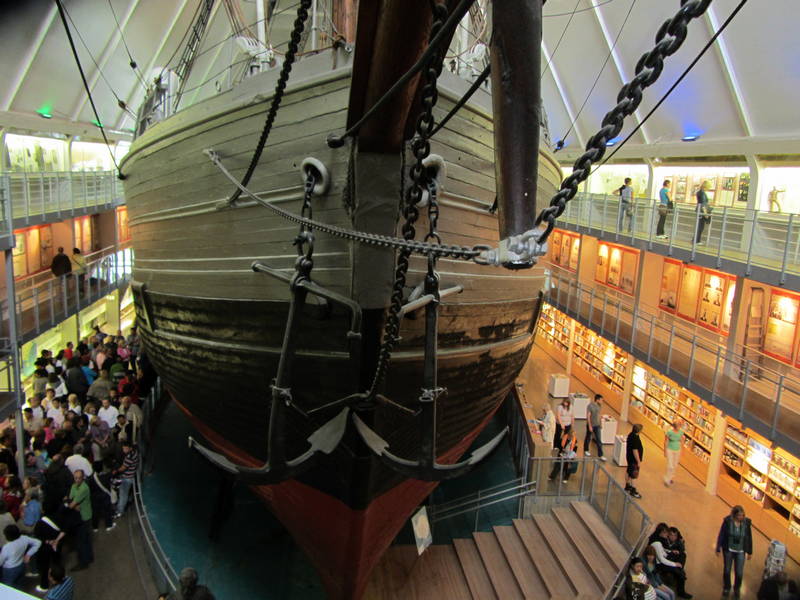
This would probably have been more dangerous if the bear wasn't on wheels
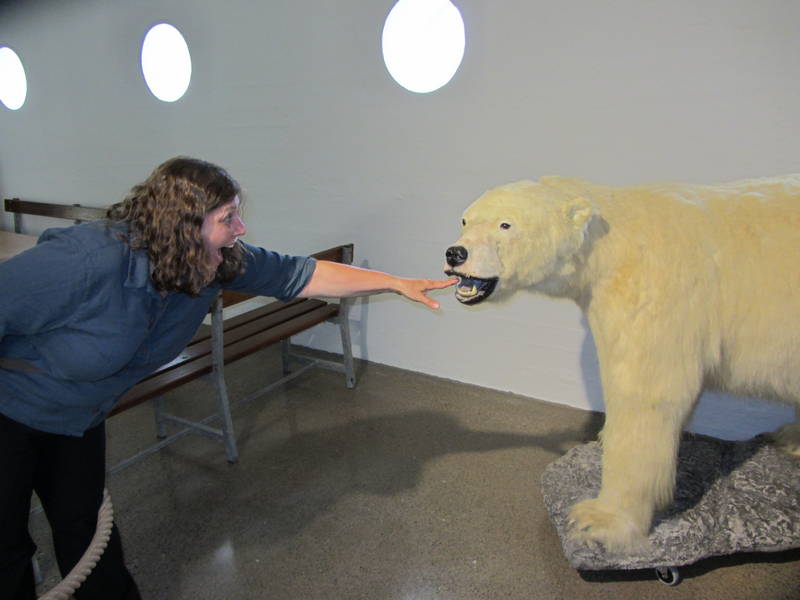
After a walk around the the fortress grounds, we were pretty much done for the day, but there were a few sites I did not want to miss. So, the next morning we made use of our still-valid 24 hour city bus ticket and stopped by the Opera House and City Hall, where the Nobel Peace Prize is awarded. Later, an old-style tram took us to Vigeland Park where the flowers and fountains were stunning in the bright sunshine. But the main attraction was the more than 200 bronze and granite sculptures of people, young and old, families or friends, all sizes and shapes, all completely nude.
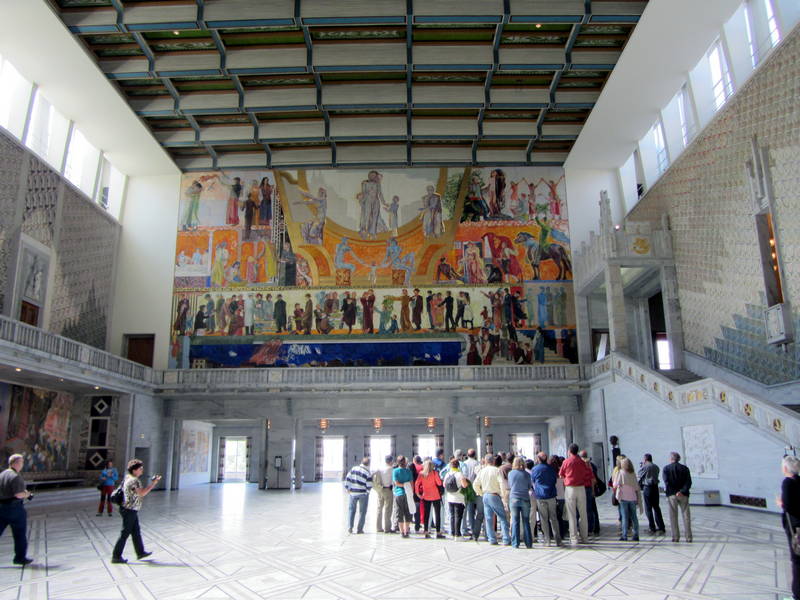
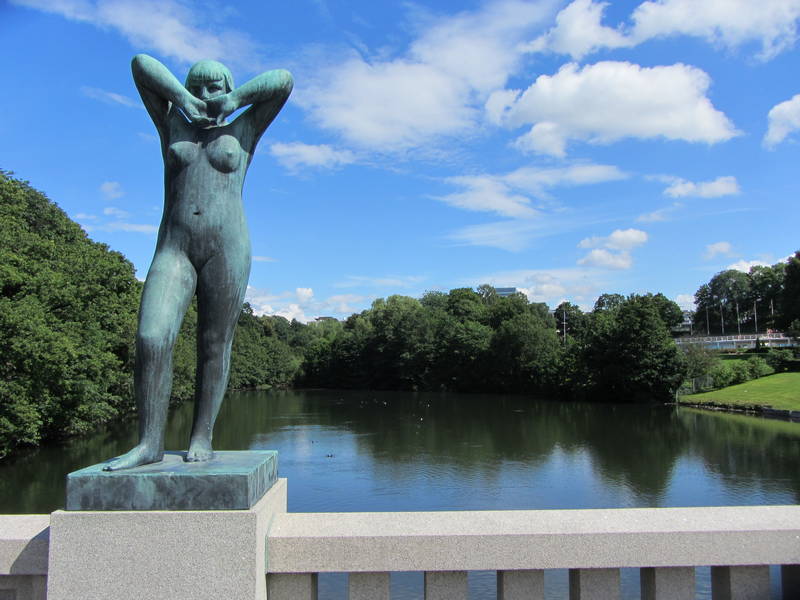
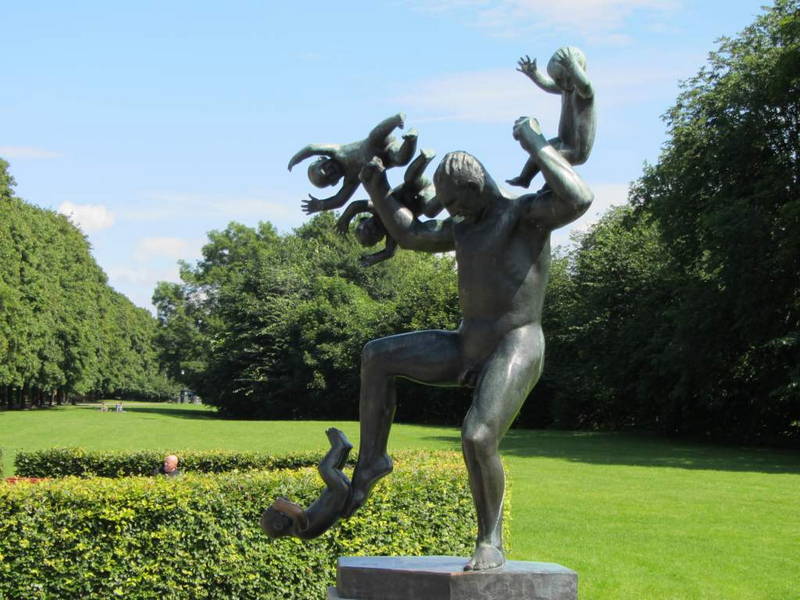
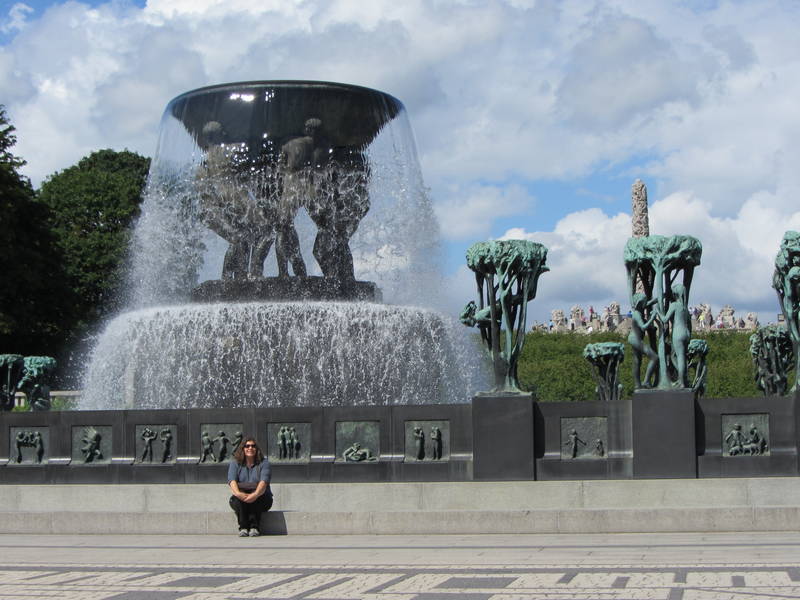
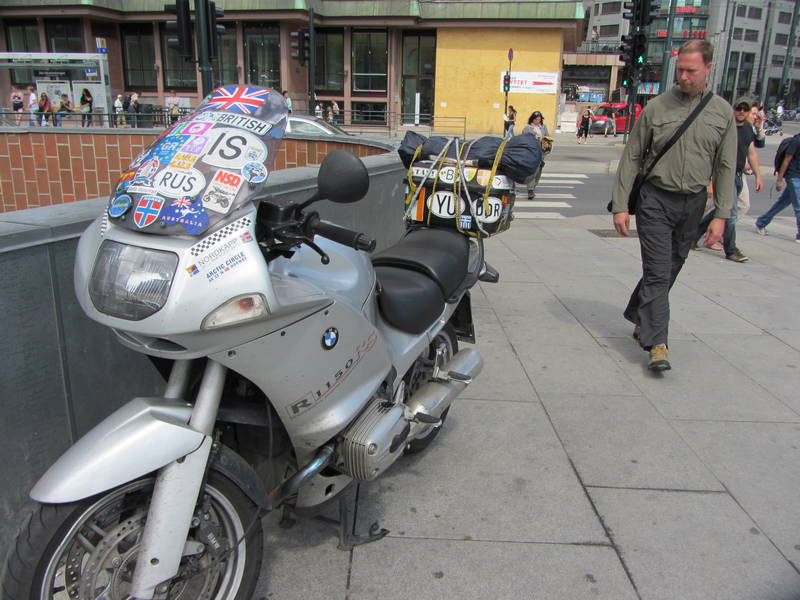
That afternoon at 3:00 PM, after packing up camp, we were able to get 150 kilometres of riding in through some scenic areas of southern Norway. This is very rustic and rocky countryside, with little 'Peggy's Cove-like' harbours and steep and winding roads. Our campground was tucked into a rocky area by the sea.
The next day we rounded the southernmost point of Norway and immediately felt the chill of the North Sea. I found myself very happy that I had packed my electric vest and down-filled jacket. After a pleasant day's ride along the coast, we settled in at the campground in Stavanger. The only grocery store nearby had a limited selection so we settled on a can of stew for supper. It tasted a bit strange to me, and I thought it was because the meat was processed and pressed into little chunks. We were then curious about what kind of meat it was, so we typed the names of the ingredients, all in Norwegian of course, into Google Translator on my iPhone. I thought that when we typed in 'rein' it would be some sort of pork product, but it turns out we had eaten...reindeer! Ewwww. After the initial shock, we were eventually able to joke about it. Is it good luck if you get the red meatball (i.e., Rudolph)? I think we are both on Santa's naughty list this year.
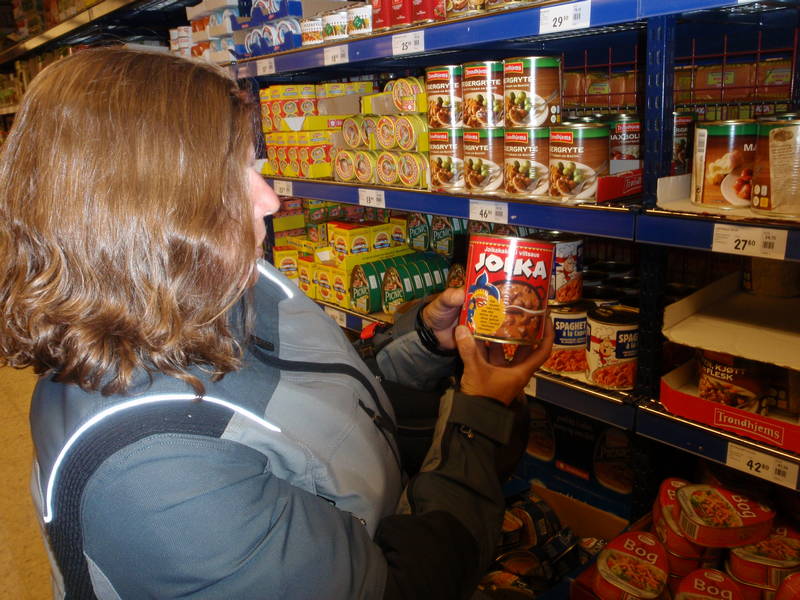
Ekke and I were still unsure as to whether we would spend our five weeks' vacation time riding the thousands of kilometres to the most northerly point in Europe, or just take it slow and enjoy riding around the central parts of Norway. So, for every day that we stopped to take time for sightseeing, it meant the former option was slipping away from us. It was very slow-going on these roads, with speed limits of 80 kph and a lot of traffic, which often came to a complete halt near heavily populated areas. At this rate we would have to ride every day, all day, to make it to Nordkapp. After much discussion, we convinced ourselves that it would probably be less crowded further north, and we could rack up a lot of kilometres each day up there. So, we took a day out to hike up to Preikestolen, a place that we were, looking back, so happy not to have missed. The trailhead was 25 kilometres from Stavanger, on winding single-lane roads passing by idyllic farms with white, fluffy sheep grazing in the fields. On the 15 minute ferry ride (45 Kroner or $8 each), we chatted with a couple from Finland, who were vacationing on their BMW K1200GT. Just as we were riding off, I was in a bit of a panic as I noticed my key was not in the ignition and I had visions of holding up the Finns and all the other ferry traffic behind me. Luckily there was a bit of a delay and I whipped off my gloves and just dug the key out of my pocket in time. Phew.
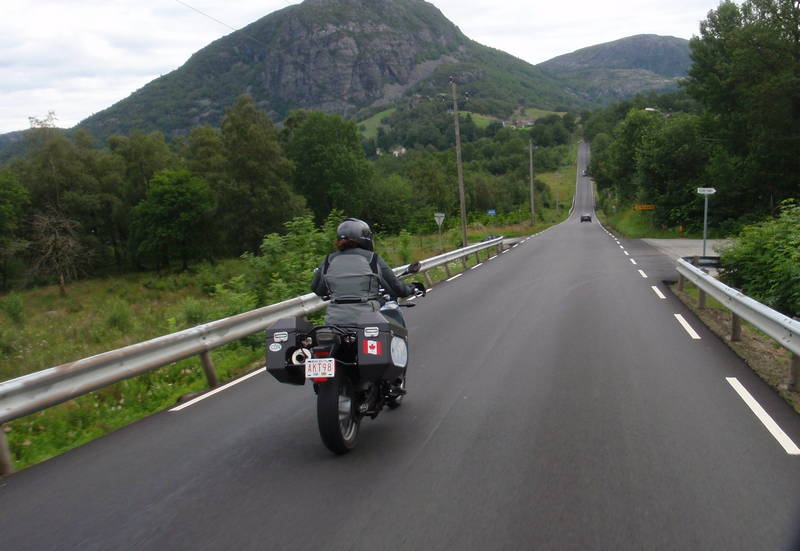
Being on motorcycles in Europe definitely has advantages, and we found motorcycle parking spots very close to the start of the trail. Other vehicles had to park at least a kilometre away from the trailhead. The guidebook said it was a 2-hour hike up to Preikestolen (Pulpit Rock). We were stunned by the amount of tourists from many different parts of the world, in various forms of footwear ranging from hiking boots to flimsy sandals. The steady queue of people inching their way up the steep trail reminded me of that classic picture of Klondike gold miners climbing the icy Golden Stairs on their way to the Yukon. We climbed up and up, over rocky bluffs, past little lakes. As we rounded the final corner, we were met with an unbelievable sight: A 600 metre tall cliff, perfectly flat on top, with sheer drops on three sides down to Lysefjord, and what must have been 200 people sitting on or near it. Ekke and I caught our breath as we watched little kids running around on top. People were sitting on the edge with their feet dangling over the edge. I attempted to slither carefully on my belly toward the edge, but alas, was too scared to look over once I got there. I climbed up a cliff to get some better photos but was literally shaking on the climb down, the drop-off was so scary. Our guidebook said that guardrails were not put up because it would spoil the scenery, and apparently no one has ever accidentally gone over the edge. Lunchtime was interesting as the people sitting near us whipped out a campstove and began making omelettes for the whole family. Our sandwiches looked a little boring now.
Preferred parking at the trail head
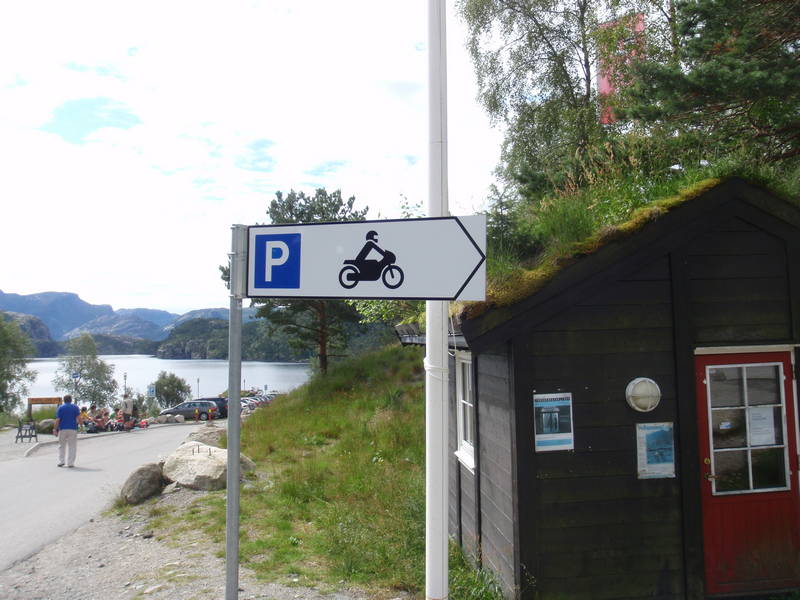
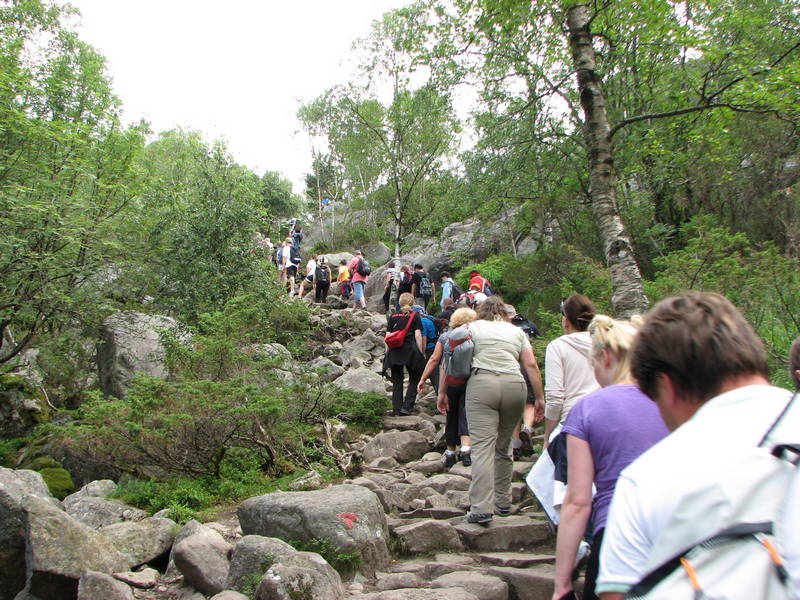
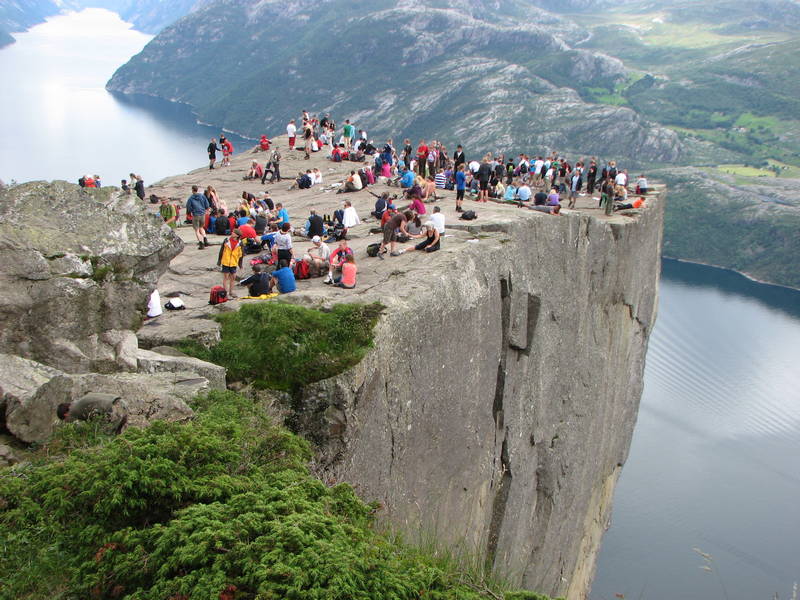
Audrey crawls out the edge as Norwegian children run and play on the Preikestolen
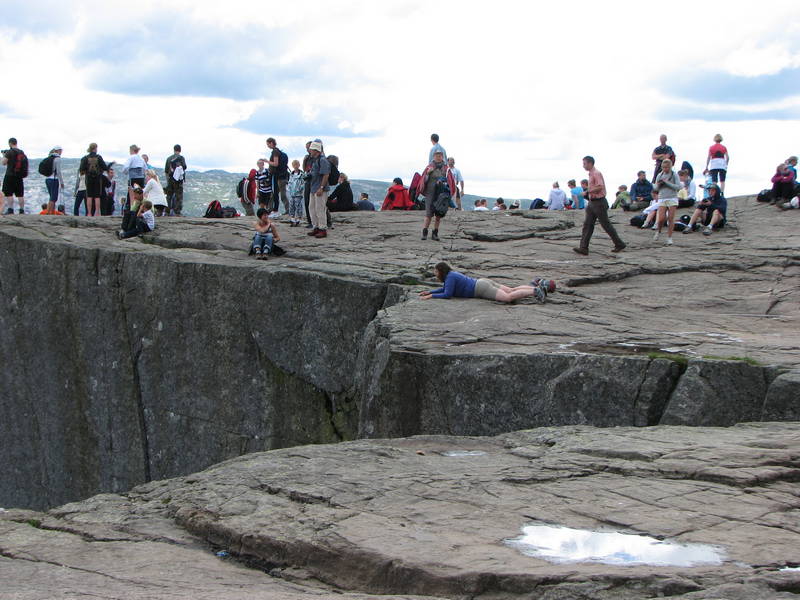
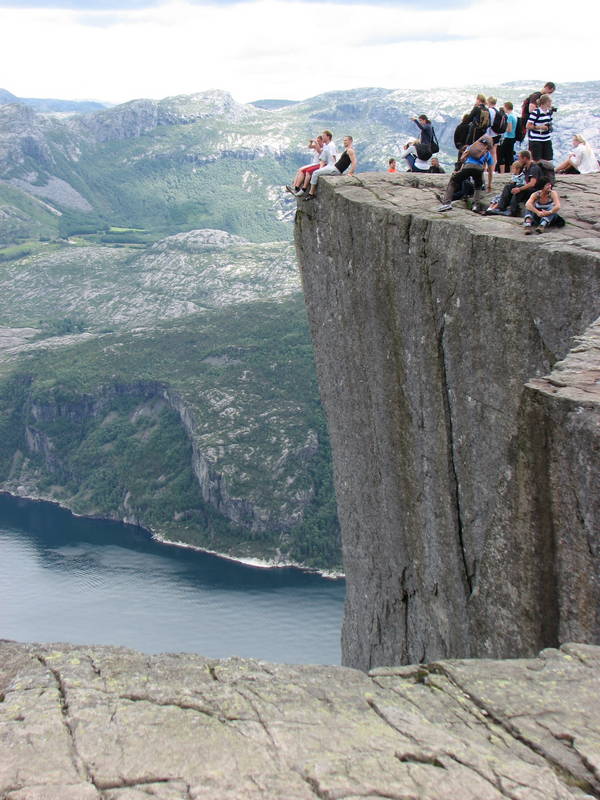
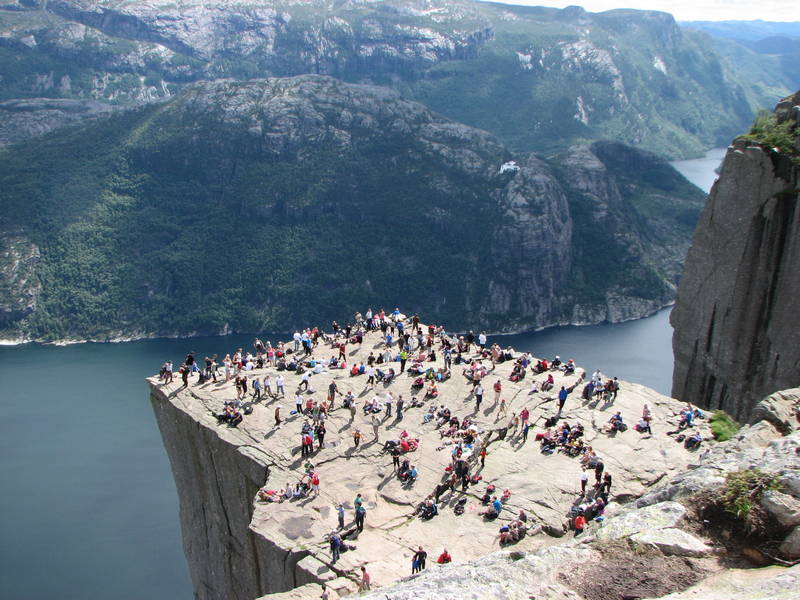
Our only chance to see Stavanger itself was that evening, so we rode right to the town centre, parked on a nearby sidewalk, locked up the bikes, and enjoyed a stroll around the Gamla stan, or old town. It was still bright and sunny along the gorgeous harbour-front and we marvelled at the picturesque scene. The medieval town was chock-a-block with cobble-stoned streets and quaint architecture, and we dragged our hike-weary bodies around, farther than we thought we ever would. The oil museum was evidence of the importance of that natural resource here, and a lot of companies, some from Canada, are based in Stavanger.
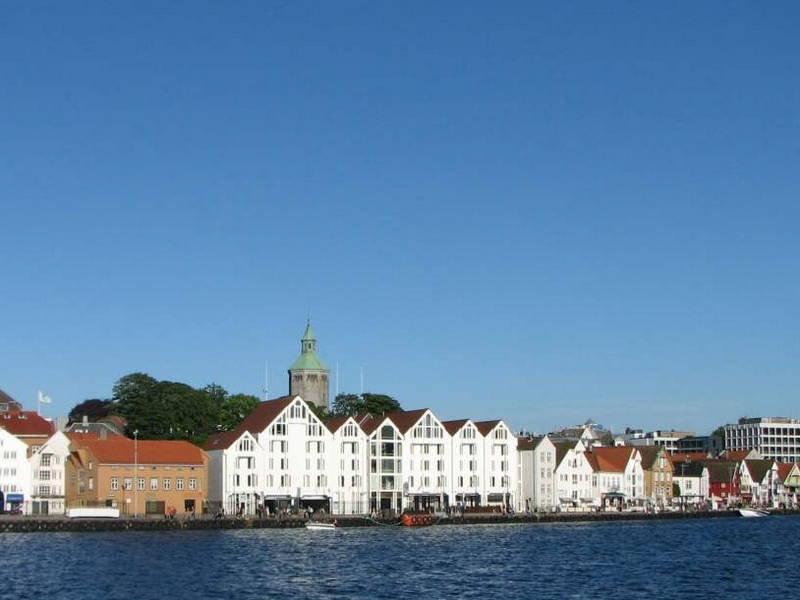
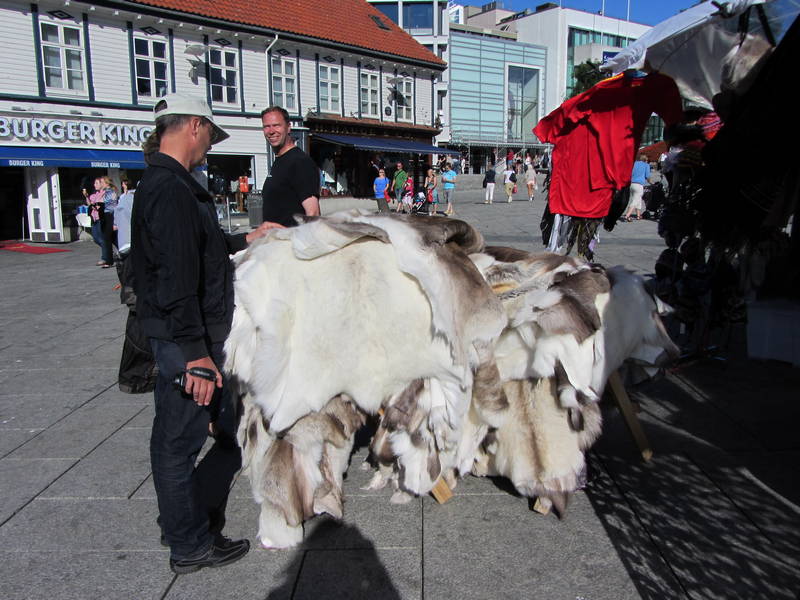
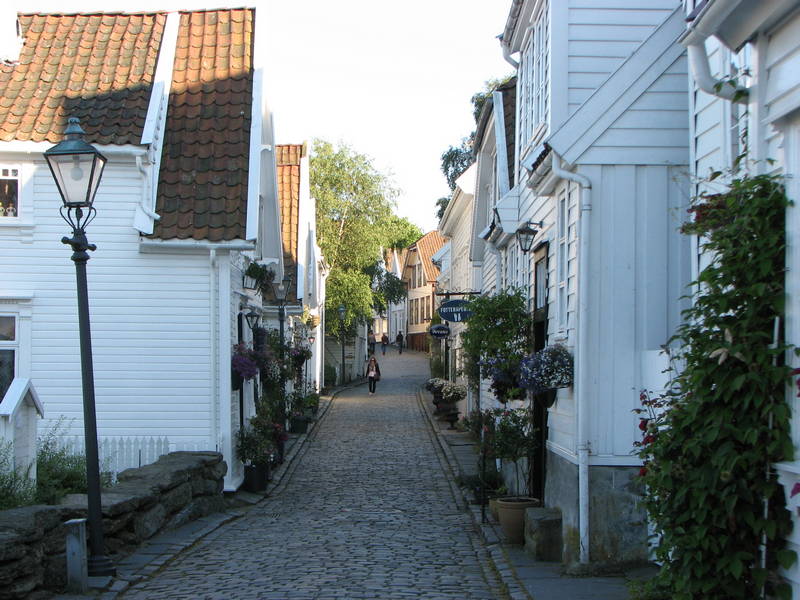
Cat on a road
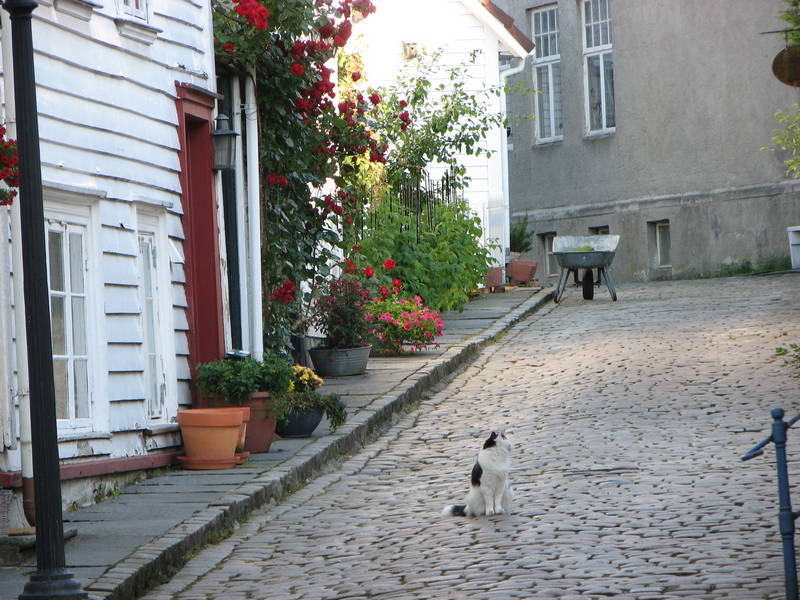
On the Stavangerfjord ferry the next day, we had a bit of excitement. I got down to the bikes a bit late. Ekke was down there waiting and ready to go, me nowhere to be seen. He was very surprised when all of a sudden the floor opened up and cars started driving up a ramp right behind him. I ran down the stairs, found my key, threw on my helmet, no time for earplugs or gloves, and rode off the ferry. Once again, I just made it without holding up hundreds of cars behind me. The bad part about not getting the earplugs in is that we had to pull over and put them in later, which meant that much of the ferry traffic got by us, making for slow going on the next curvy set of roads. But we eventually made it to Kokstad which we couldn't miss as Ekke's last name is Kok. 'Stad' means city. This was our second visit to a 'Kokstad', the first in South Africa in 2008. Now, we were north of 60. Lone Camping near Bergen was easy to find with the GPS. Campgrounds in Scandinavia are quite civilized, with modern washroom and laundry facilities. But most don't have a table and chairs, so we were glad that we had brought our own with us from Canada.
238 Kroner for this ferry meal = $40 Cdn

Audrey taking a picture of Ekke who is parked in front of the ramp for the vehicles from below deck
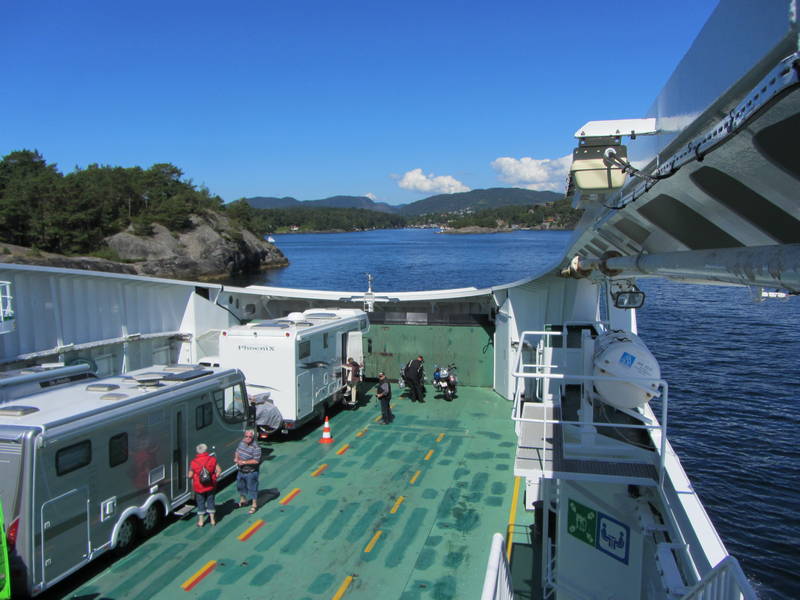
The ramp for the vehicles opens up as Audrey runs back to the bike
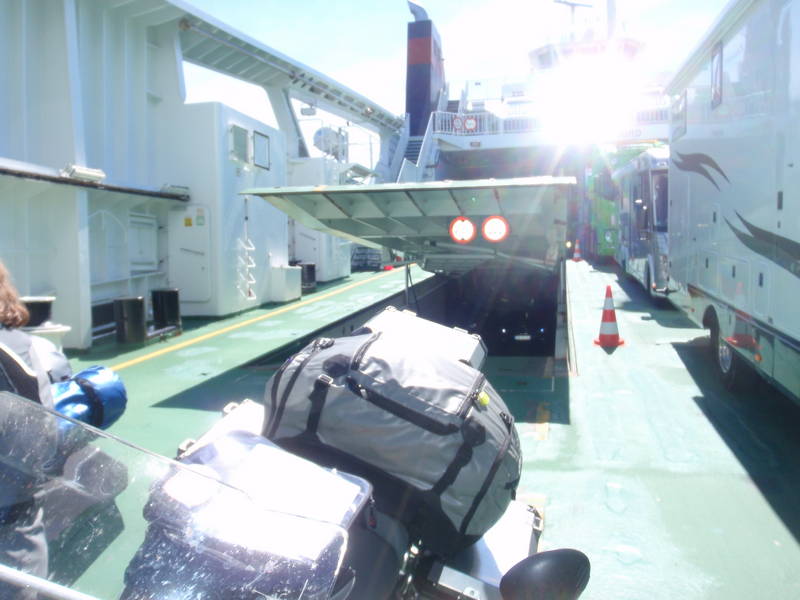
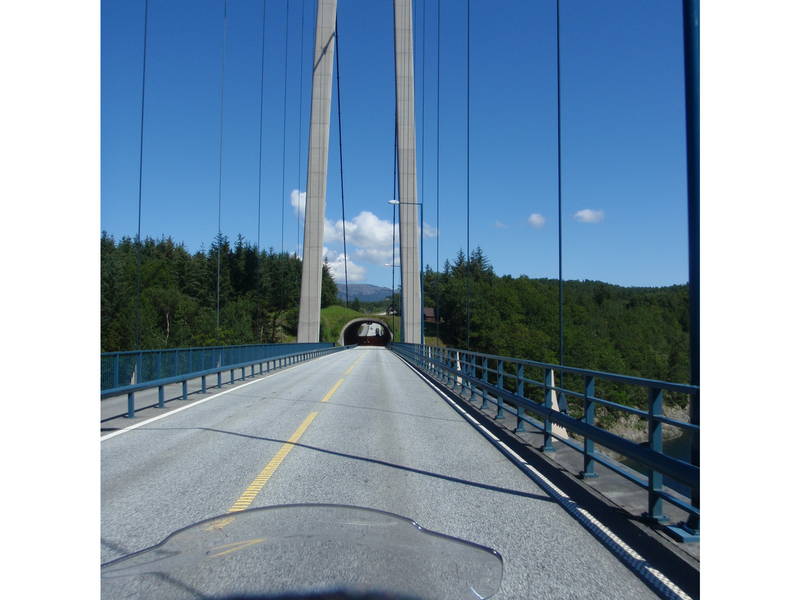
Heading south to Kokstad
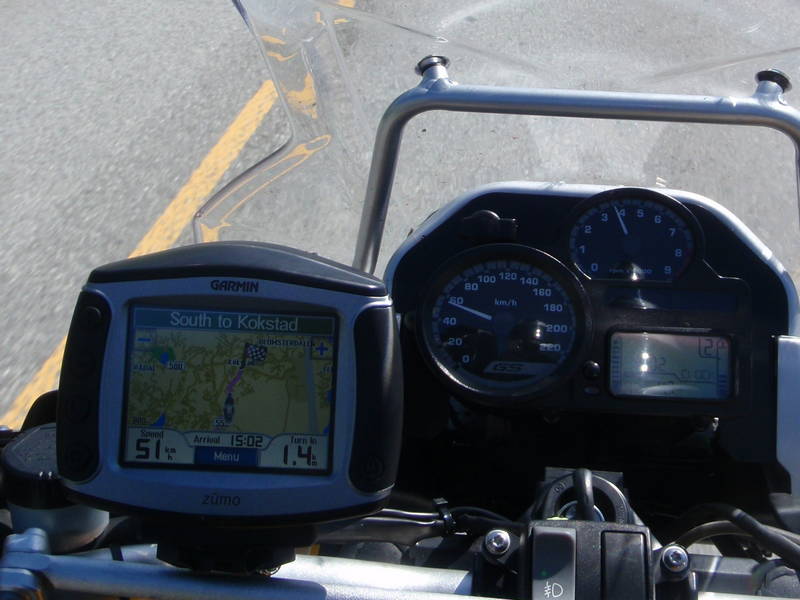
Arriving "home"
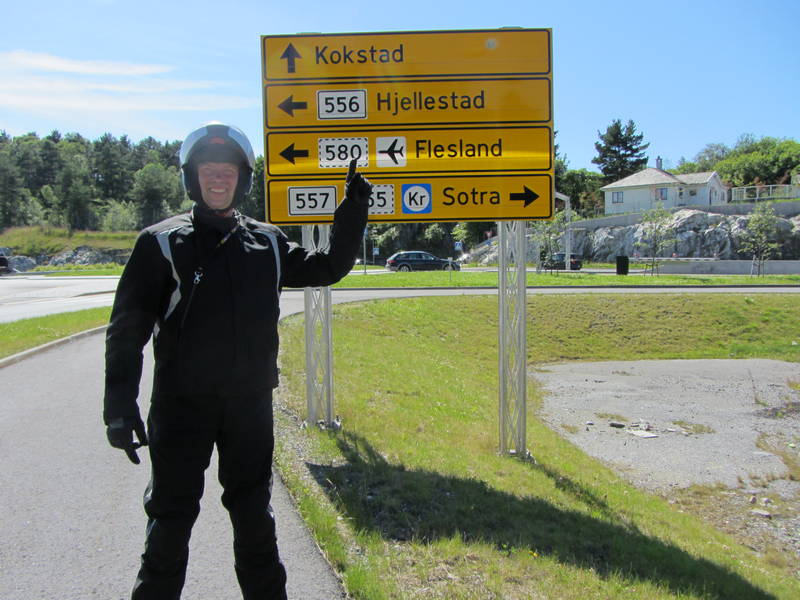
Camping near Bergen

Bergen is legendary for having an average of 275 days of rain a year, so we felt very fortunate to enjoy a bright, sunny day there. It was easy to take public transport into the city and leave the bikes parked safely at the campground. The description of fishcakes in our guidebook made them sound so appealing that we headed straight for the fish market to try some. They were absolutely delicious, and a real bargain compared to other items, probably because they were 1/10 fish and 9/10 tapioca. For lunch, Ekke got a lovely salmon sandwich. I bought a skewer of 5 grilled shrimp for 100 kroner and only later realized that I had paid about $20, or $4 per shrimp. Norway isn't cheap.
Expensive shrimp
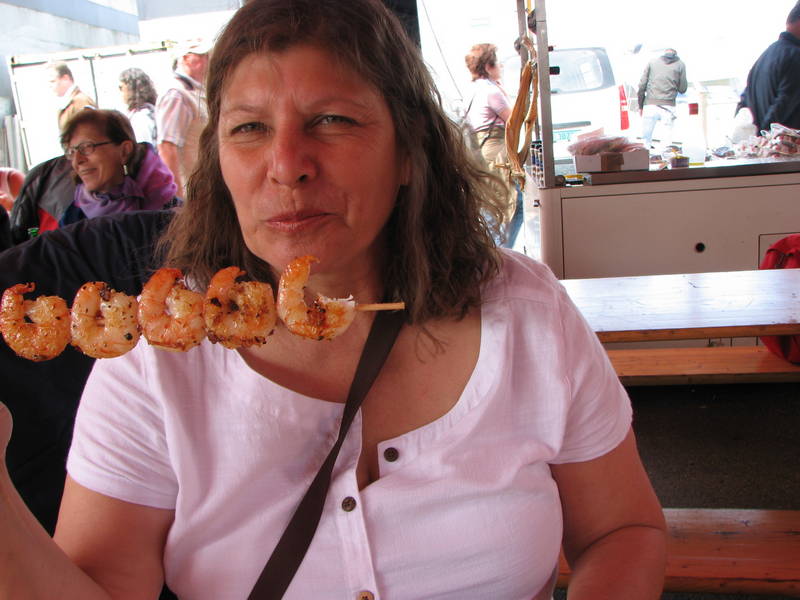
As we walked along the harbour, we stared in awe at the wooden buildings of Bryggen, the city's old town. The World Heritage Site is beautifully restored, and each warehouse front has its own unique characteristics. The sidewalk cafes were just begging to be visited, and we happily paid $20 for coffee, tea, a pastry, and some great ambiance. At Bergen Castle, Rosenkrantz Tower's spiral stone staircases were fun to explore, from dungeon to tower. At nearby Haakon's Hall, a medieval feast structure, one could just imagine the royal celebrating that must have gone on there. We pretty much had the place to ourselves and just sat inside the stone hall for ages, listening to the haunting music, reminiscent of what was played in medieval times. Our day finished with a ride up the funicular, a slanted train on the side of the mountain, with sweeping views of Bergen and the harbour. While up there, we were approached by a tourism employee and asked to do a survey about our trip and how safe we felt in Norway. Did we worry about mad cow disease or SARS, or have any other concerns? We got the guy to take our picture, with Bergen in the background.
Bryggen
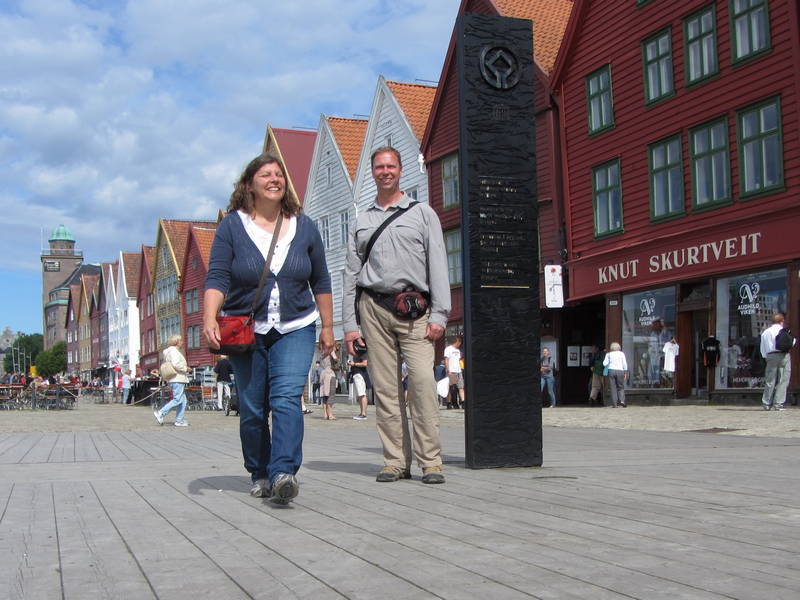
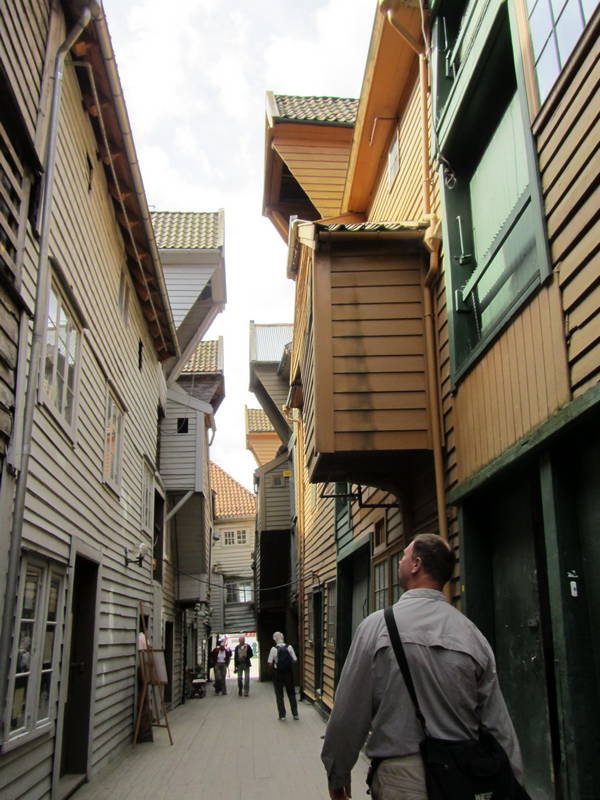
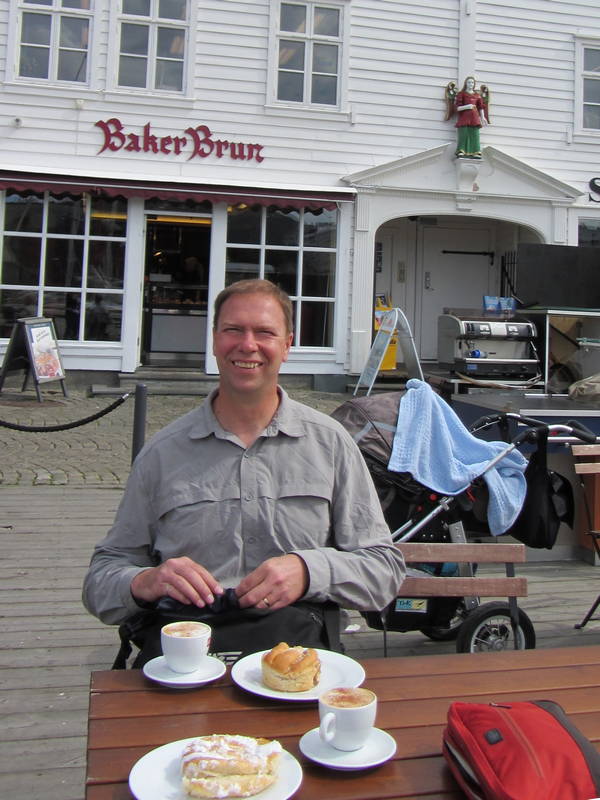
We didn't try the whale sausage
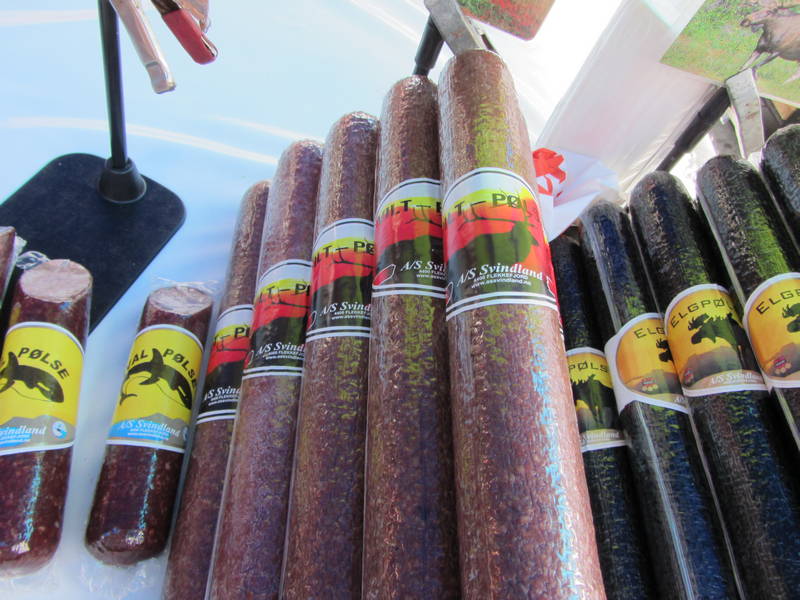
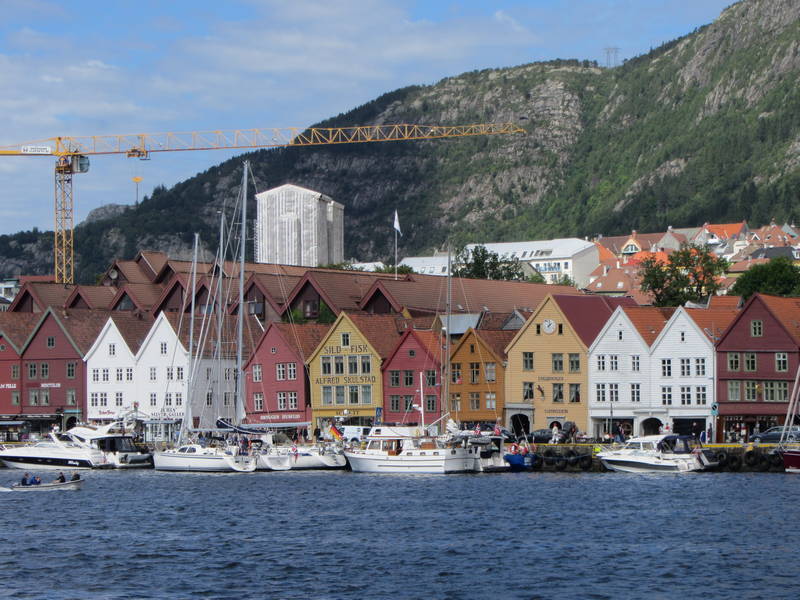
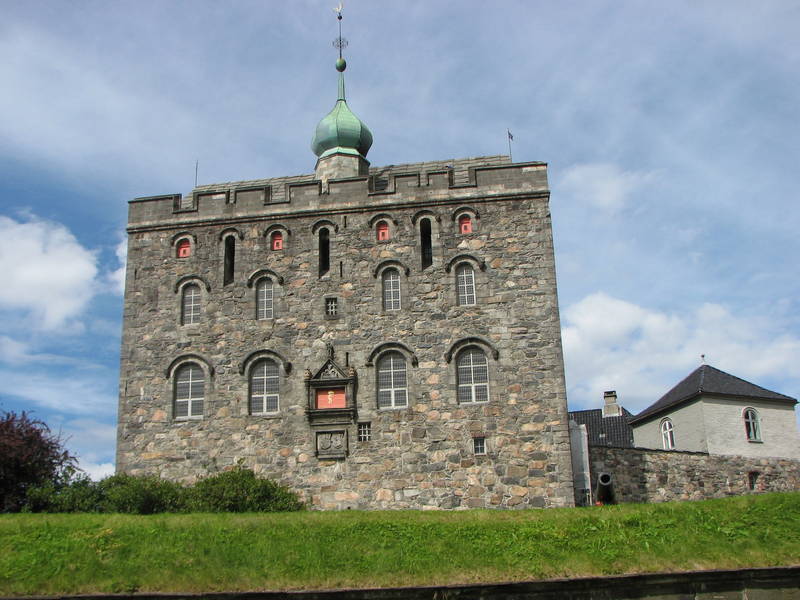
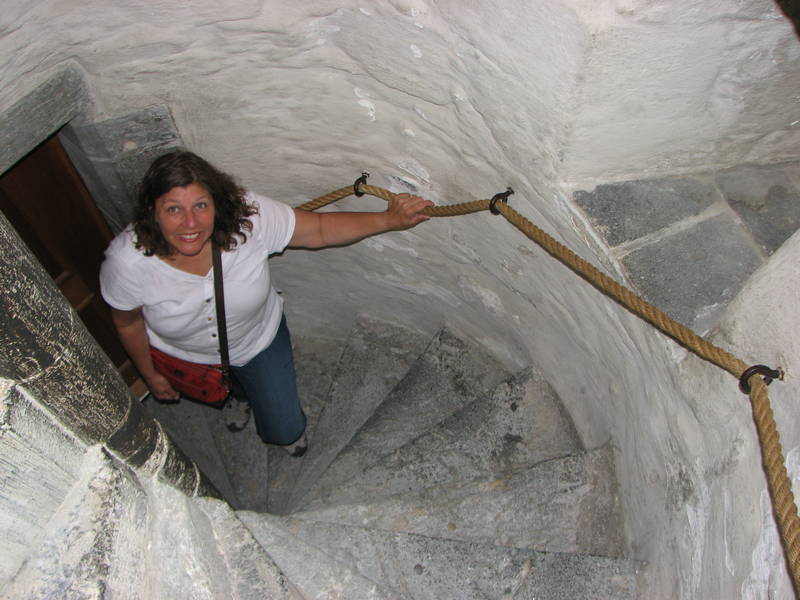

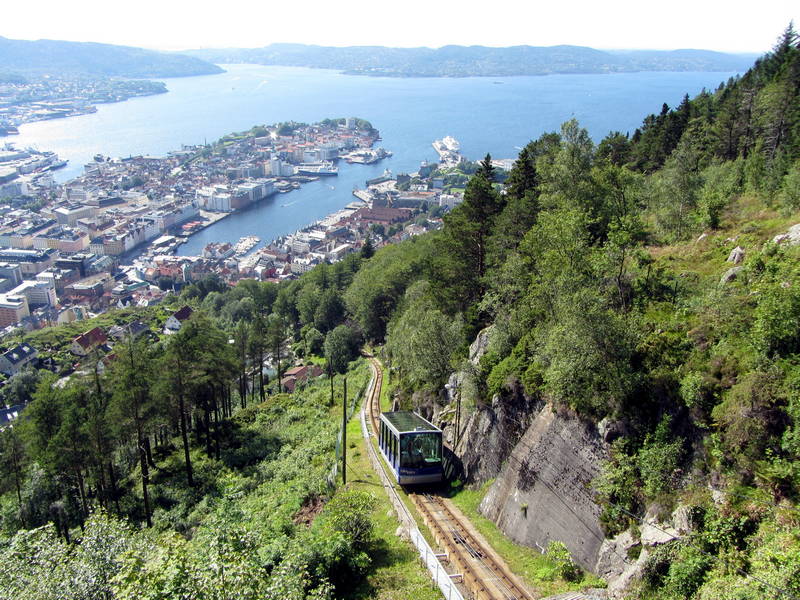
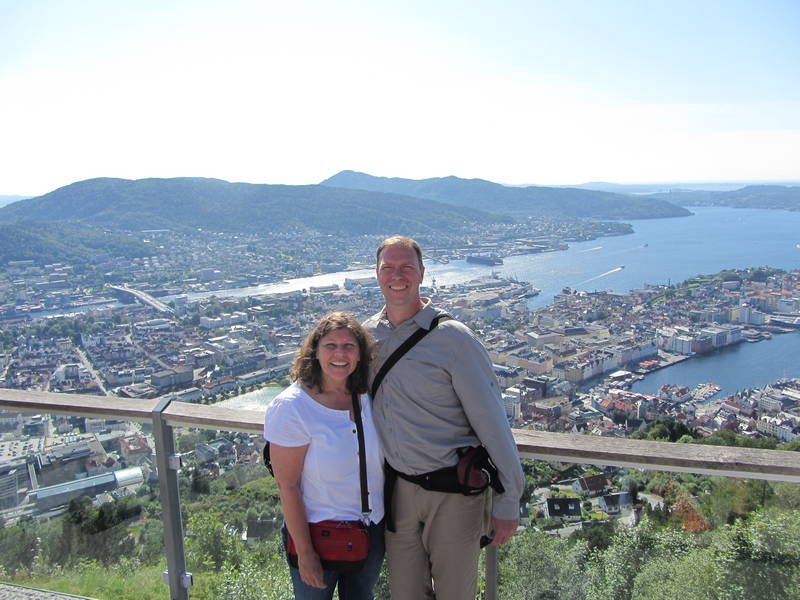
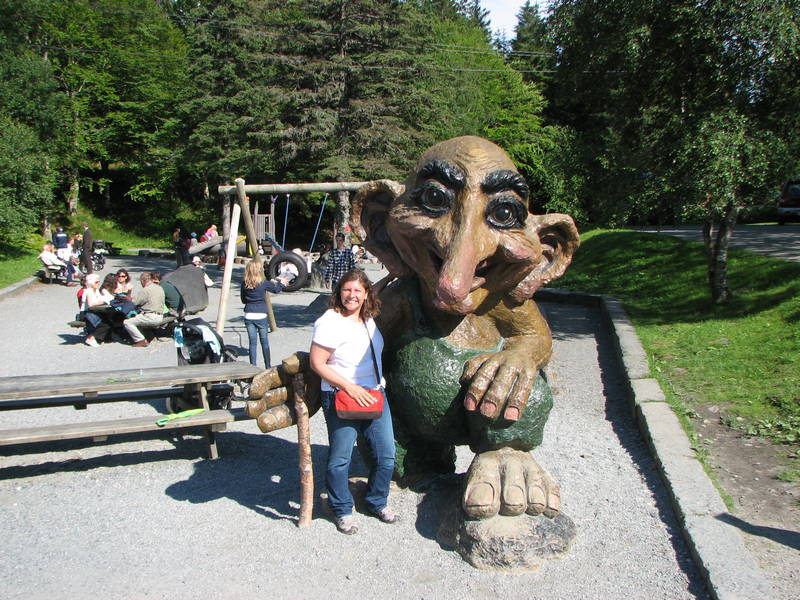
The bikes were all packed up and ready to go the next day, but when Ekke pressed the start button on his 1200 GS Adventure, nothing happened. We knew his battery must be dead as we had been charging my phone all night via his BMW plug. I had visions of push-starting the big bike, (flashback to Africa, push-starting each others' motorcycles), when he reminded me that he had received motorcycle booster cables for his birthday from his folks. I started tearing up with joy. It was almost too easy attaching the cables to my bike, starting it up, and then pressing his start button. The engine roared to life. We were soon on our way and we had discovered a new advantage to having two motorcycles.

Ekke and I were really interested in riding the whole length of the biggest fjord in Norway, Sognefjord. At 204 kilometres long and 1308 metres deep, it was pretty impressive and took us all day to ride. The narrow road wound gently beside the sparkling, blue water of the fjord, often darting into tunnels or passing over bridges. Once we had set up camp in a lovely orchard in Sogndal, we rode around the end of the fjord to have a look at our first Stave church, in Kaupanger. In anticipation, we rode down a small hill, rounded the last corner, came out of the trees, and were awestruck by the beautiful structure. Stave churches of Norway were built in the middle ages. Wooden posts, or 'staves' were used in their construction, hence the name. Out of 1000 original churches, only 25 remain, several of them still in use. Kaupanger stave church was beautiful and, for a wooden church, a lot bigger than I thought it would be.
Lunch break
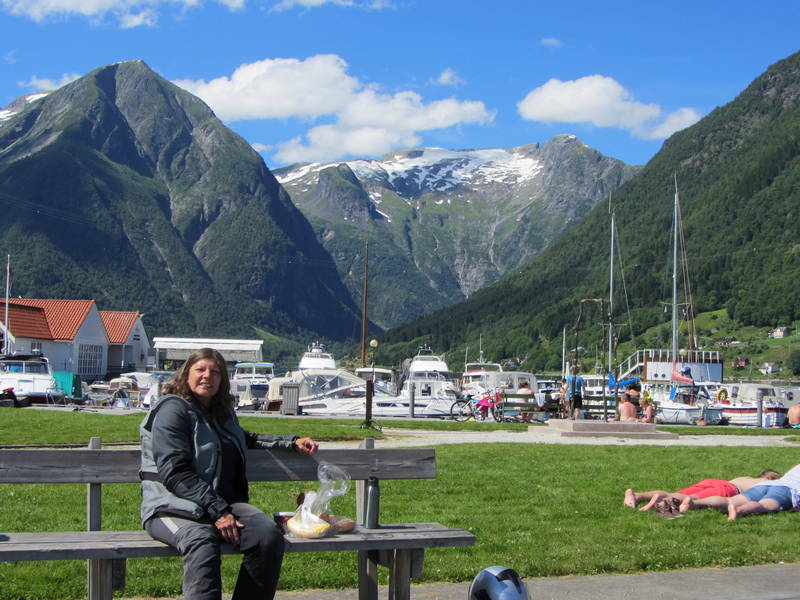
Viking burial mound

Our first stave church
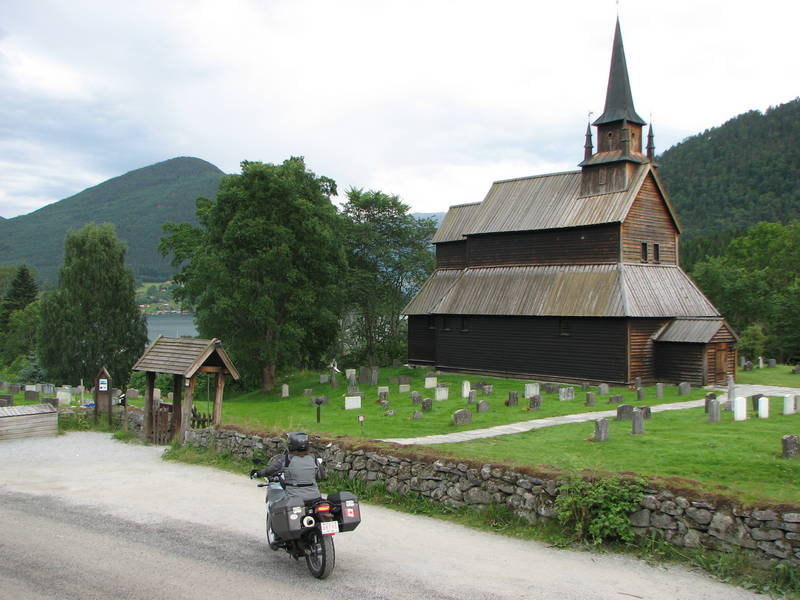
One arm of Songefjord, Naerofjord, is a World Heritage Site and has a ferry going the length of it. So the next day we got up early, rode to the ferry station and boarded the boat for our very own fjord cruise. The narrow fjord was flanked by rugged, steep cliffs and waterfalls tumbling from great heights. Information about the geography and history of the area poured out of a loudspeaker. We loved just sitting there, floating along, watching the scenery go by.
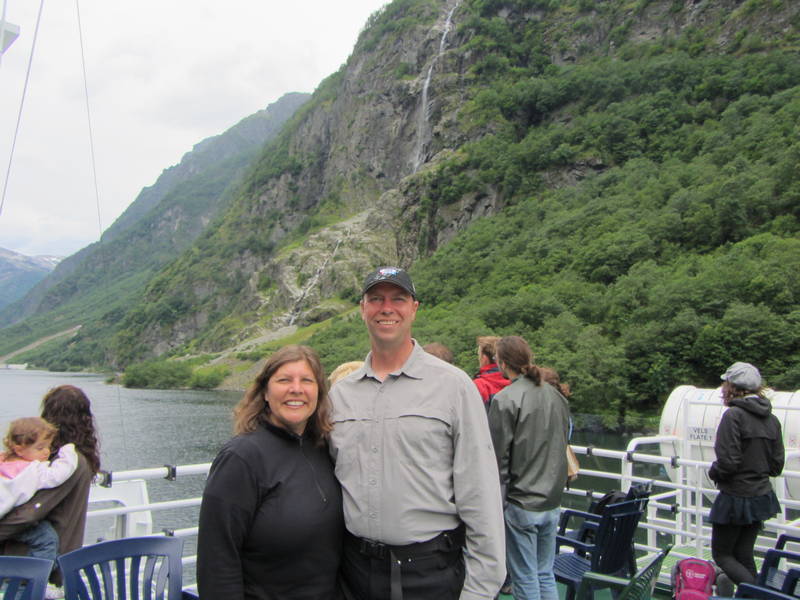
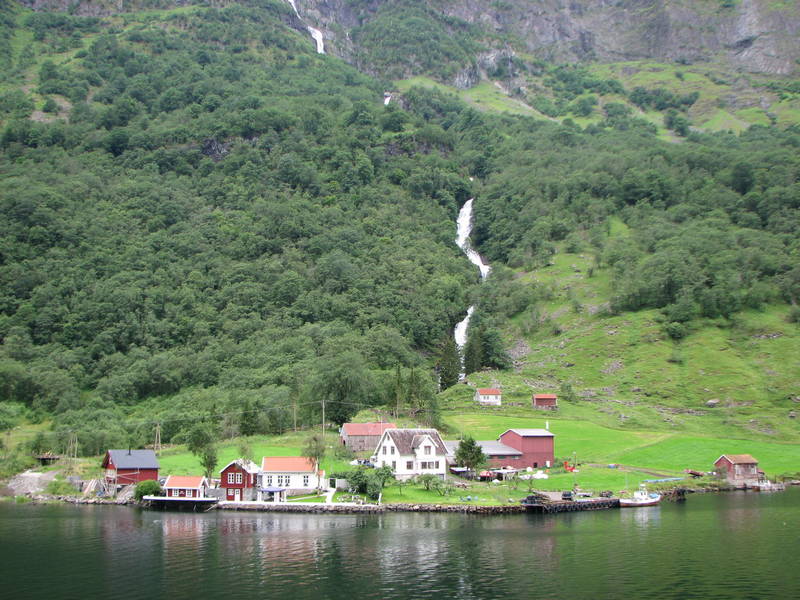
The boat docked at Gudvangen where we really lucked out. A Viking festival, complete with period costumes and tents, was in full swing. It's always great to see the locals trying to preserve the past in interesting ways. Later, we rode to Borgund Stave Church, a bit out of our way, but well worth the detour. It was such a quaint-looking structure, I half expected Hansel and Gretel to walk out the front door. It had many intricate carvings of abstract designs and wildlife. Ekke and I amused ourselves by trying to get photos of each other riding our motorcycles in front of the stave church, in the gently-falling rain.
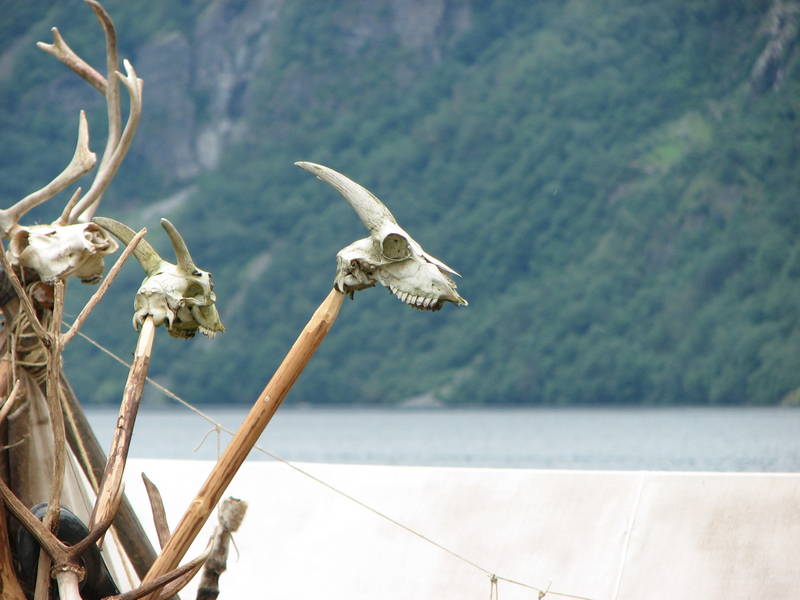
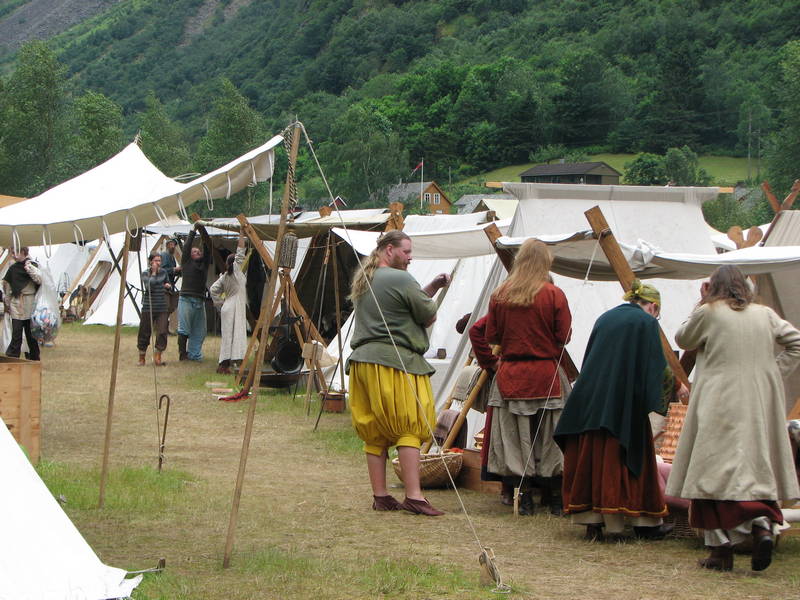
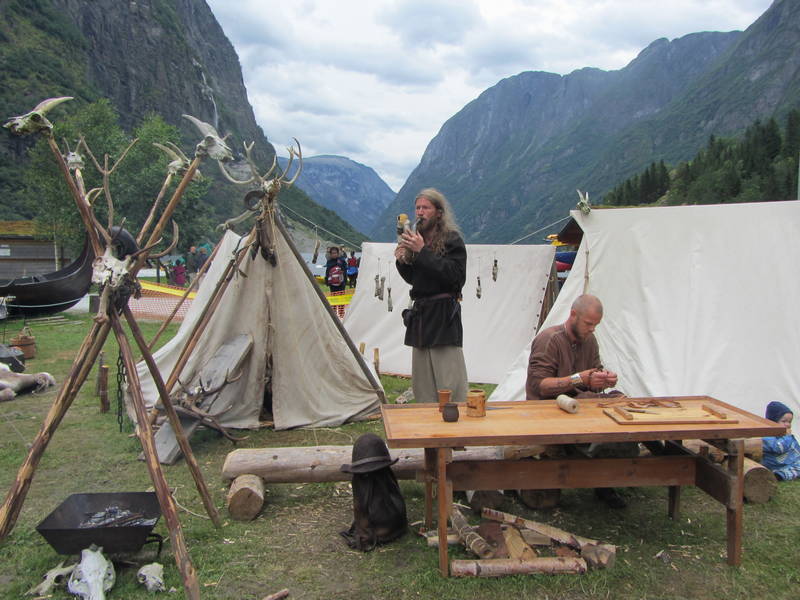
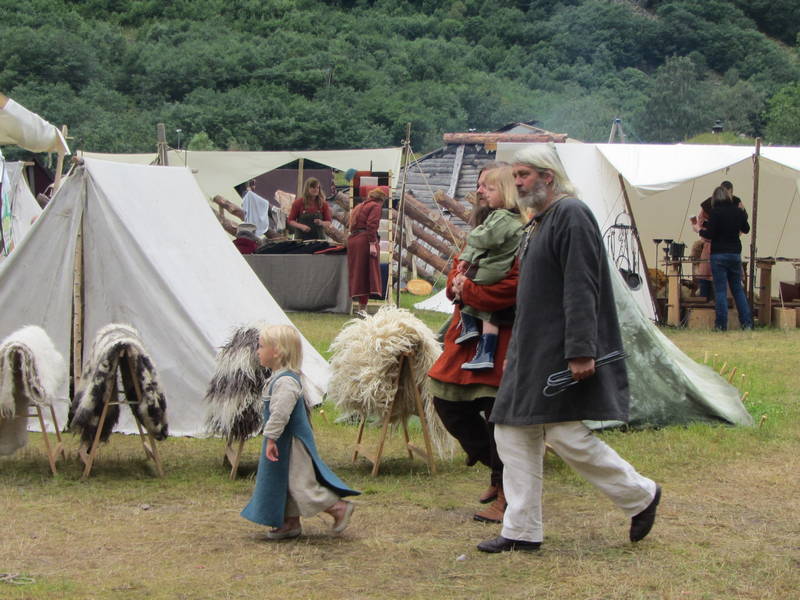
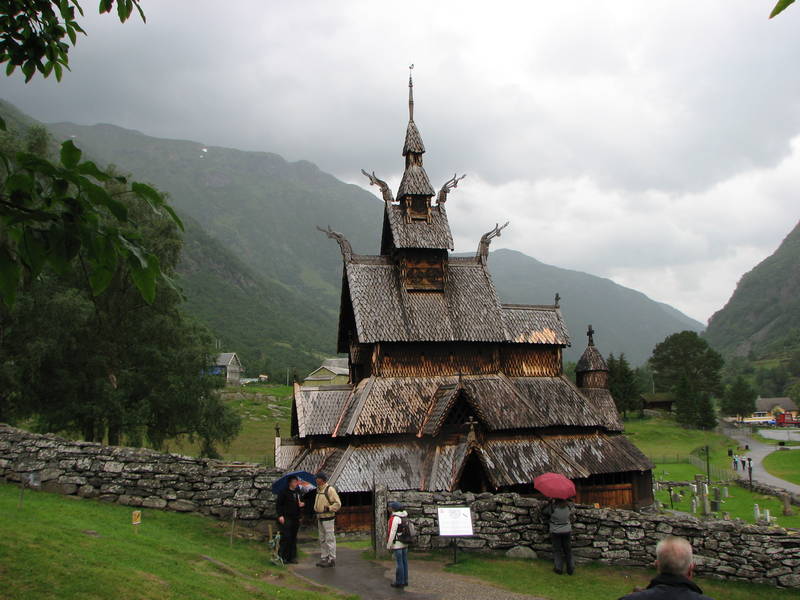

A choice as to where to ride was upon us: tunnel or road. The road route promised great scenery, a curving paved highway over mountain passes, a view of fjords - a motorcyclist's dream. Tunnels, on the other hand, are chilly, dark and mostly boring. So, we chose the tunnel route. But, of course, this wasn't just any tunnel - the Laerdal Tunnel is the longest road tunnel in the world. We decided to ride 24.5 kilometres underground, just to see what it was like. As it turns out it was very cool, both literally and figuratively, and fairly dark, but not boring. The ride just went on and on, with the occasional blue-lit pull-out area in case of emergency. Longer tunnels in the world are train tunnels, but you can't drive through those on your own, so this was very special. Ekke calculated that out of our 90 kilometres of riding that day, 60 kilometres of it was ridden underground.
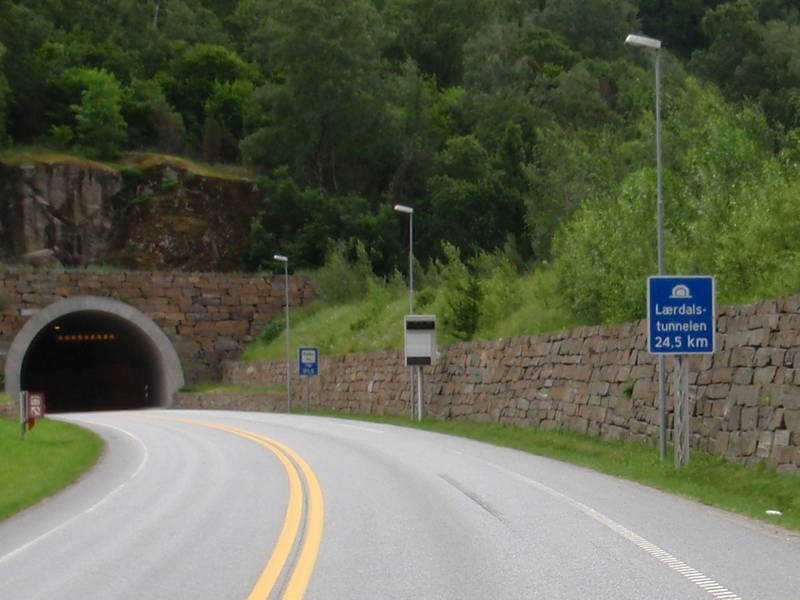
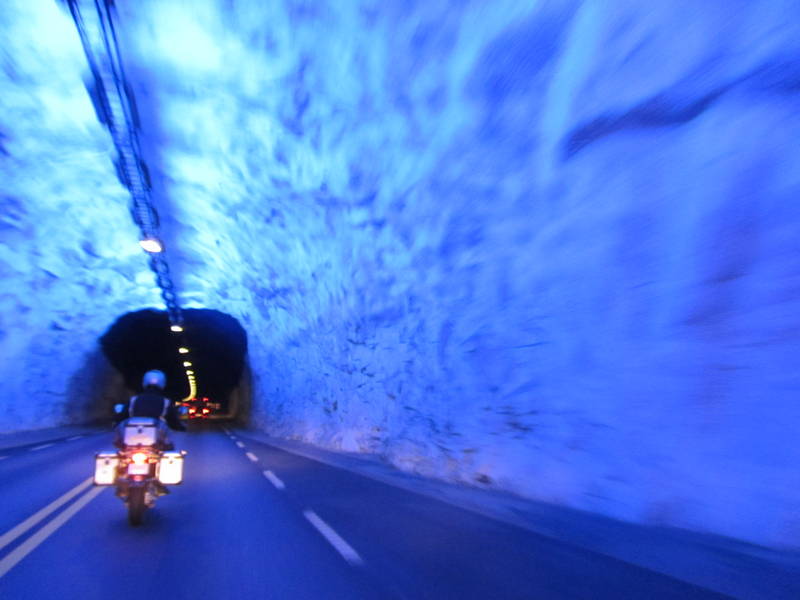
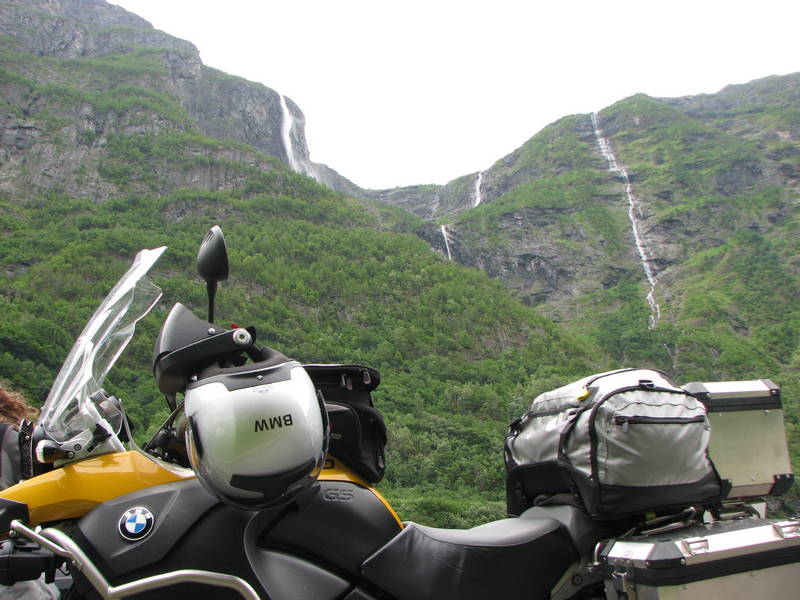
Our route the next day took us over some highlands beside the Jostedalsbreen glacier. The highway took us up and up, over I don't know how many switchbacks - lots. The landscape got more alpine with every turn, and eventually we came up and over the pass, above the treeline. It had been drizzling a bit all day, and we thought the Gore-Tex liners in our jackets would take care of us. Eventually were soaked, and when the rain came, it seemed pointless to stop and put on rain gear. So, we froze a bit passing by the chilly glacier, trying to take pictures in the rain. The road had a series of hills, resembling a roller-coaster. A tour-bus operator coming toward us was giving his passengers a thrill by driving so fast that the bus looked like it was going to fly up off one of the hills while we pulled to the right as far as possible. I don't know what the temperature was up top, but it gradually warmed up to +8 C as we descended into Lom. The pizza and hot chocolate in a quaint little touristy restaurant never tasted so good.
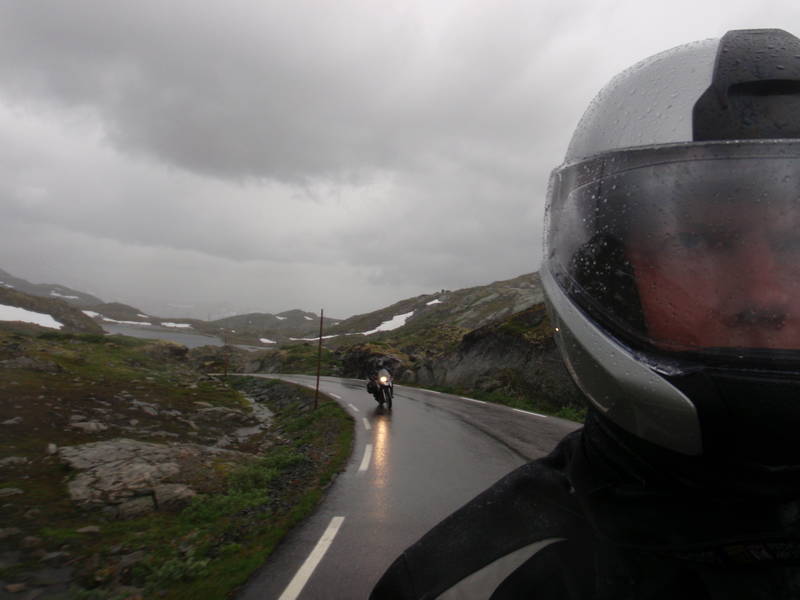
A common room at the campground allowed us a place to dry off. We got into an interesting conversation with a local Norwegian who was camping with his family in a tipi-style tent. We were baffled by how much these tents looked like North American tipis, but he explained that they were modelled after traditional structures of the indigenous Sami people. Very curious. We also talked about how shocked we were at how expensive things were in Norway. How could people afford to live? He said that the government paid for so many social programs, but that people often went into debt to afford their high standard of living.
The next day was bright and sunny, so we did laundry, and then made breakfast. We had it all laid out on a huge picnic table. Ekke sat down first, and then I sat down beside him because the other side of the table was wet. All of a sudden, the table tilted backwards, and next thing you know, we were on our backs on the grass, the table on its side, and our breakfast all over us. No one was hurt, and we did eventually laugh about how ridiculous we must have looked, lying there under a picnic table. The day improved, however, and, happily, turned into one of the best riding days of the whole trip. After visiting the Lom Stave Church, we rode on some beautifully paved highways into more alpine scenery. The gently curving roads took us past glacial lakes, tumbling waterfalls, and snow-covered hills. A roadside picnic table gave us an opportunity to just sit and take it all in. A group of motorcyclists roared off nearby, obviously having a great day.
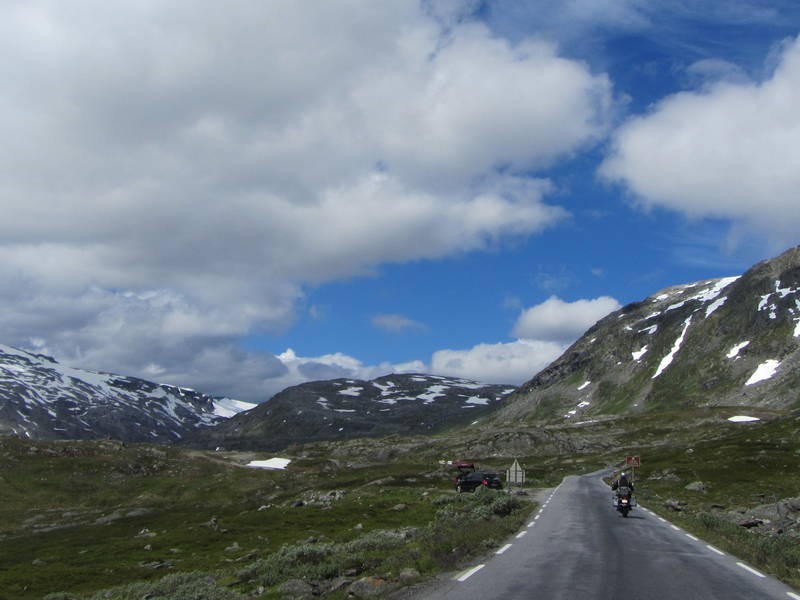
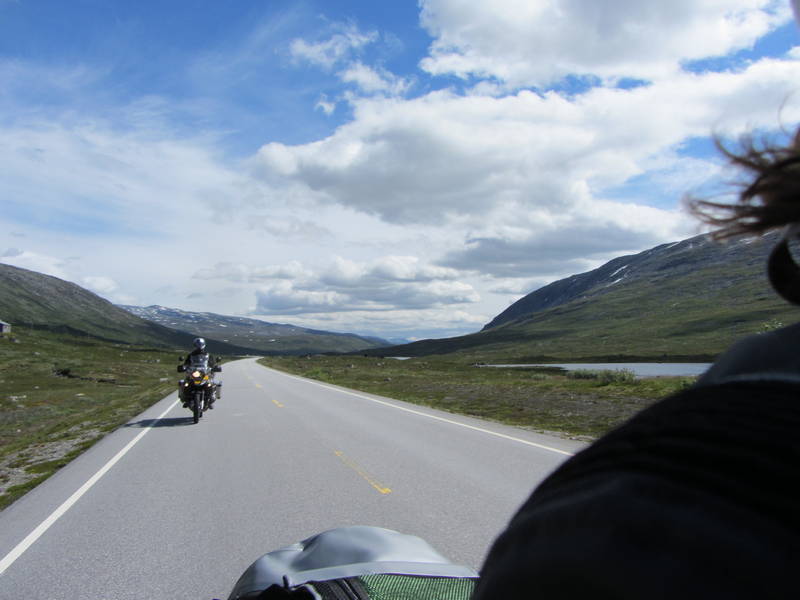
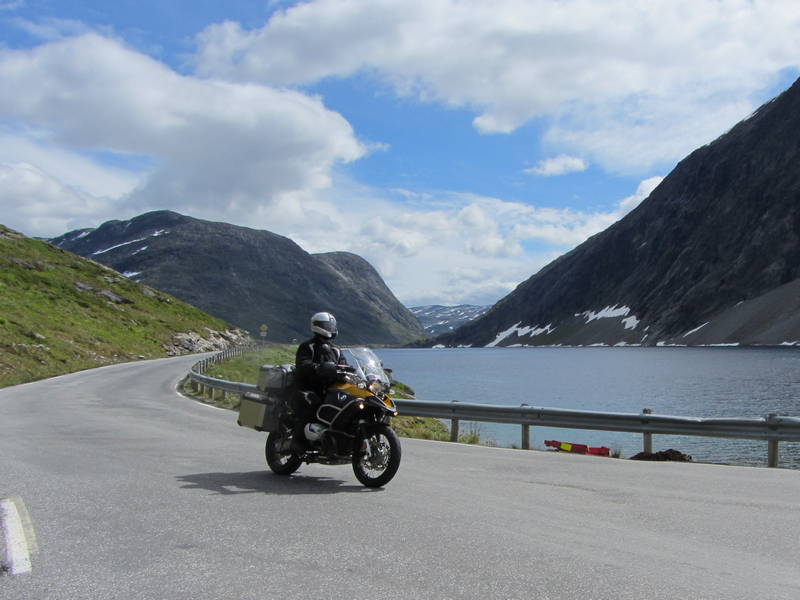
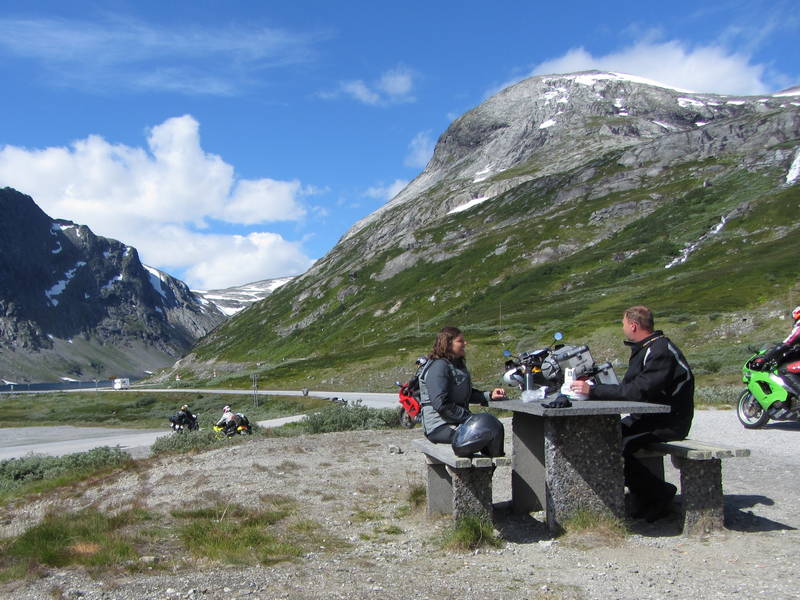
The road was officially called the Trollstiggen, or Troll's Ladder and photo ops presented themselves at every turn in the road. On one such stop, we happened to be at a crossroads, and saw a sign leading to the Dalsnibba viewpoint. The name sounded vaguely familiar, and then I remembered that Ekke's dad had said that this viewpoint was a highlight of their trip to Norway. We decided to check it out. It turned out to be a toll-road, and the cost, 100 Kroner or $20 each to ride up to a viewpoint, had us shaking our heads. (Coincidentally the exact same price as five small shrimp in Bergen.) But, we soon got over the outrageous price as we ascended the gravelly, switchback-littered road, enjoying a bit of challenging riding. We got a glimpse of the view as we were going up, but after parking and walking over to the edge, the sight was nothing short of jaw-dropping. Geiranger Fjord, a World Heritage Site, lay in the distance, flanked by high, green cliffs meeting the deep, blue waters below. A huge cruise ship looked like a puny toy from this distance, and we were amazed. We looked at the road we would be riding to get down to the fjord, curving and twisting over rocky alpine meadows, down, down, down. On the other side of the fjord we could see where the Trollstiggen road continued, traversing up the steep cliffside and beyond. The parking lot was strewn with all kinds of tour buses from the cruise ships. We chatted with some lovely people, though, who were quite amazed that we had brought motorcycles over from Canada.
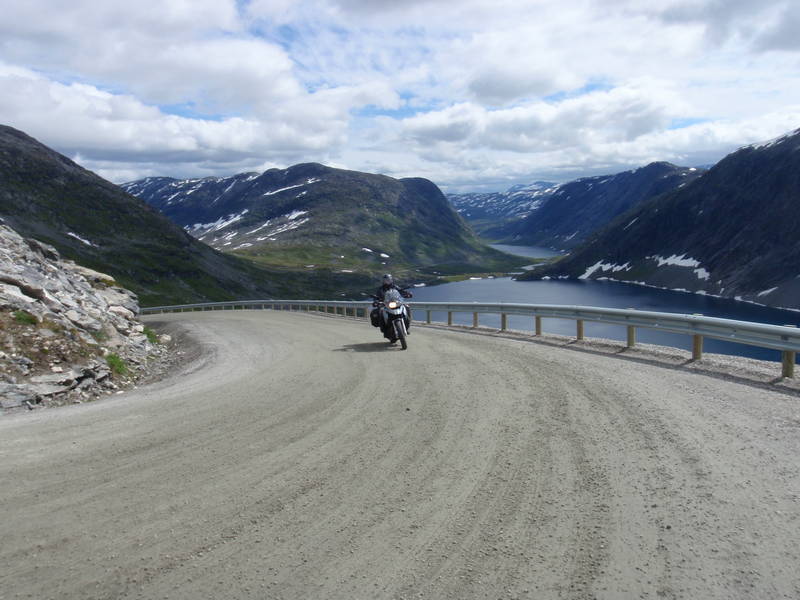
The classic Norwegian fjord scene from Dalsnibba
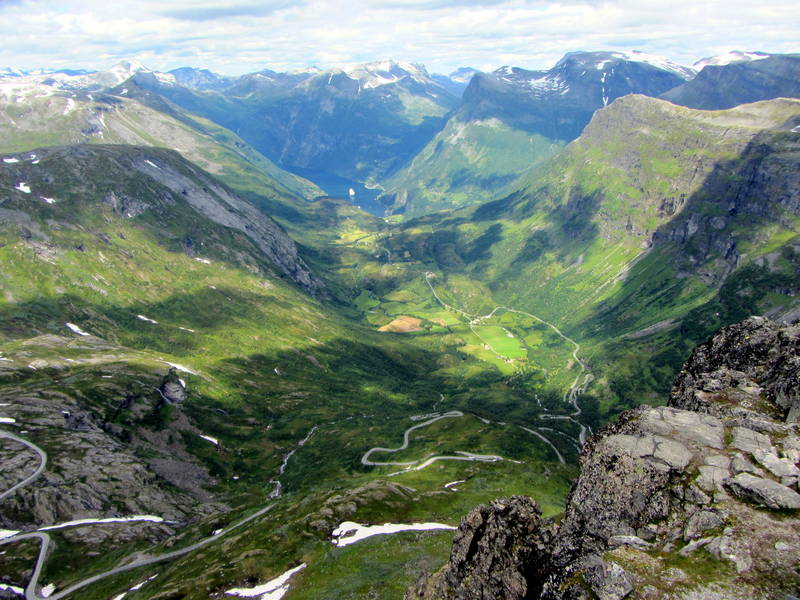

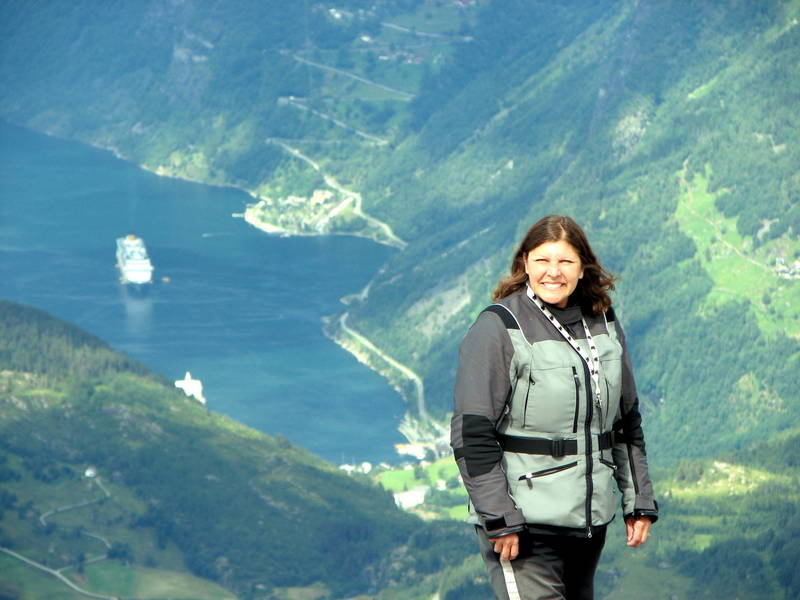
That looks like a cool place to camp
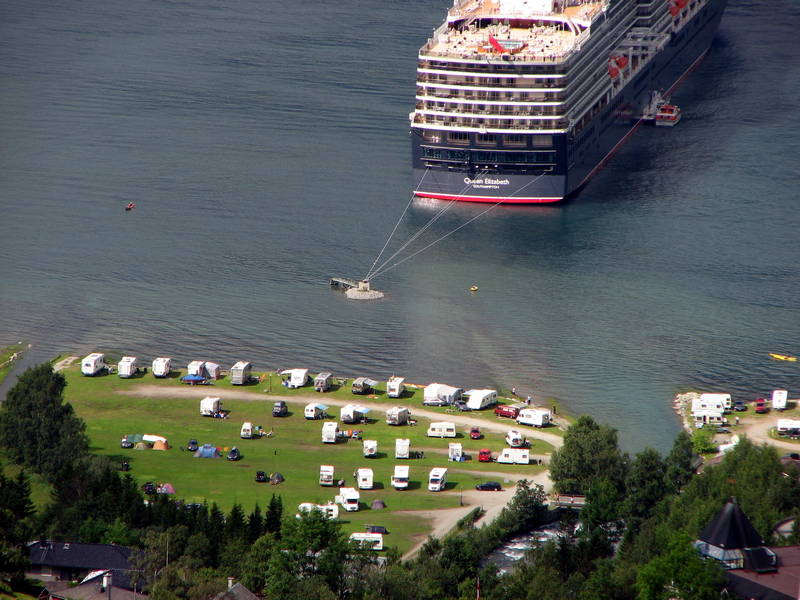
We stopped at the campground by the fjord, in Geiranger, long enough to set up camp and eat some lunch. The campground was the most stunning of our trip, a grassy field right on the edge of the fjord. A huge cruise ship, the Queen Elizabeth was anchored nearby, making for an interesting view. It was only 4:00 PM and knowing that it would be daylight well into the evening, we decided to ride the remainder of the Trollstiggen. The traverses up the side of the cliff were a lot of fun, and we took the corners as fast we dared, hitting the gas on the straight sections. The bike handled even better without being loaded down with luggage. A viewpoint partway up had us looking back at Geiranger fjord and our campground, stunning from this angle as well.
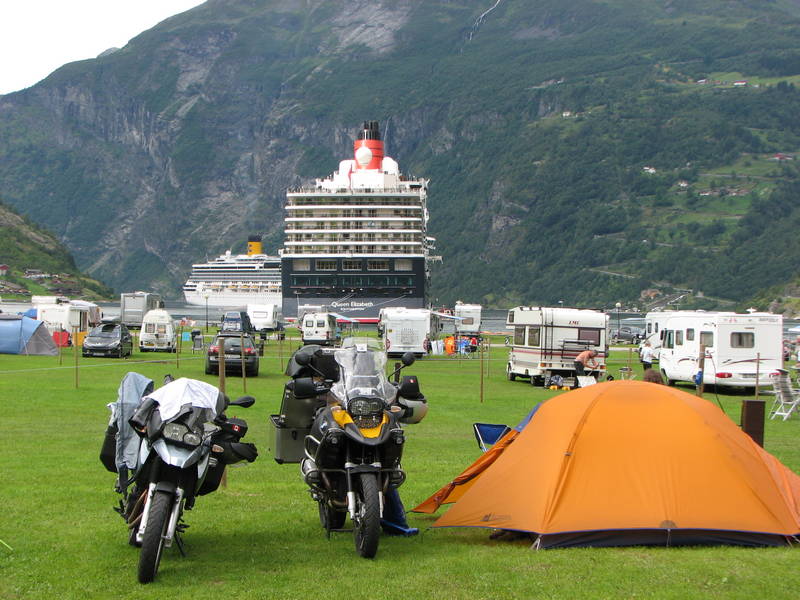
One ferry ride and a number of kilometres later, we came to the highlight of the Trollstiggen road. This was a very steep, switched-back section, with a huge waterfall dropping down the middle. Riding down beside sheer drop-offs was quite impressive, especially when we had to squeeze over to let a big truck pass. I can't believe semis were driving this road. Later, from a cantilevered lookout point, we saw them trying to negotiate the switchbacks. Very talented drivers.
Watch out for Trolls
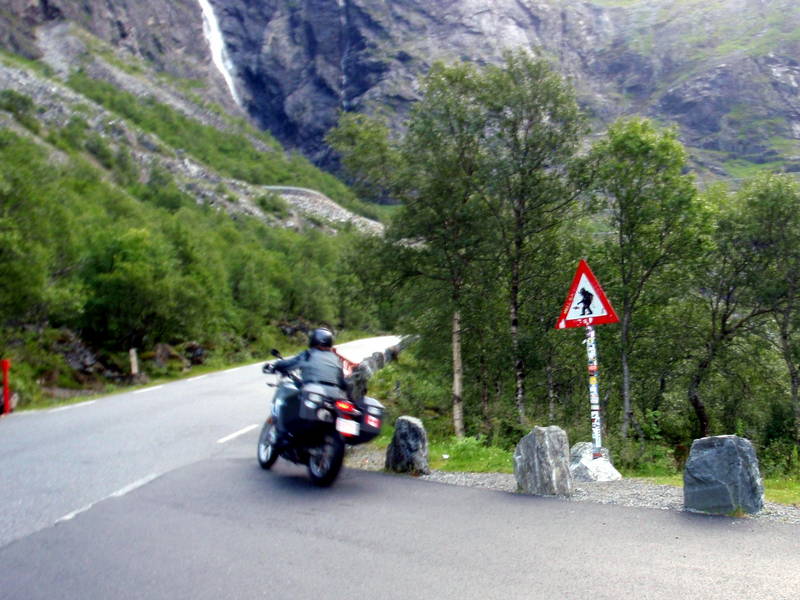
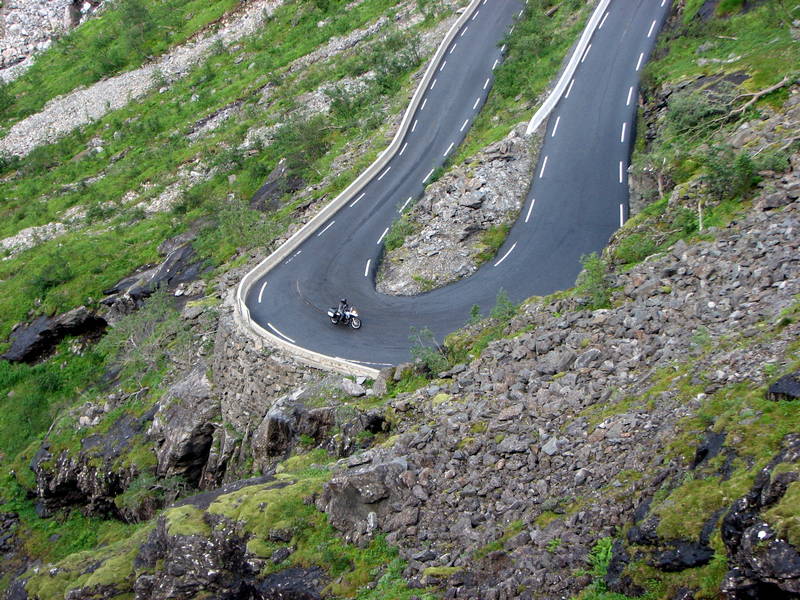
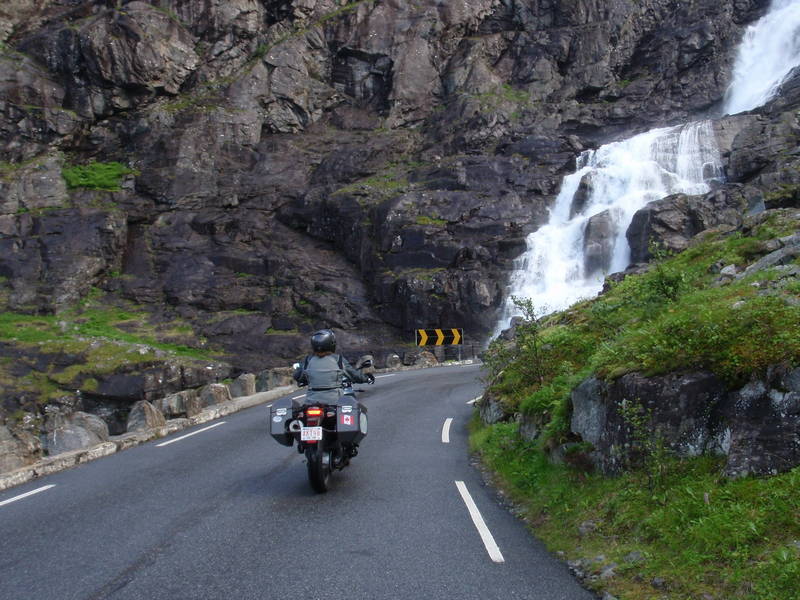
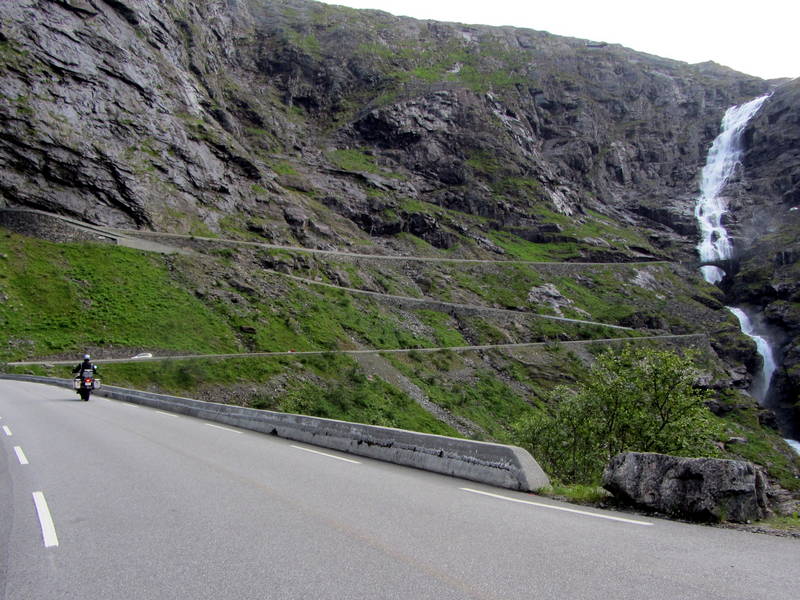
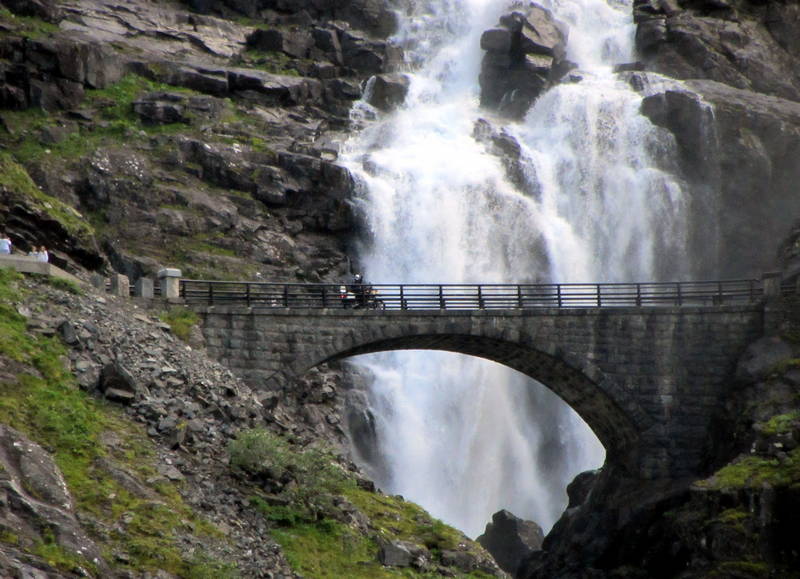
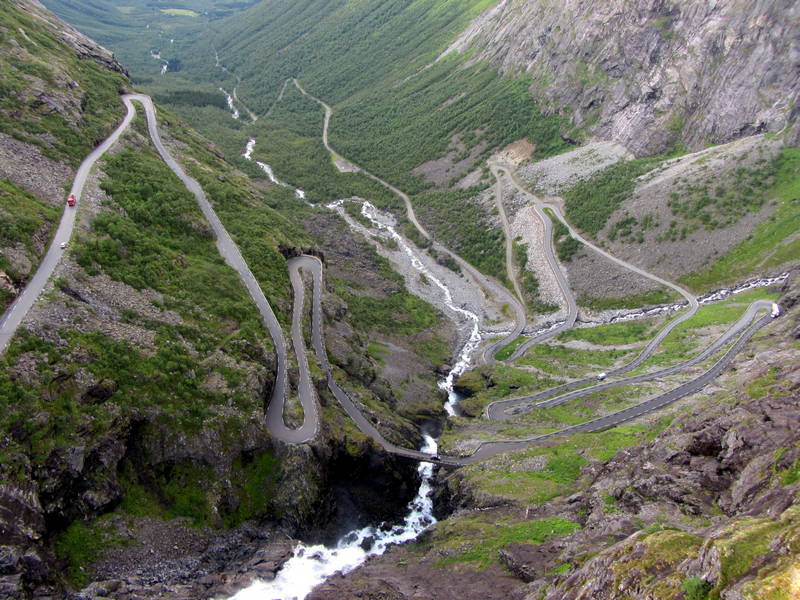
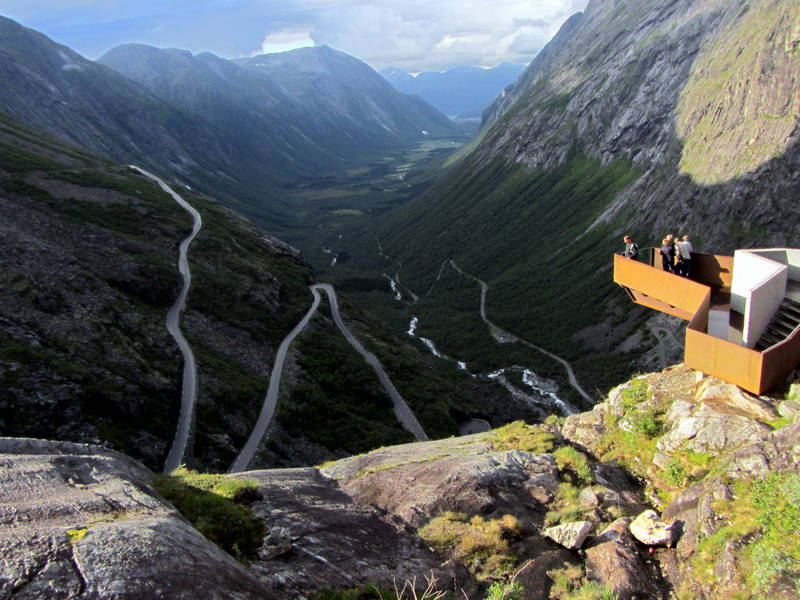
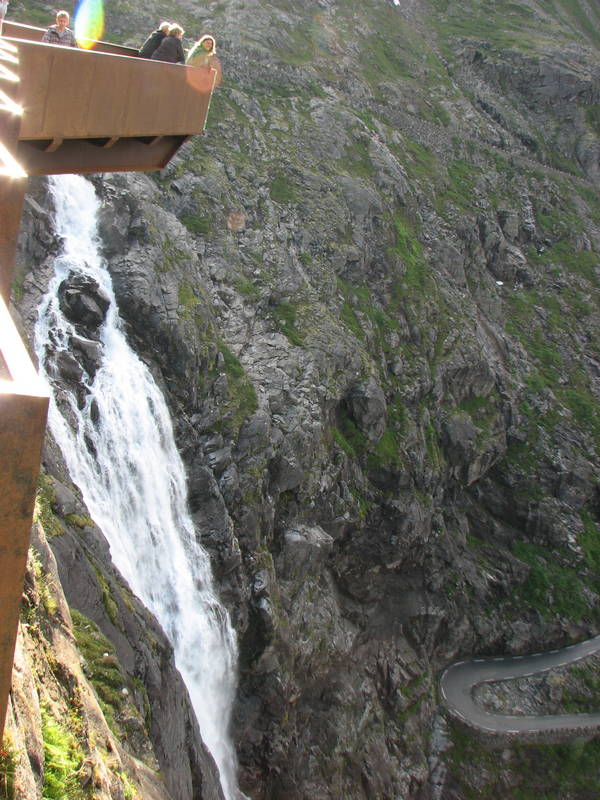
Our ride back to Geiranger was fun, back down the switchbacks to the fjord. I was really appreciating the performance of my BMW F650 GS and felt quite confident powering through the tight corners, especially with such responsive brakes. It was still quite light out at 9:30 PM when we arrived, the end of a really long and eventful day. So, we splurged on a restaurant meal and enjoyed the touristy ambiance of this beautiful place. Ekke had the turnips, beets and potatoes and I enjoyed some fish and chips. Some Swedish bikers came over, back at camp, and we chatted for a while before hitting the hay at 11:00 PM.
The ferry ride up the Geiranger Fjord the next day was made quite enjoyable with classical music by the composer Grieg, a former local, playing over the loudspeaker. We 'cruised' beside a steep cliffside with a small farm tucked into an alcove on the side. The running commentary told us that when the farm kids went out to play, they had to be tethered with ropes so that they didn't accidentally fall over the edge of the cliff. Another farmer built on the side of a cliff so steep, a ladder was used to access it from above. The story goes that when the tax collector was due for a visit, the ladder would be pulled away so access to the farm was, essentially, cut off. If only it were that easy to avoid the tax-man here.
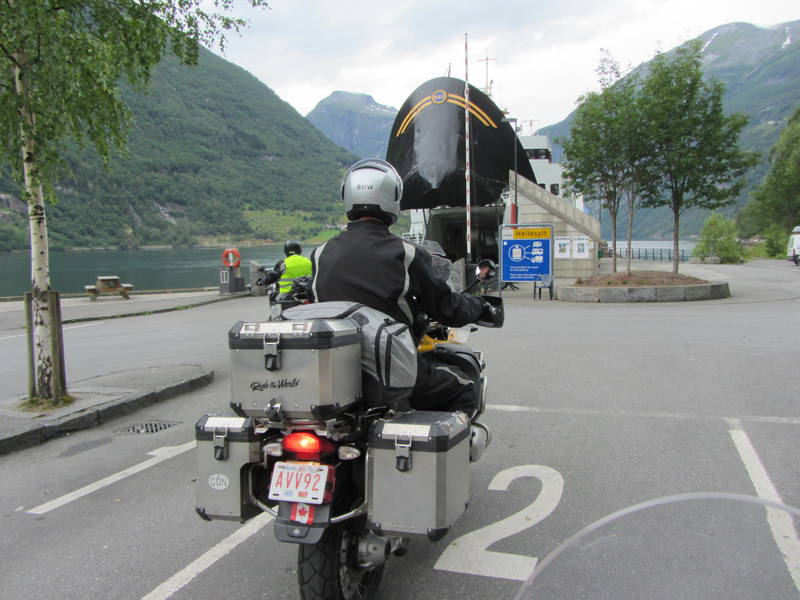
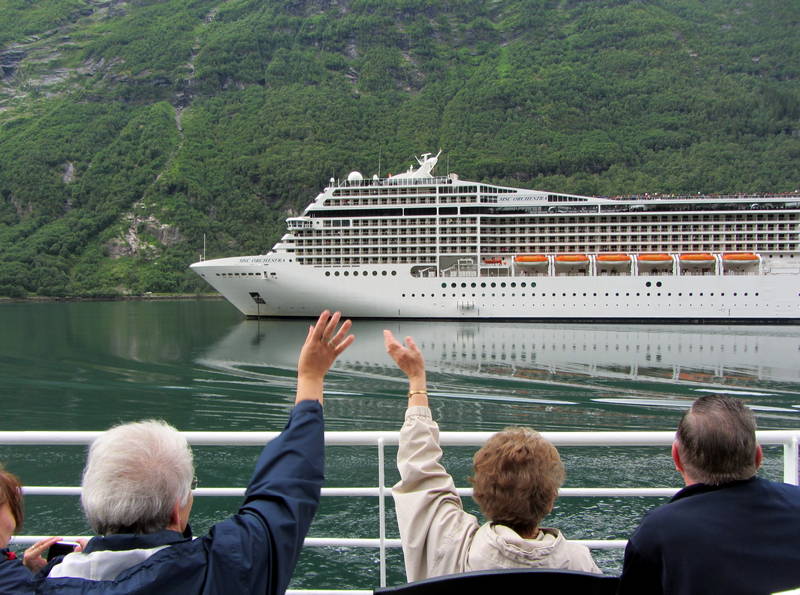
Enjoying the cruise
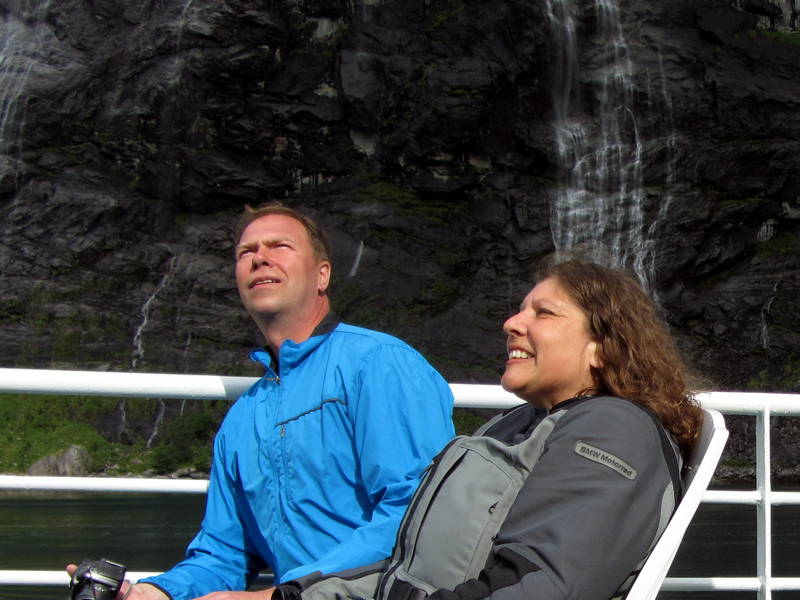
Rope the children
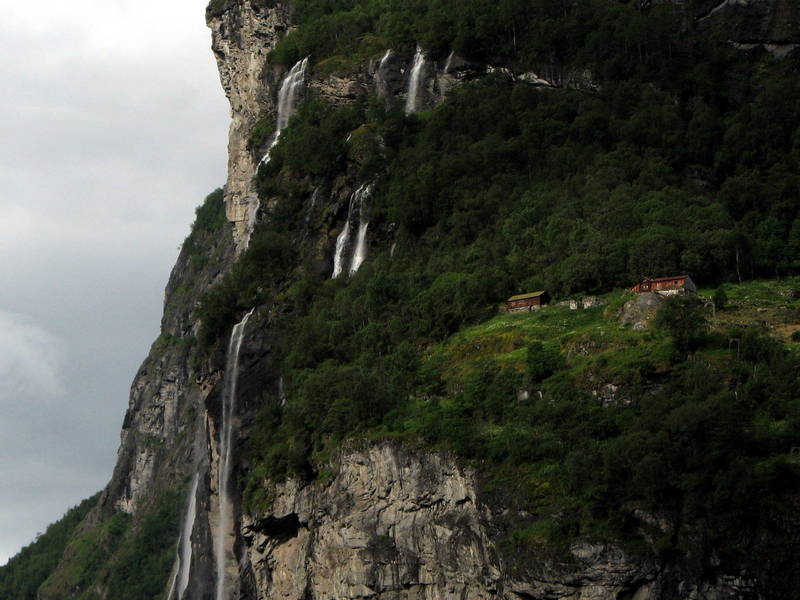
The ferry ride continued for quite some time, and then we rode gently curving roads to the seaside city of Alesund. Luckily for us, according to Lonely Planet, the city had burned to the ground in 1904. It was rebuilt in the Art Nouveau style, with lovely pastel-coloured buildings. It was easy to park the motorcycles on a side street and walk around the city for an hour, enjoying the maritime atmosphere and refurbished architecture.
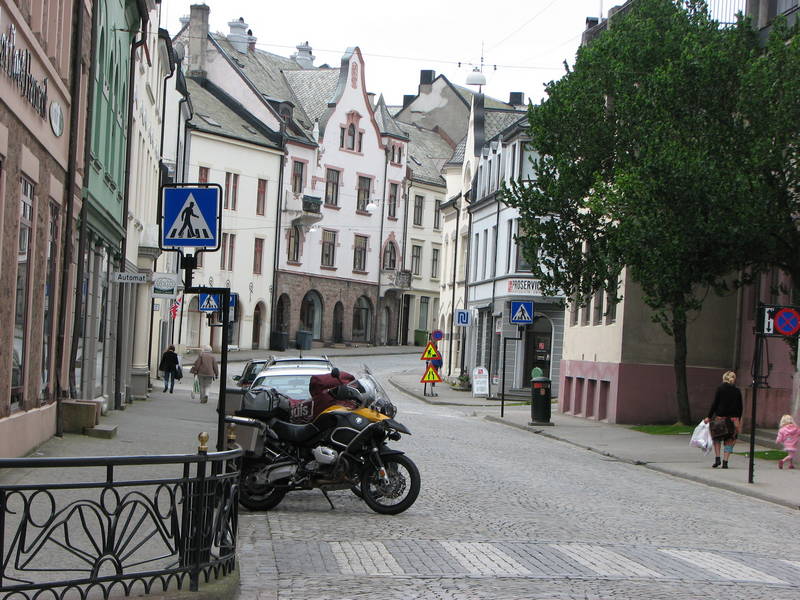
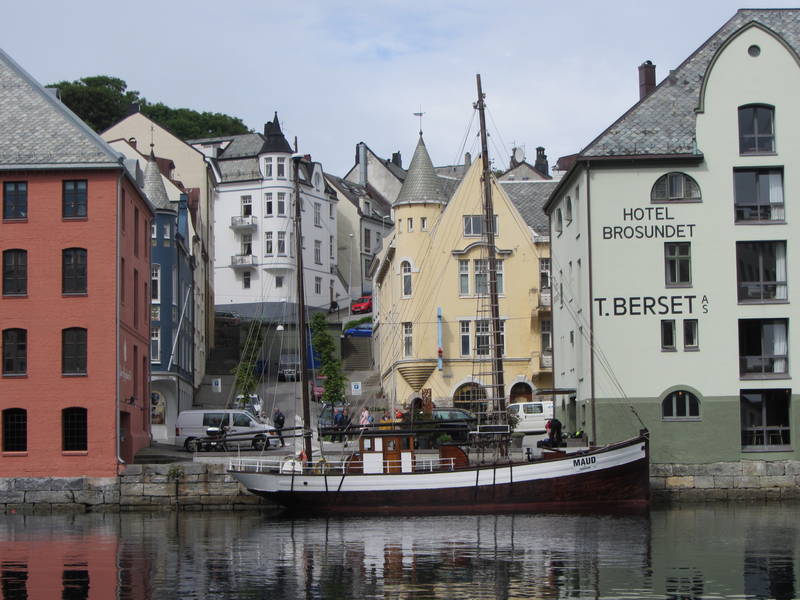
Camping in the rain in Kristiansund was made bearable with access to a kitchen and common room. How civilized. The next day we rode the Atlantic Road, a series of eight bridges that skip between several islands. One of the bridges has a distinctive curve in it, unlike anything we'd seen before. With the barren, rocky landscape, it was an impressive place and definitely fun to ride on a motorcycle.
The Atlantic Highway
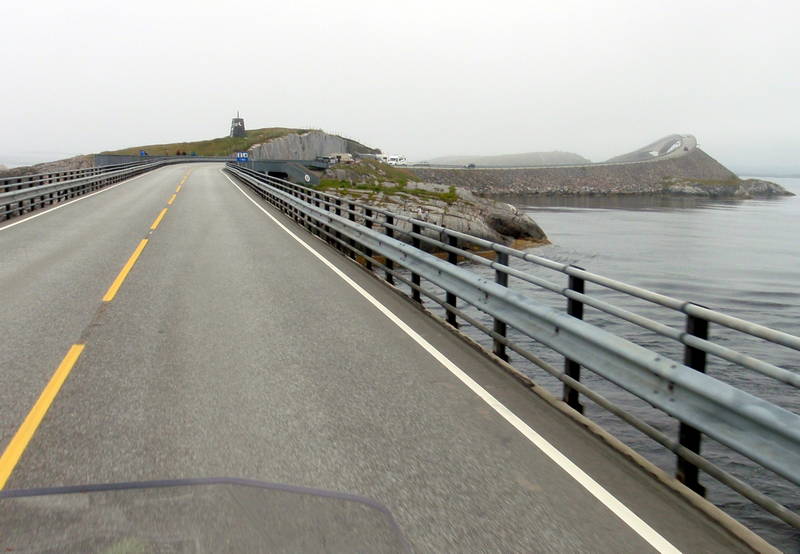
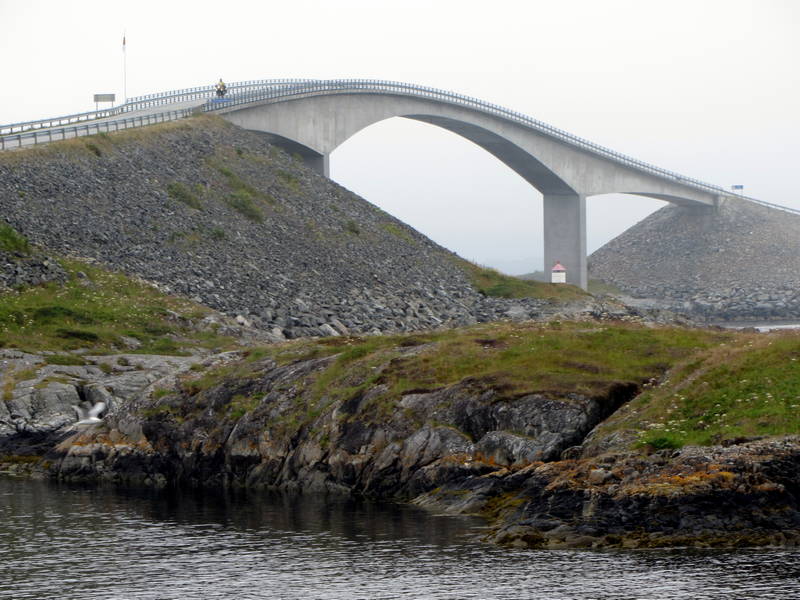
More ferries and winding roads by the sea made for a pleasant afternoon of riding. We stopped for lunch in Trondheim, a medieval city founded by the Viking king, Olav. I was quite surprised that there were so many medieval buildings still intact, like the huge cathedral and town square. There was even a wooden royal palace still in use, the largest in Scandinavia. We thought we could get a less expensive lunch in Trondheim since it was a university town but Ekke paid 149 kroner ($30) for a hamburger and fries. Shocking.
Entering Trondheim
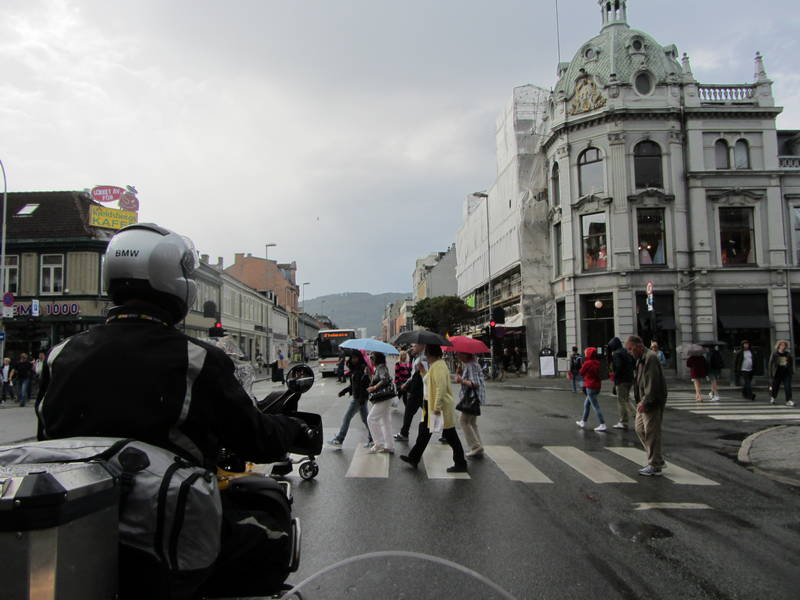
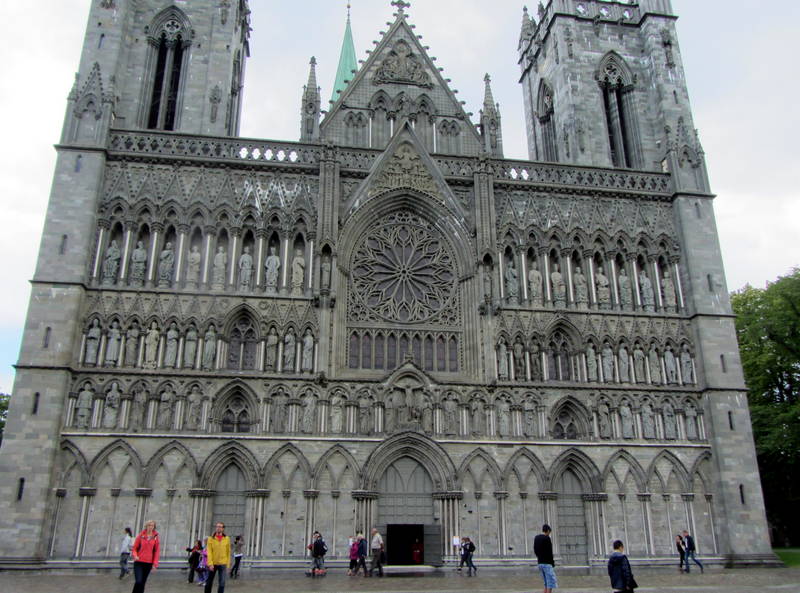
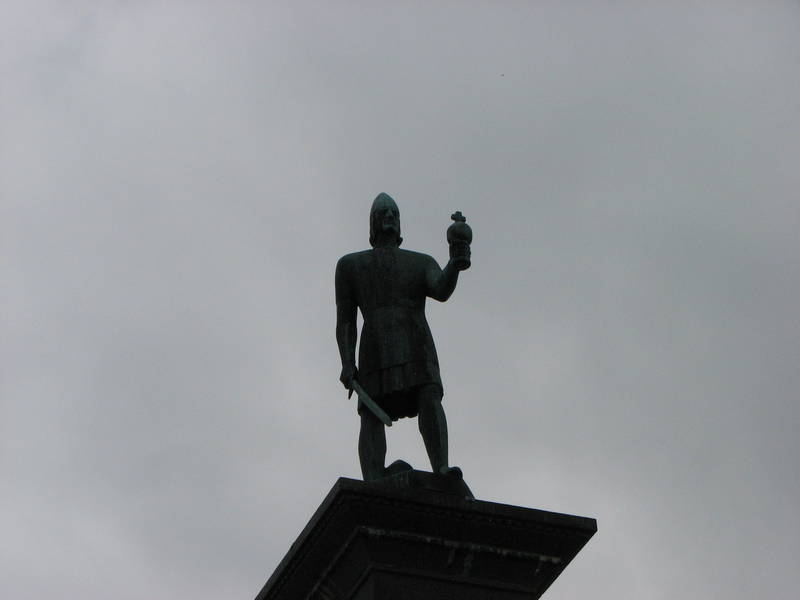
Camping by the ocean was fun, with little bird-inhabited, rocky islands in the distance. We walked along the beach, and then enjoyed a relaxing evening watching the sun not go down. The next day, we rode to Hell. Really. It's on the photo of Ekke's GPS. It's a small place with its only draw being the name. There's even a sign, 'Welcome To Hell'. Further north we were relieved that the roads were far less crowded than in the south. Five-hundred kilometres and many curvy roads later, we arrived at Krokstrand and the Polar Campground. It was great to have a restaurant nearby where I could enjoy veal schnitzel and Ekke, some mystery meatballs. Breakfast at the same restaurant the next morning was pricey, and the only thing special about it was the caviar in a tube. Very salty. Ekke was thinking that they should have bacon in a tube for breakfast.
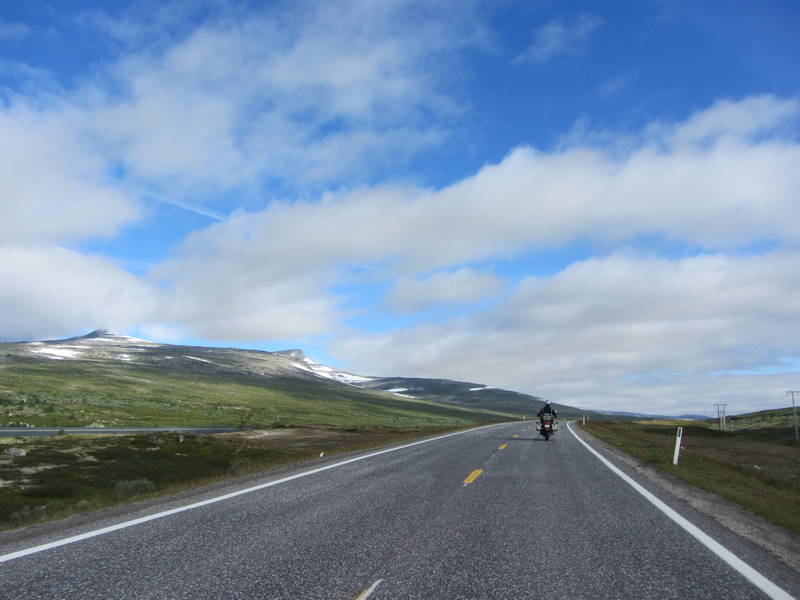
We crossed the Arctic or 'Polar' Circle early in the morning. Since we were at a fairly high elevation, the landscape was quite alpine and very barren. Tour buses lined the parking lot and tourists filled the gift shop. We spent a bit of time getting the obligatory photos and buying some souvenir buffs. This was our second visit to the Arctic Circle, the first in 2006 in the Yukon, Canada, on our trip to Inuvik on the Dempster Highway.
Crossing the Polar Circle

Ekke's zipper on his motorcycle jacket decided it wasn't going to work anymore. At first the waterproof zipper was just sticky, then it wouldn't undo at all and he was stuck. We got the jacket off by pulling it up over his head. Then, the zipper broke completely and would not do up again. Taping it up with duct tape worked for a while.
I had lost my flip-flops (cheap, rubber shower shoes) at the last campground, which was no big deal, really, as I'd only paid $3.99 in Canada for them. But to replace them in Norway was another matter. Ekke and I wandered the shoe stores of Bodø searching for a new pair. Exhaustion turned to exhilaration when we finally found a pair. But they were pretty pricey at 199 kroner. Ekke, obviously weary of walking through shoe shops, said, "Just buy them". A quick calculation determined that they really cost about $40 Canadian. Yikes. Good thing they were 30% off. $28 for cheap flip-flops didn't quite seem so bad. And they did have a Nike symbol on them, almost justifying the price. I think I'll have them insured. We thought we'd save some money by eating at a fast food place. A Whopper meal cost about $16. The same meal would be about $7 in Canada. No wonder Norwegians eat so much fish.
Bodø
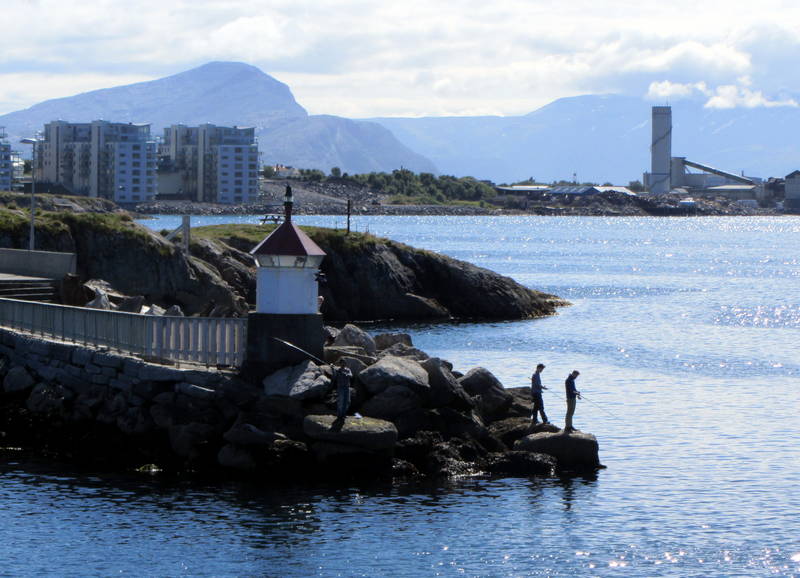
We had parked our bikes in the ferry line-up to go shopping, and returned to find the 3:00 PM ferry loading. Unfortunately, the beautiful boat that we thought was our ferry was not, and the other, not-so-nice small ferry filled up pretty quickly. A ferry staff member came around with a clipboard asking us if we would be taking the 6:30 PM ferry if we didn't make it onto this one. What? There was a chance that we might not get on? They loaded what looked like the last car, and we just about teared up at the thought of having to wait for the evening boat. But, alas, luck was with us as we saw an attendant frantically waving us to go ahead of other vehicles. They just had room for three motorcycles. Phew. The bright sunny day made for some great photos as we departed Bodø. It was mostly a very pleasant voyage. But then the clouds covered the sun and the wind came up, which made for a chilly time on deck.
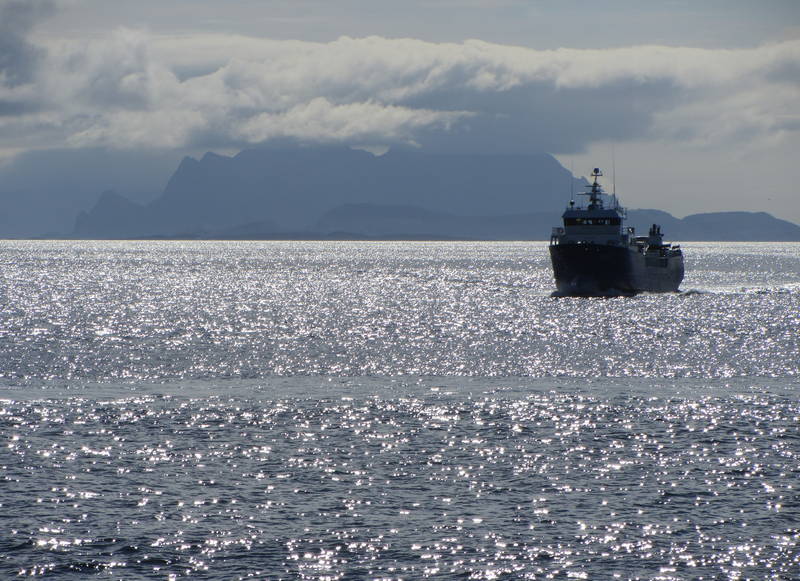
A chilly ride but it was way too stuffy inside
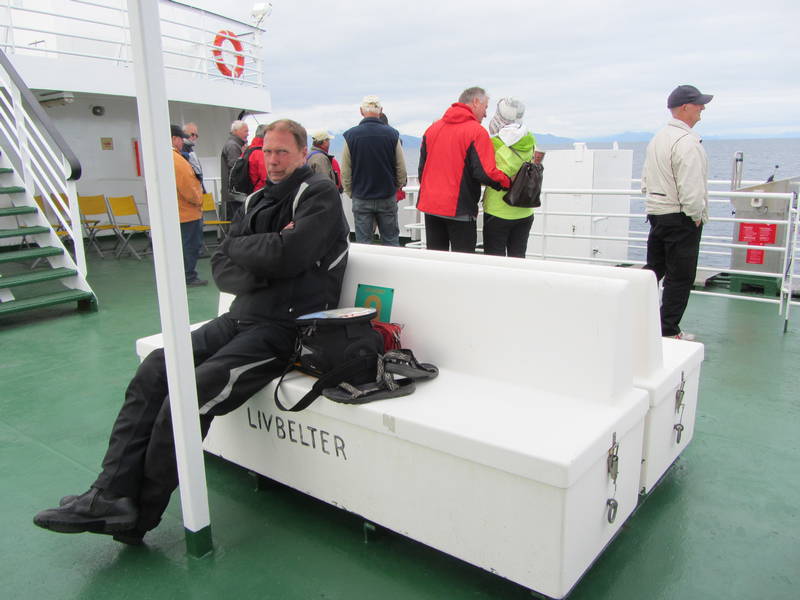
The Lofoten Islands appeared on the horizon and were lovely. Craggy, fairy-tale like peaks pushed up in the distance, veiled with lofty clouds. The campground was easy to find and we immediately went in search of supper in the little town of Å. Å (pronounced 'awe') is a picture-perfect place with red Rorbuers, or fishing huts, everywhere. The Bryggen Restaurant only had one dish available on the menu, so we both enjoyed the Bacalau fish stew with creme fraiche. Much tastier than Burger King though even more expensive.
Approaching the Lofoten islands
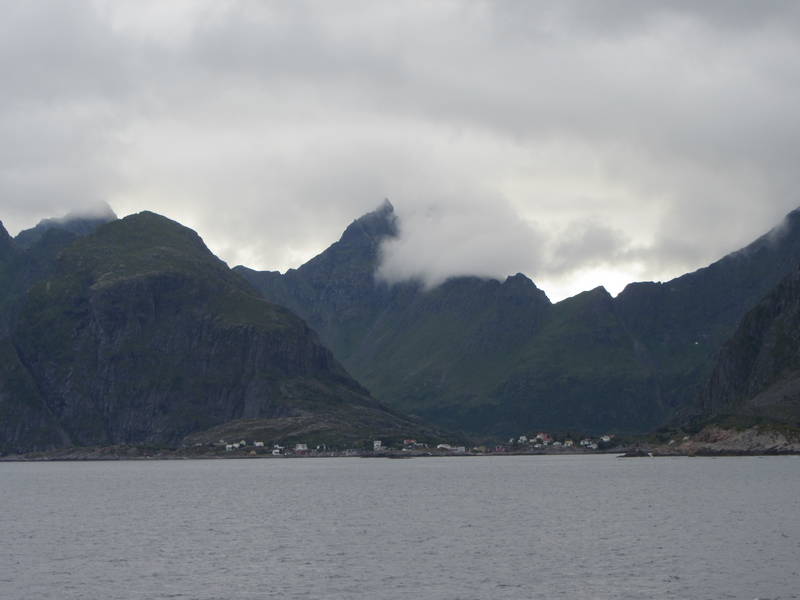

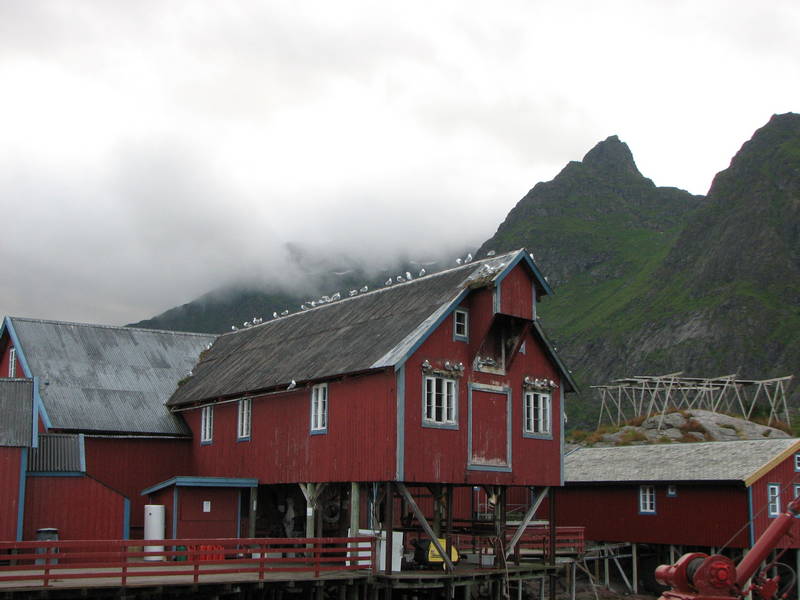

Riding through the little towns of Rein, Sakrisoy and Svolvær the next day was an absolute pleasure. The road wound around cliffs and through the little fishing villages with bright red Rorbuer huts everywhere. There were more interesting bridges, curving up and over small inlets, and we caught a glimpse of the ocean every now and again. When it started to rain, we ducked into a shopping centre for refuge and lunch. Ekke tried the egg smørrebrød, an open-faced sandwich typical of these parts - delicious.
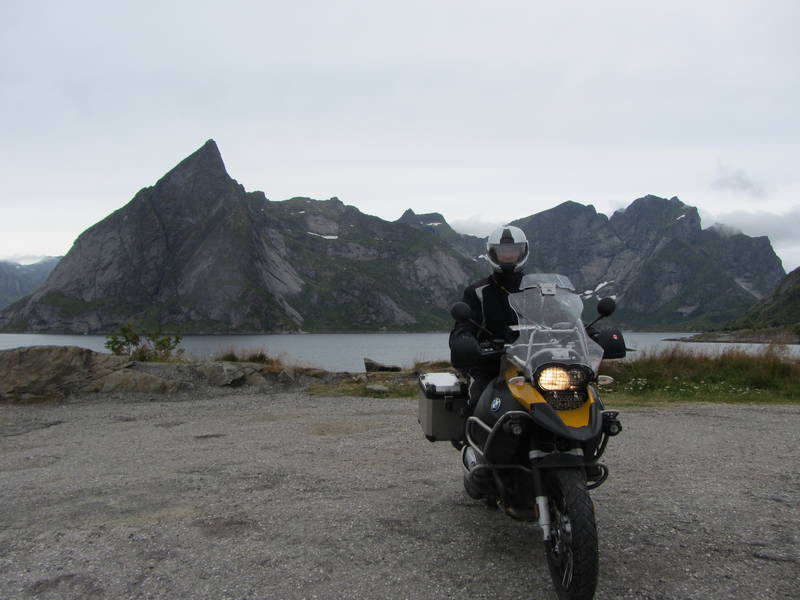
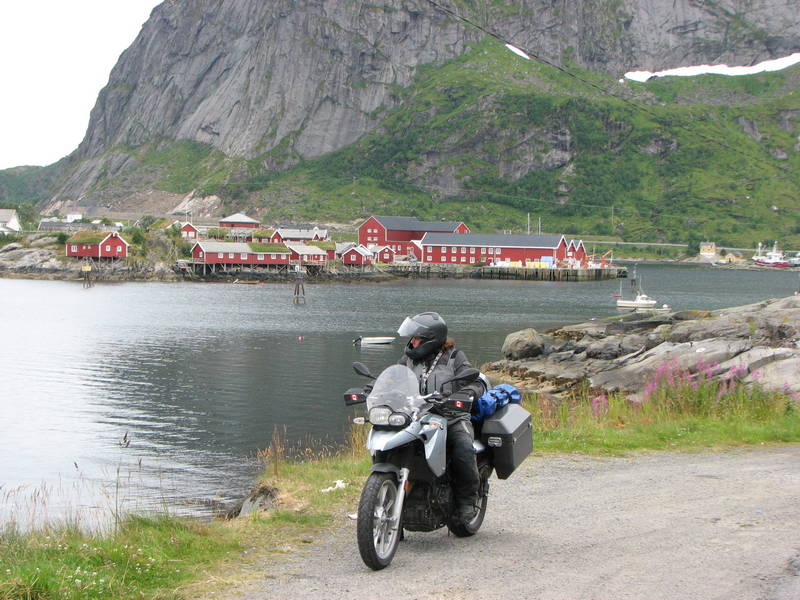
Cod drying racks

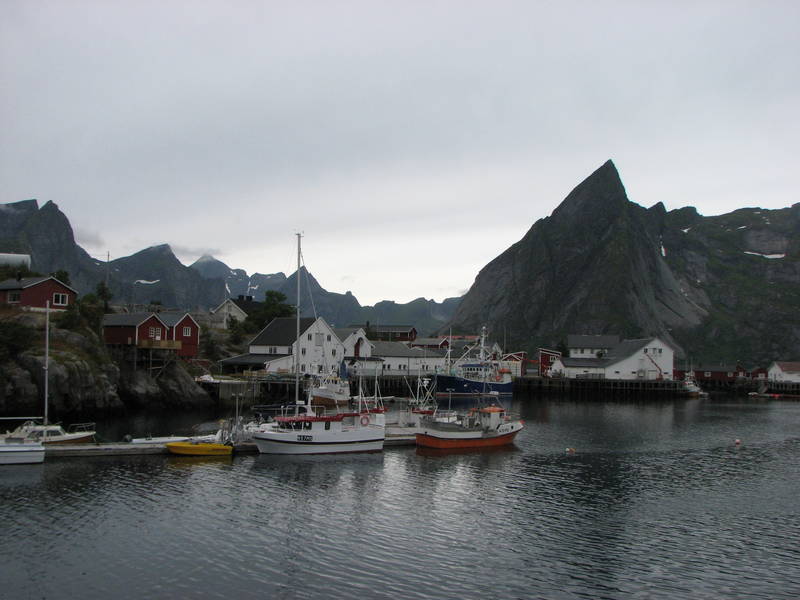
The rain didn't let up, so we put on all of our wet-riding gear. It gave me the first opportunity to try out the new BMW raincoat that I had purchased in Frankfurt. The hood fit nicely under the helmet, and I rode like that for hours. We had also purchased some overmitts in Canada. As we rode on, the rain just pounded, and we did get wetter. Ekke and I took a break and talked and agreed not to stop to try and dry out. It's interesting, that once you've got all the gear on, you don't want to stop and take it all off, only to put all the soggy stuff back on. So, we rode and rode. It got foggier as we climbed a hilly pass, and I just remember thinking, "Was it going to be like this all the way to Nordkapp?" Yikes. Signs of civilization were pretty sparse, and it was disheartening to follow some signs to a hotel, only to find it abandoned. Ekke eventually found a campground on the GPS, thank goodness. We were fairly elated when we learned they had camping cabins, with heaters, for 310 kronor or $60 per night. The wettest parts of us were our motorcycle helmet straps. They looked like they were designed to sponge up water, and were cold against our skin. My motorcycle overpants didn't work, and the overmitts also let in water. After drying off, and hanging wet gear all over our cabin, we ate at the little on-site restaurant. A small glass of uninspiring wine cost $13. I didn't go for the second glass.
A warm, dry cabin but why the puzzle from Switzerland on the wall?
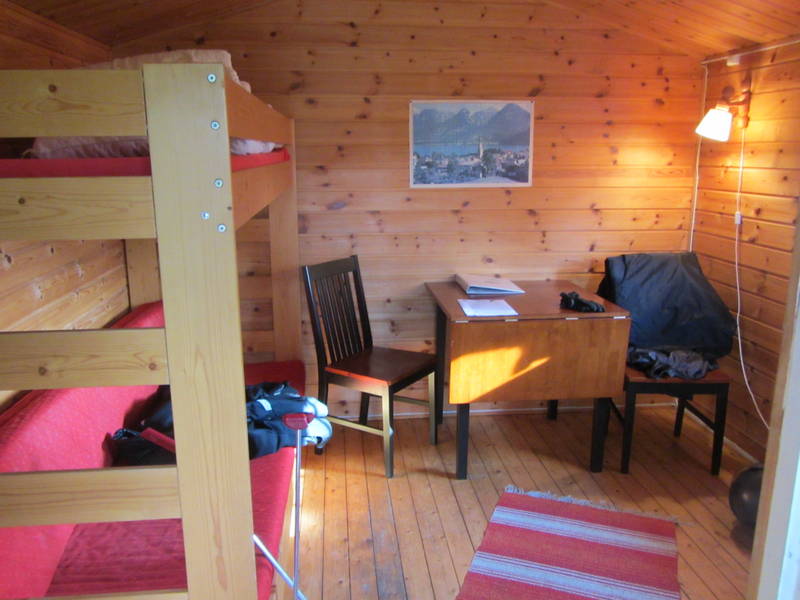
In the morning, we found the fog had lifted and we woke to a bright, sunny day. I was elated, as it had looked so grim the evening before. Everything had dried out, and with great anticipation, we started riding further north. Direction: Nordkapp, the most northerly point in Europe. We had decided to go for it. Our route took us around fjords as, up north, there are fewer ferries to take you across. We'd ride for ages and look across a kilometre of water, seeing the spot we'd ridden by much earlier that day. Also, you'd think it would be easy to put in a lot of kilometres on the well-maintained highways, but the speed limit was only 90 kph. We had heard of big fines doled out for speeding in Norway, so we were careful. Finally, stopping to take pictures took up a lot of time, the scenery was so stunning. Pink wildflowers lined the roads, with the fjords sparkling in the bright sunshine. And beyond, glaciers topped the peaks of beautiful mountains.
Stunning scenery
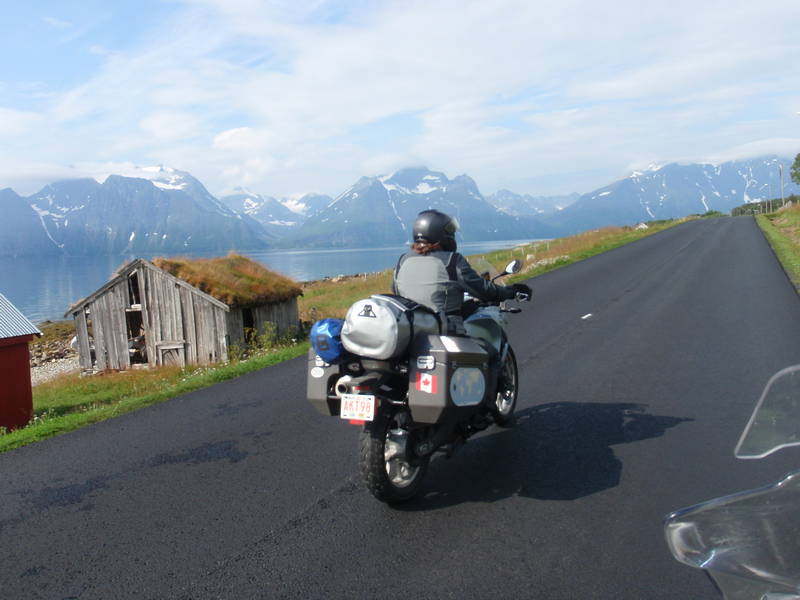
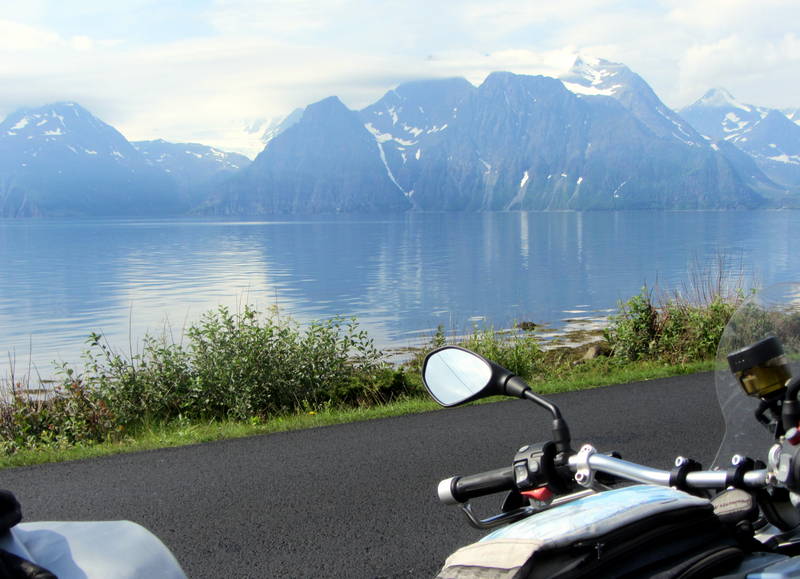
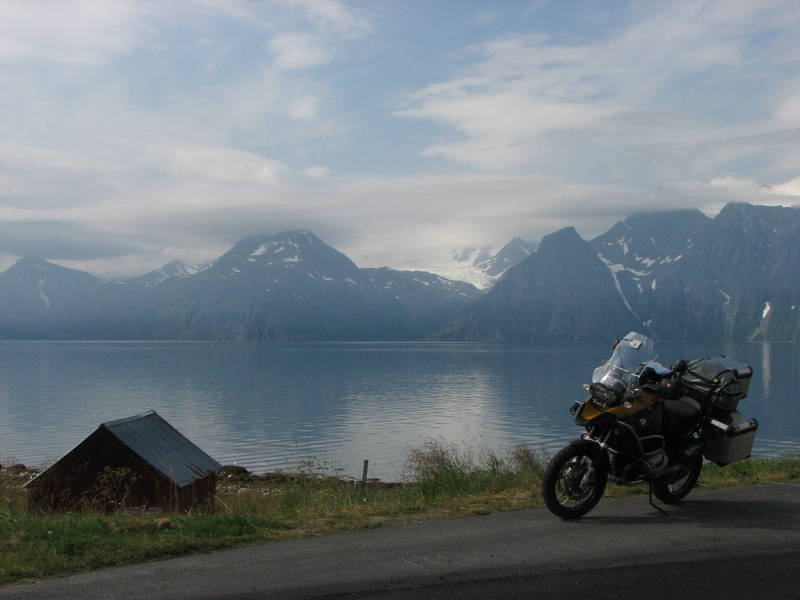
We were happy to find a 7-11 store open on a Sunday, and got some fresh baked buns and fruit for lunch. 7-11s are a bit more upscale here in Norway, and always have fresh food. There was a picnic table by a little harbour and we basked in the sunshine. After a long day of riding, we arrived at our destination, Alta. We stopped at the ancient rock carvings, a World Heritage Site, and spent an hour wandering around. Some of the 4000 carvings date back to 4000 B.C. What a thrill to be wandering among art done by people of the Stone Age. The carvings represented reindeer herding, fishing and bear worshipping. Quite reminiscent of our trip to the Tsodillo Hills in Botswana, but with rhinos and penguins the highlights of their rock carvings.
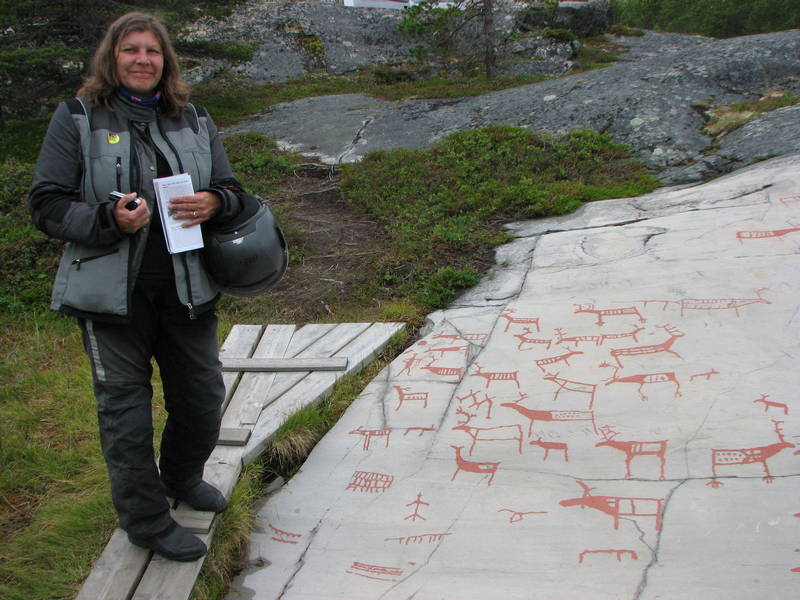
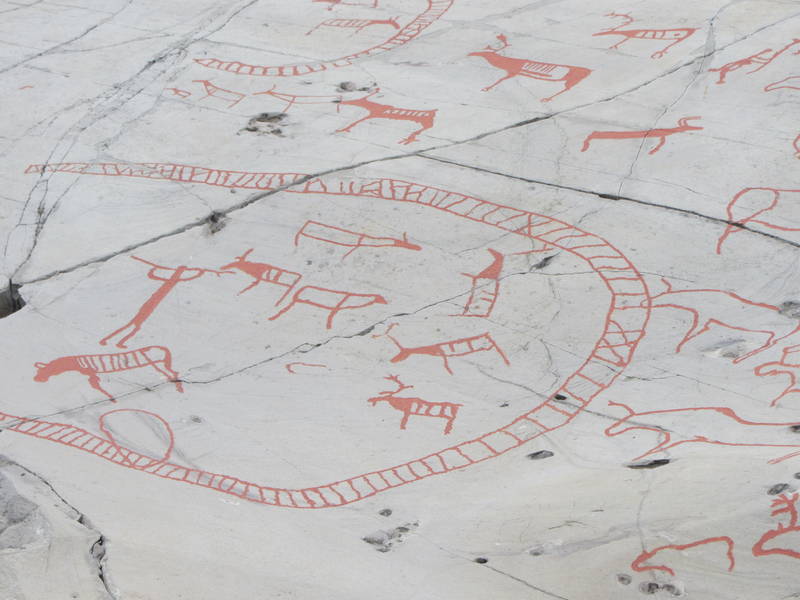
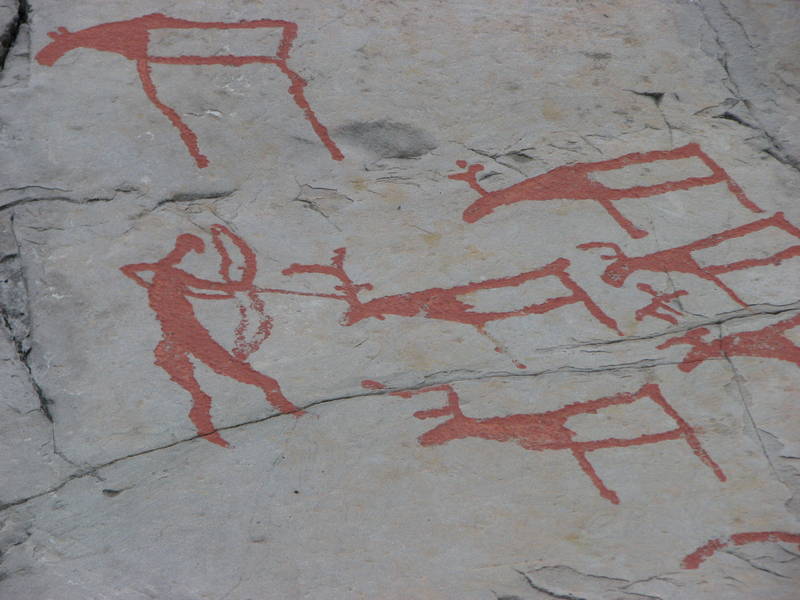
Ekke's GPS found us a campground, this one with a Sami settlement nearby. Perhaps the Sami tents were set up for us tourists, but we really enjoyed experiencing the culture. A restaurant was set up in one tent, with reindeer hides to sit on, and reindeer stew to eat. The reindeer tasted much better than the canned version we had tasted before. They also had a few artefacts for sale and some traditional clothing on display.
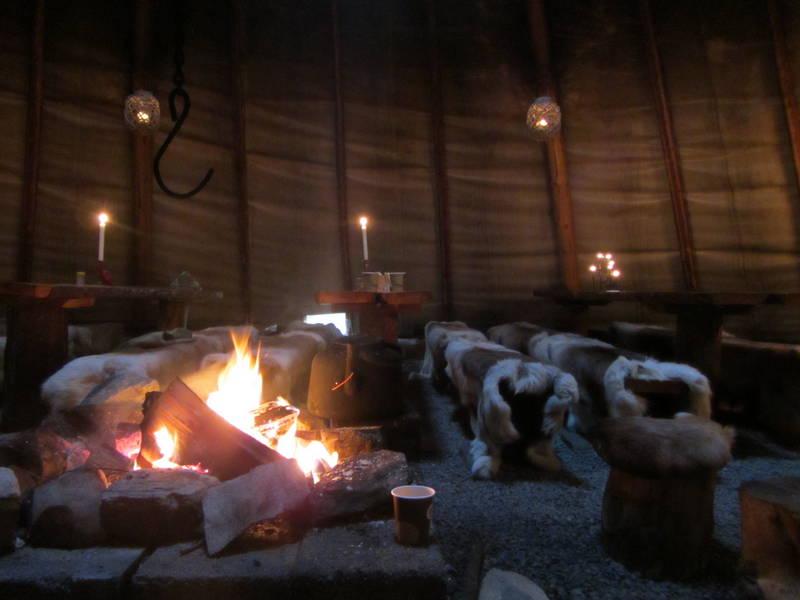
Tucking into a reindeer stew
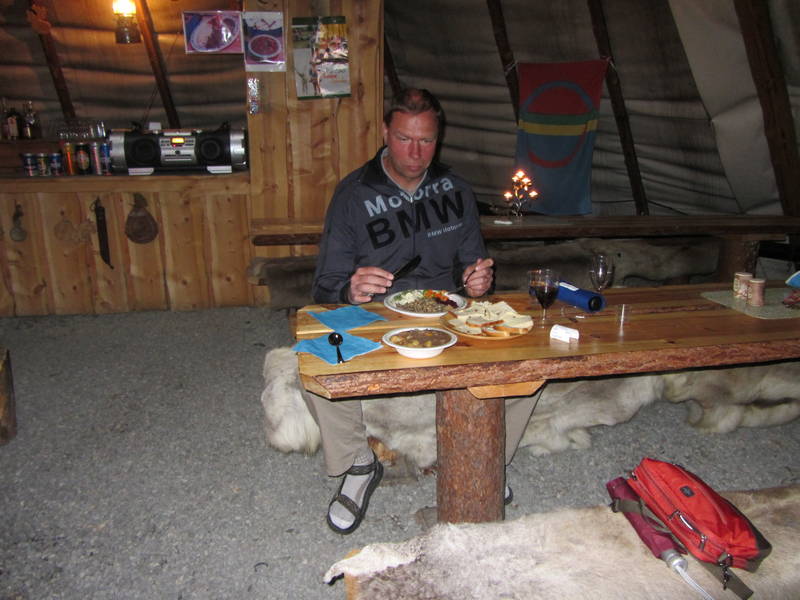
The Alta River Campground was aptly named: The place was a veritable river the next day. The rain looked as if it wouldn't stop, so we just packed up, staying as dry as we could in the process. The Gore-Tex boots worked really well when we had to wade in shin-deep water from the tent to the bikes. It was great to have a kitchen area to put on all of our gear. After stopping at a Statoil for gas and a raisin boller bun, we rode for 80 km before stopping at a cafe to dry out. It pretty much rained the whole day, but we'd learned a different technique for our overmitts - put them under the jacket sleeves. The first glove was easy to put on, but for the second one, an obliging tourist came to help us. We rode through more rocky landscapes, sometimes near short, stunted trees, often beside long fjords. We had seen our first real reindeer the previous day, but on this day, we saw so many of them. They are the same species as the caribou in Canada, which we had seen before. But the subspecies in Norway, we both agreed, look a lot more like the reindeer of popular culture, that is, those that pull Santa's sleigh. They were on hillsides, on the beaches and on the road. Other wildlife that Lonely Planet had warned us about were swarms of mosquitoes. We didn't see a single one.
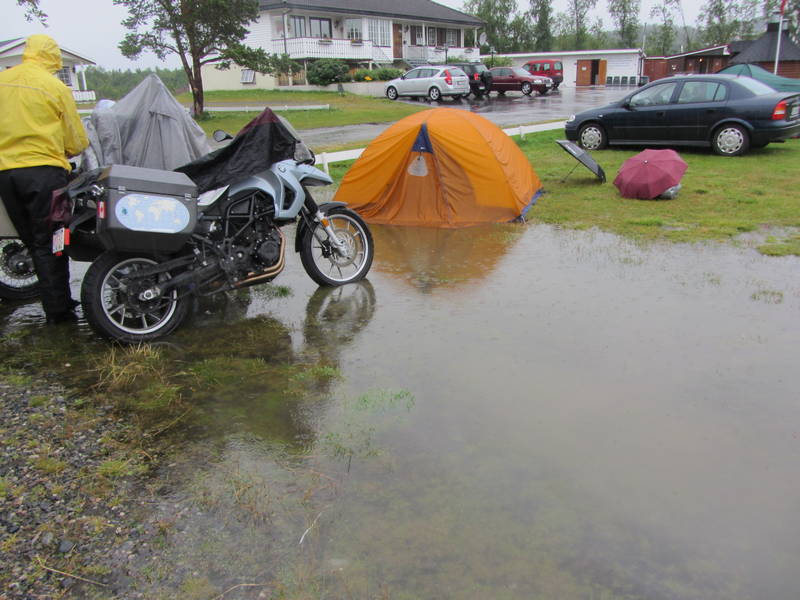
Not many reindeer on our way up to Nordkapp
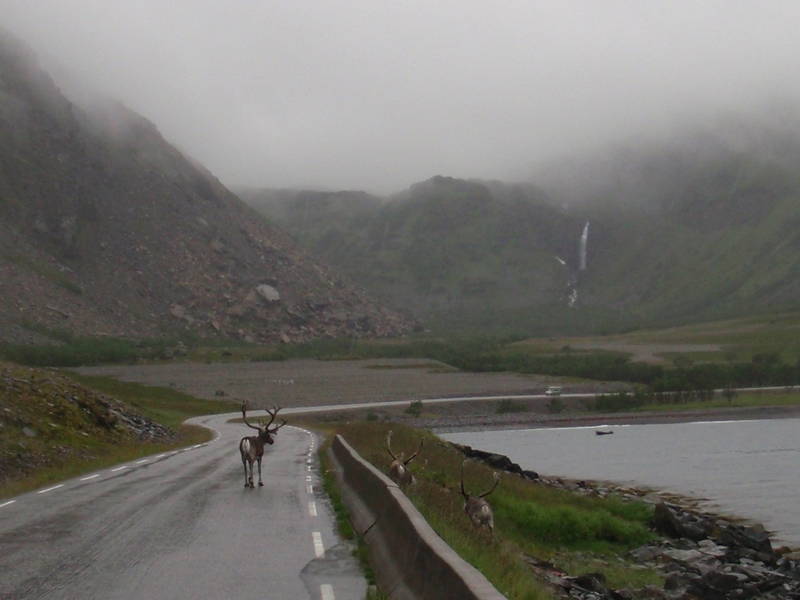
I nearly cried tears of joy when I saw the sign for Nordkapp, or North Cape, our most northerly destination at 71 degrees north. We had come so far. But it was like something was conspiring against us on the final leg of the trip to throw everything in our way to try and stop us from getting there - howling winds that threatened to push us off steep drop-offs, huge tour buses that claimed the entire road, thick fog and driving rain that meant we could see nothing, expensive toll-roads and tunnels. The fog thickened and our speed was barely a crawl. But eventually we came to that over-priced toll-booth that would let us into the most northerly point in Europe. 230 kroner, or $50. Each. Well, at this point you just pay the money. We had also paid 70 kroner to get through the final tunnel and would pay that again on the return trip. We rode into a rocky parking lot, got off the bikes, and looked around. We could see nothing. The fog was so thick that we could only see ourselves and a few other vehicles parked nearby. We'd made it to Nordkapp but, in the end, didn't know where it was. Eventually we made out the outline of a building in the distance, through the fog, and went over to have a look. A sign on the structure indicated that it was a private dwelling. Now what? Thank goodness we saw some people walking toward us, and knew there was something in that direction. Bracing ourselves against howling winds and driving rain, we put our heads down and walked.
What a miserable ride
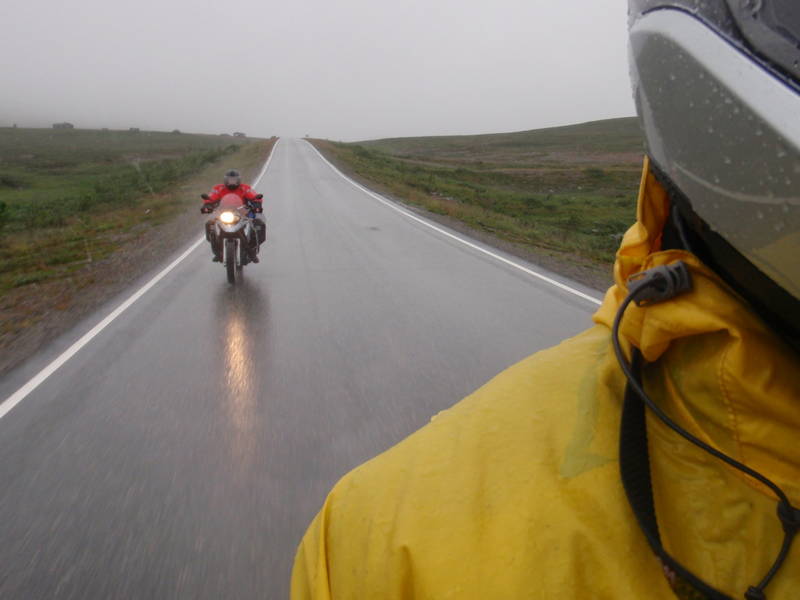
When we eventually found the visitor centre, it turned out to be a beautiful, modern building, with eateries, gift shops and displays. We immediately commandeered an entire coat rack for our wet gear. We sat around, savouring our accomplishment at making it here on motorcycles, which was only slightly diminished by the bicyclists who had also made the trip. We wrote a few postcards from Europe's most northerly point, and mailed them on-site. There was a film showing Nordkapp's people, wildlife and landscapes in all seasons of the year, and it was so well done that we had to purchase our own copy of it. Dioramas showed early visitors to the area, and how a visit by King Oscar in the late 19th century made the place a tourist destination. After a lovely fish stew for lunch, we decided we'd better brave the howling winds and get the obligatory photo by the big globe statue. It was just us two, enjoying the solitude beside the globe at the top of Europe. A cloudy, foggy day at Nordkapp does have its advantages.
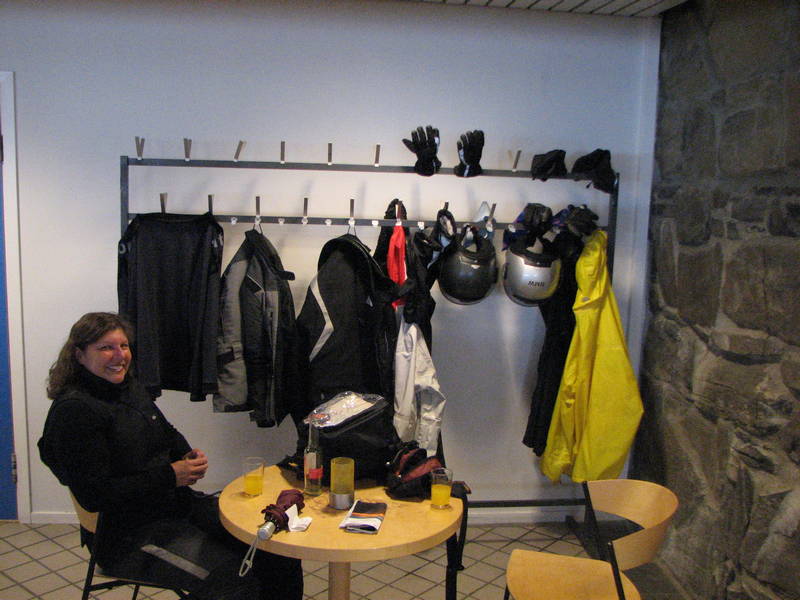
Having lunch while our stuff dries

Enjoying the view from the restaurant at Nordkapp
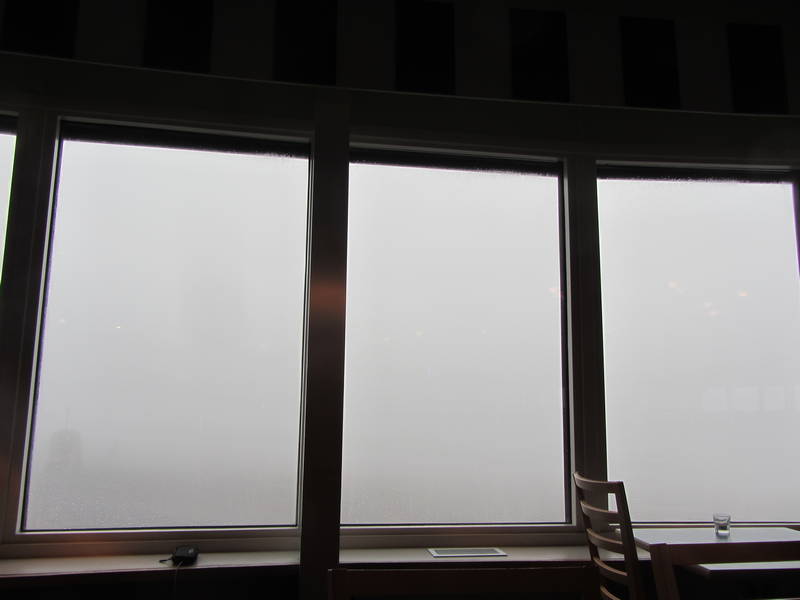
Eventually we brave the elements and head out
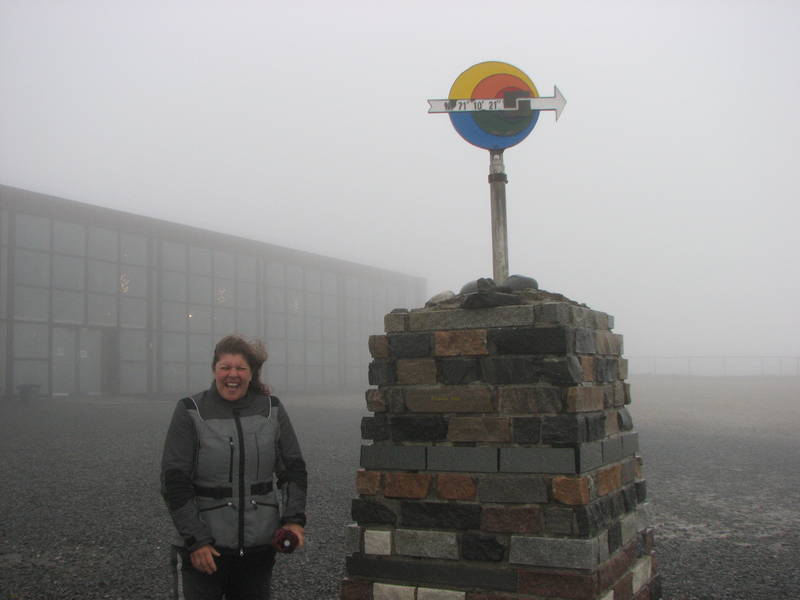
The classic photo
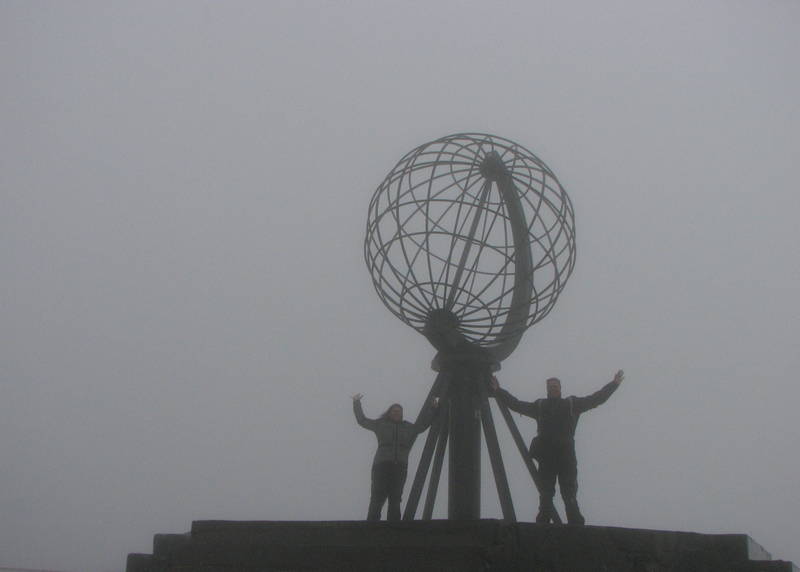
After rejecting an opportunity to pay 1440 kroner, or $280 for a night at the Rica Hotel, we opted for a camping cabin for $160. It was big and luxurious and so warm and dry. We also got to pay $20 each for a meagre breakfast the next day. There was no fog or rain that morning and we took a few pictures of Nordkapp from a distance, glad to be able to see what it really looked like. We debated for a moment whether it would be worth $100 to go the short distance back North and actually see Nordkapp but then decided that the only direction to go was south. A 657 km riding day lay before us. The shortest distance was back through Alta, and the ride was pleasant and dry. It was a great opportunity to get some photos of the bikes beside herds of wild reindeer.
Another warm dry cabin
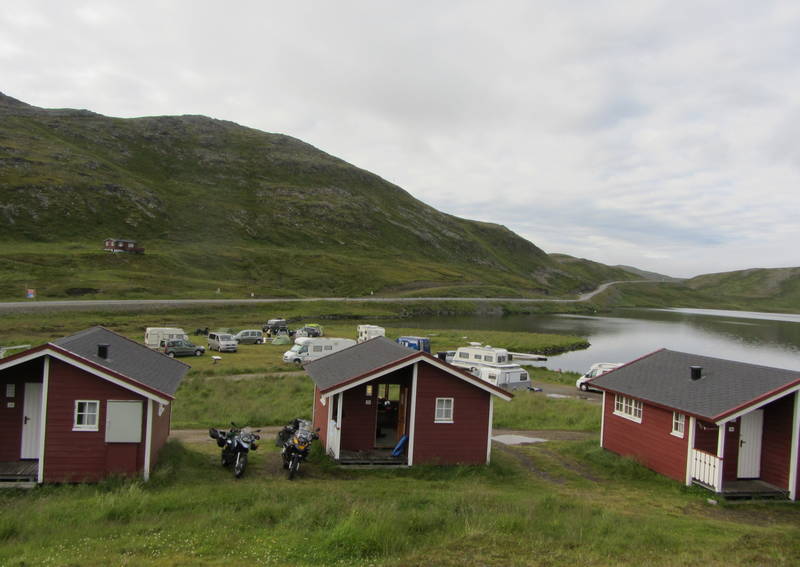
A 100 Kroner breakfast
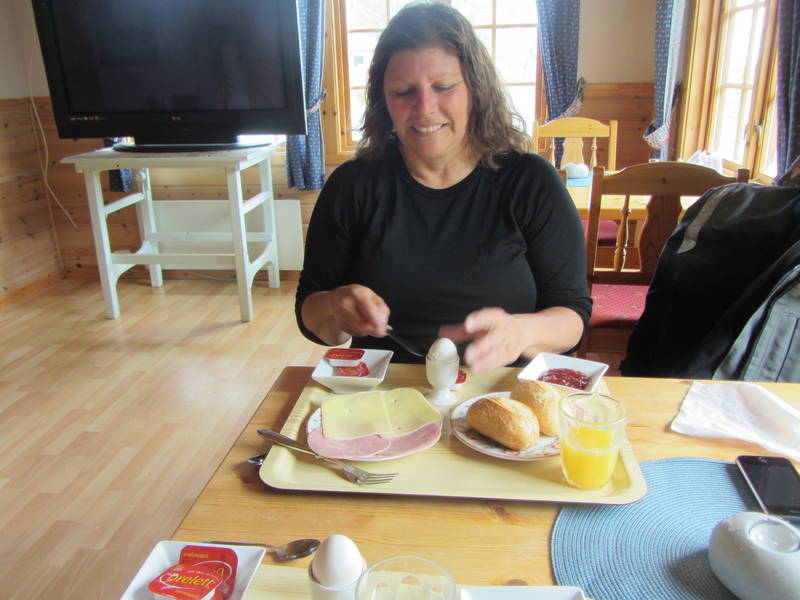
Nordkapp in the distance

The reindeer came out to play their reindeer games when the weather improved
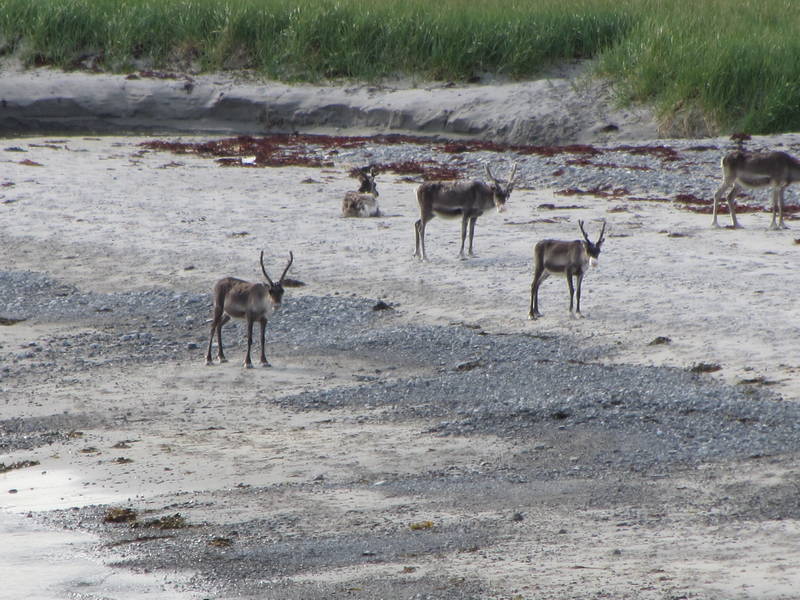
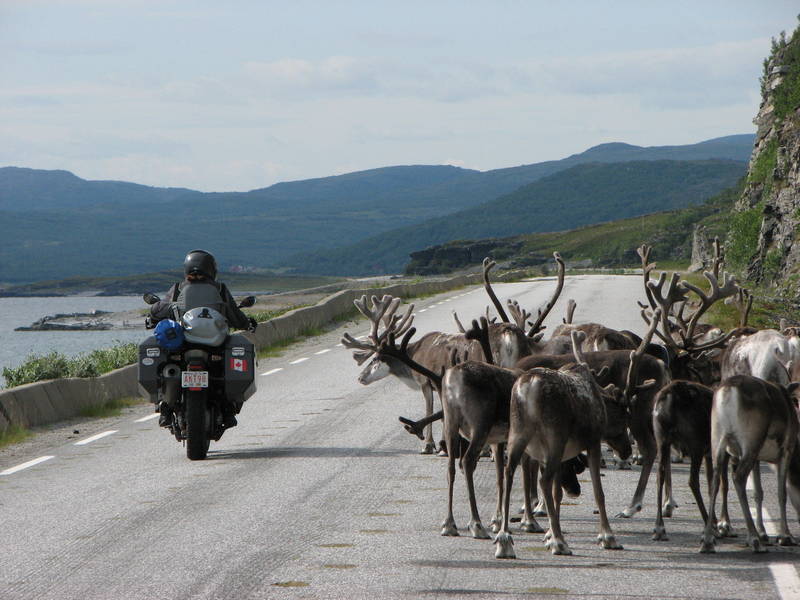
One of the games involves hiding in tunnels waiting for motorcyclists
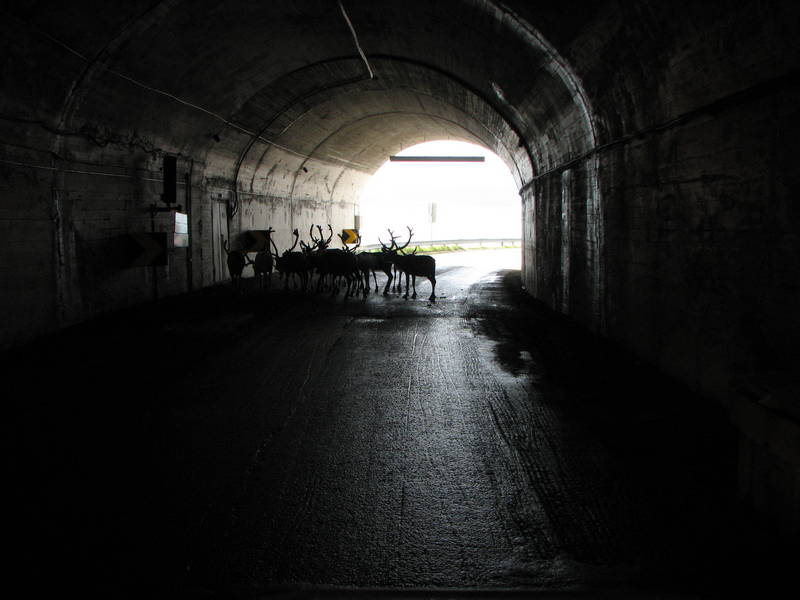
After riding a shortcut around Alta, things really warmed up and we even had to shed clothing. The trees were really leafy, quite unlike the arctic landscape we had been in earlier in the day. I believe the higher temperatures are due to the warm Gulf Stream winds. We crossed into Finland early in the afternoon and found a quaint farmhouse cafe. The artwork on the walls showed Sami people in traditional dress, hunting reindeer. I took some photos of them, hoping to find a hunting dog that resembled a Norwegian Elk Hound that we know, back in Canada. That night, we went out for pizza. We were used to paying so much for food in Norway that we bought the 13 Euro pizza ($18), hoping it would be enough. It turns out that 13 Euros worth of pizza in Finland could probably have fed a small army and we couldn't finish it.
Crossing back over the Arctic Circle the next day was uneventful. We were at a lower elevation, so the landscape looked like it could be from anywhere in central Alberta. Soon enough we were in Sweden, riding south near the Gulf of Bothnia and put in another 657 kilometre day, exactly the same as the day before. Speed limits increased in Finland and Sweden, so it was easier to make good time. The camping was a lot less expensive than in Norway, and even nicer. We were near a lake with a sandy beach, and the place was packed with locals on vacation. Someone had attached a motor and wings to a dinghy and was flying it around, over the lake which made for some good evening entertainment.
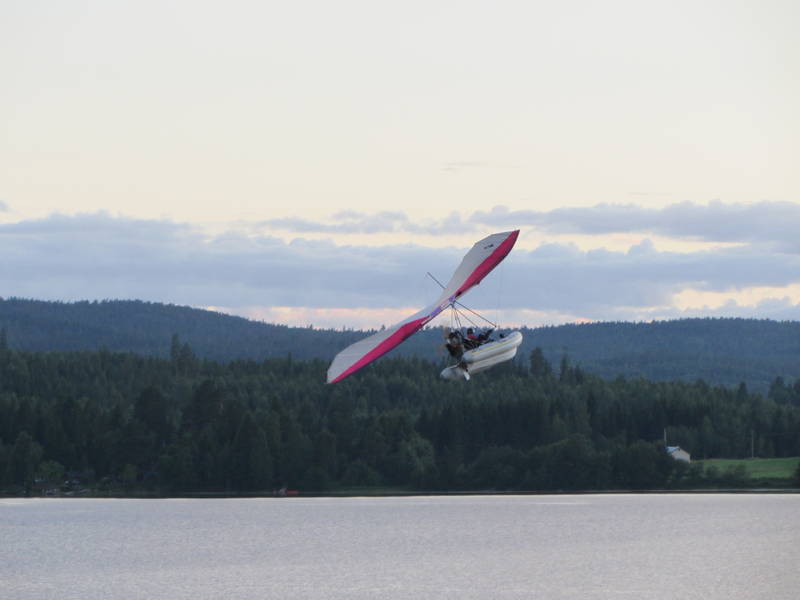
Ekke Writes:
We had used a lot of our time getting to Nordkapp and now had to rush south in order to get to a wedding on time. So we took as many highways as we could, and arrived in Stockholm in the late afternoon of July 28. There was nothing to be seen but tennis courts and some construction at the campground location that the GPS guided us to. So we rode around for a little while looking for any signs of a campground and eventually decided to try another camp on the other side of the city. It was a hot ride in heavy traffic but we made it to Angy Camp and got set up before a bus load of young Australian tourists commandeered the laundry facilities.
The next day we took a bus to Drottningham palace and after a cup of coffee at the gift shop wandered the grounds. An interesting tour of the inside of the palace itself really gave a good overview of Swedish royalty and its interesting dynamics over the centuries (no photos allowed). After the tour we took boat ride from the palace grounds to Stockholm proper. We walked to Riddarholmen, the historic nucleus of Stockholm. The oldest building, Riddarholm church, was inaugurated in the year 1300, about 50 years after the founding of Stockholm. Delicious Panini sandwiches were available at a stand outside another palace in the Riddarholmen. There seem to be quite a few palaces here. A one hour harbour cruise was a relaxing way to see a lot of the city. We had a quick bite to eat at a 7-11 (very popular in Sweden and they have delicious raisin buns) and then took the subway back to camp. Of all the cities we visited on this trip to Scandinavia, Stockholm is definitely one we need to return to as there is so much to see and do that we barely scratched the surface.
Drottningham Palace outside Stockholm
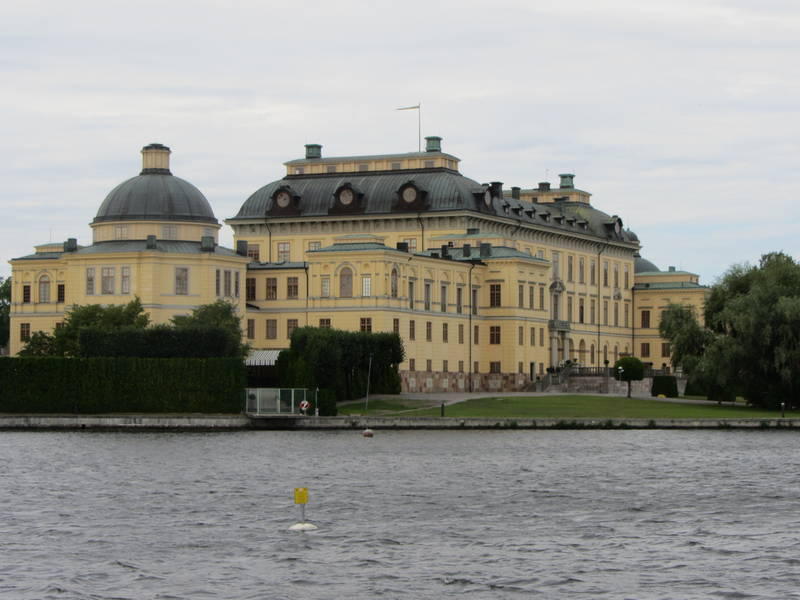
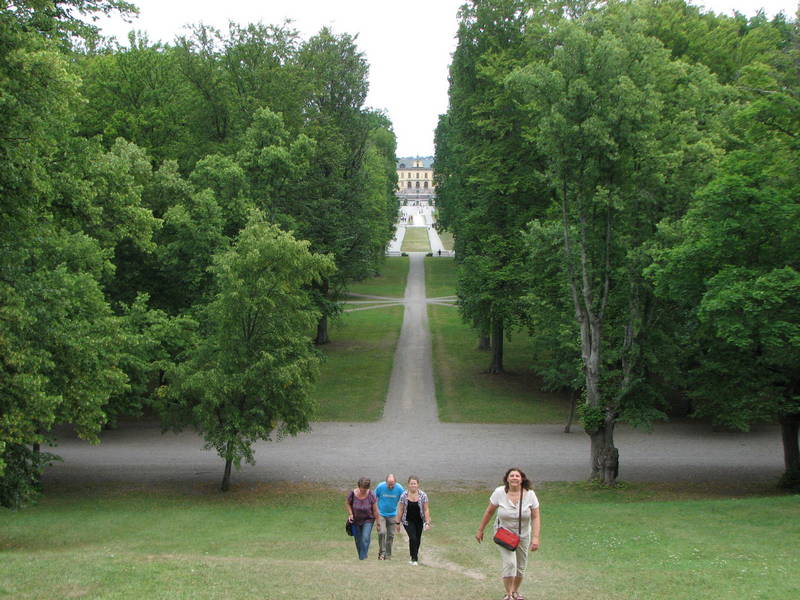
Security is tight as even the guards need guards
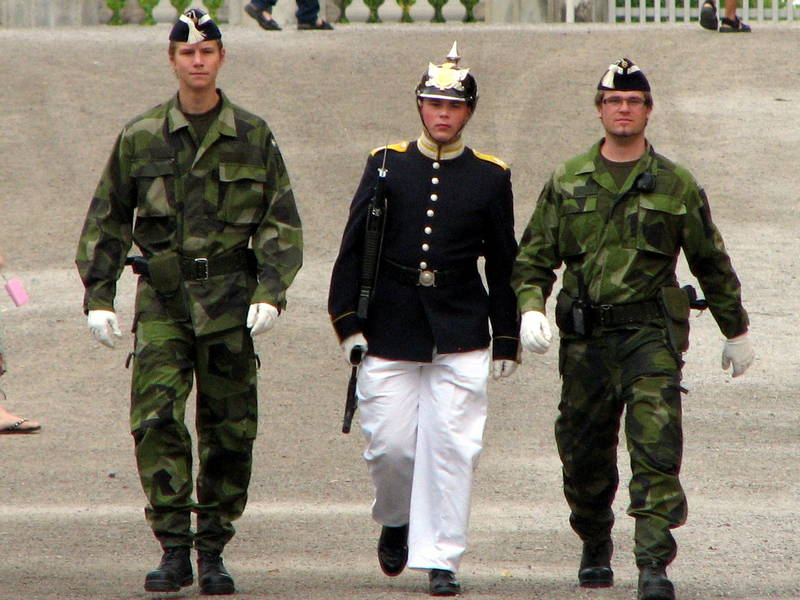
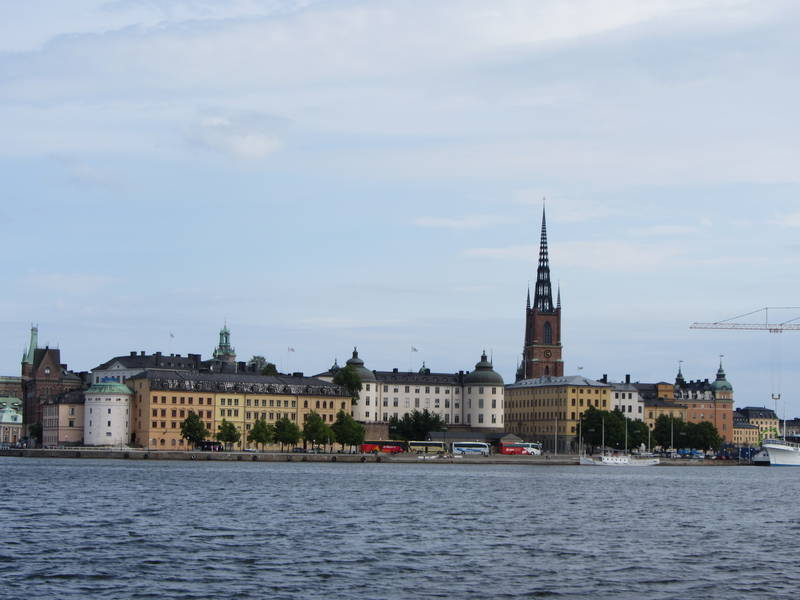
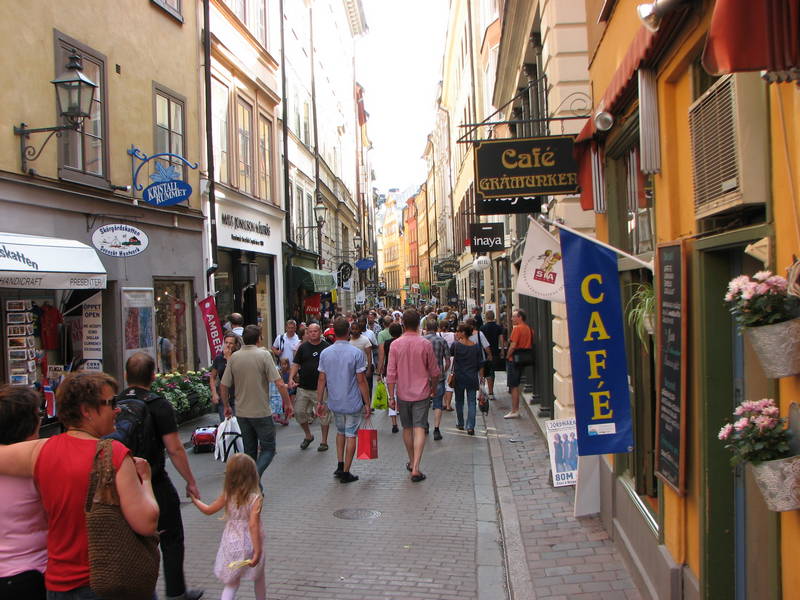
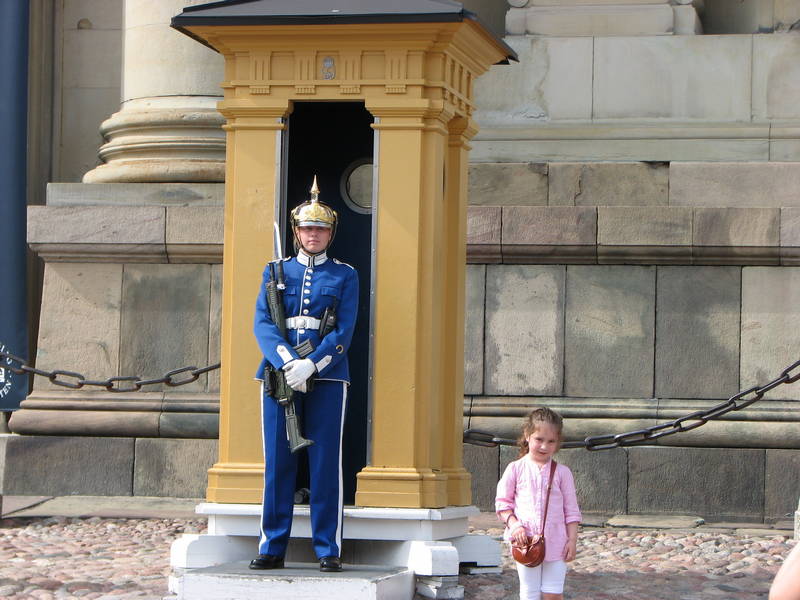
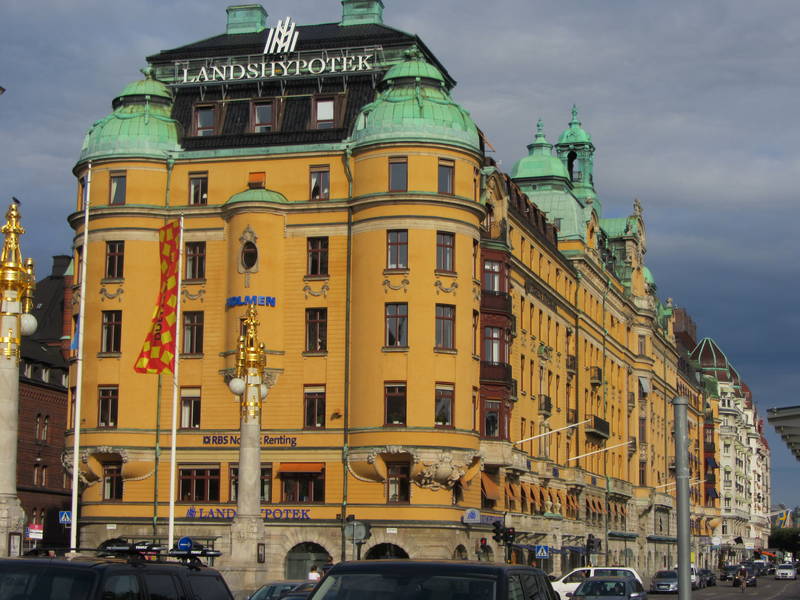
We zoomed southwesterly across Sweden from Stockholm, enjoying a tail wind, and caught the ferry to Helsinor. It was only 430 Kroner for both bikes (about $60) and we had a great view of the Helsinor castle made famous by William Shakespeare in Hamlet. Another place we'll need to come back to. We rode in a light rain back to Absalon camp in Copenhagen and popped into the Kvickly supermarket to buy dinner supplies just before they closed.
Helsinor Castle
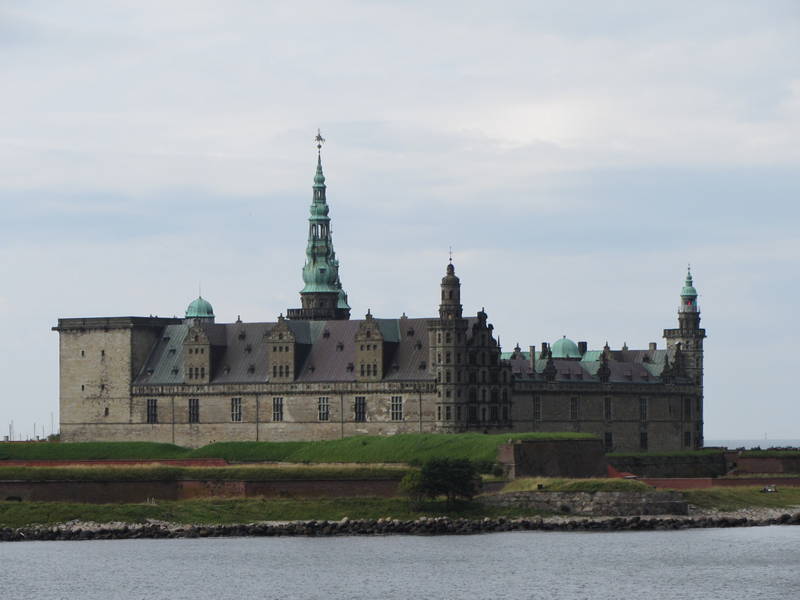
We left Copenhagen and rode south to catch the Rødby to Puttgarden Scanlines ferry which at 730 Kroner for both bikes was quite expensive for a 45 minute boat ride. We arrived in Hamburg in the early afternoon and parked the bikes on the sidewalk, dwarfing a scooter. Boat tours of the Alster departed only a few steps from our parking spot and the boat allowed us to see idyllic residential mansions while remaining relatively dry. The rain had let up when we returned and we strolled around the heart of the city ending up at beer gardens set up in the square in front of the Rathaus (city hall) for a late lunch of spätzle and goulash. Afterwards we walked to the harbour, wow, it was enormous and obviously a major shipping port. A boat tour here would have been very interesting but we had already spent our time and money on the boat tour of the Alster. Leaving Hamburg we found a campground located about 40 kilometres south.
They'll never notice the two Canadian motorcycles parked by the scooter
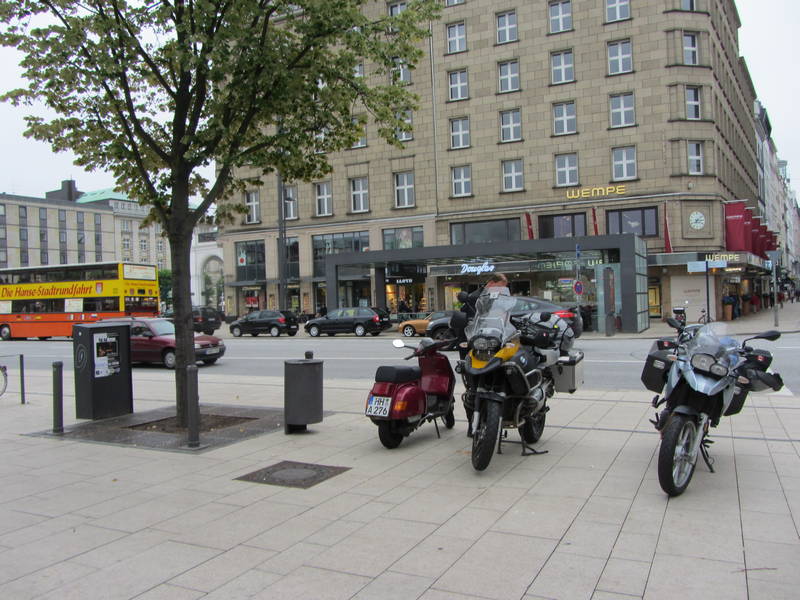

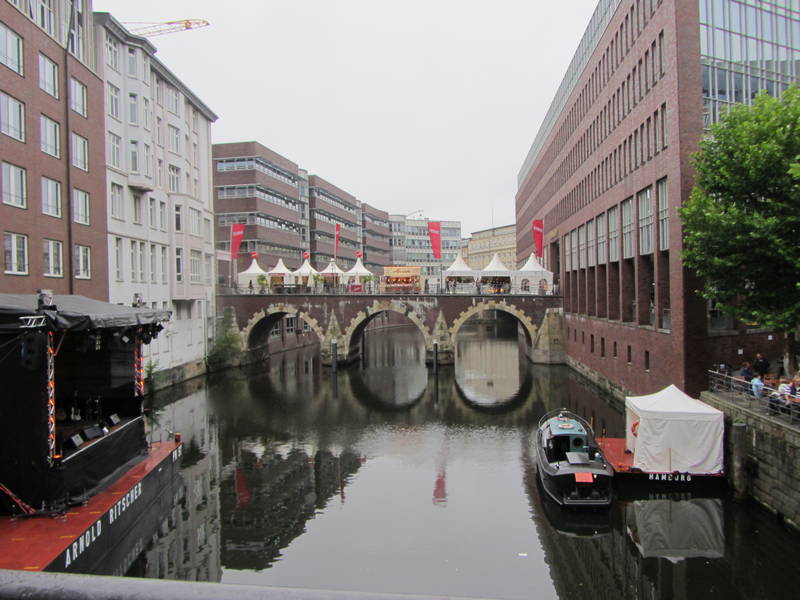
The first day of August we zipped along the autobahn (top speed on the GPS indicated 167 kph) southeast to Nurnberg. Riding at those high speeds was really tiring though, so we ended up stopping fairly often and it wouldn't surprise me if with a slower pace we might have made better time. We arrived at camp and set up the tent in a big grassy field that a tractor was busy mowing. Camping in Germany is so civilised that every campground seems to have a high quality restaurant. This one was no different as we enjoyed cordon bleu and schnitzel in the courtyard of the on-site cafe.
Ekke checks out a Messerschmidt at a gas station restaurant but decides to keep his motorcycle for the headroom
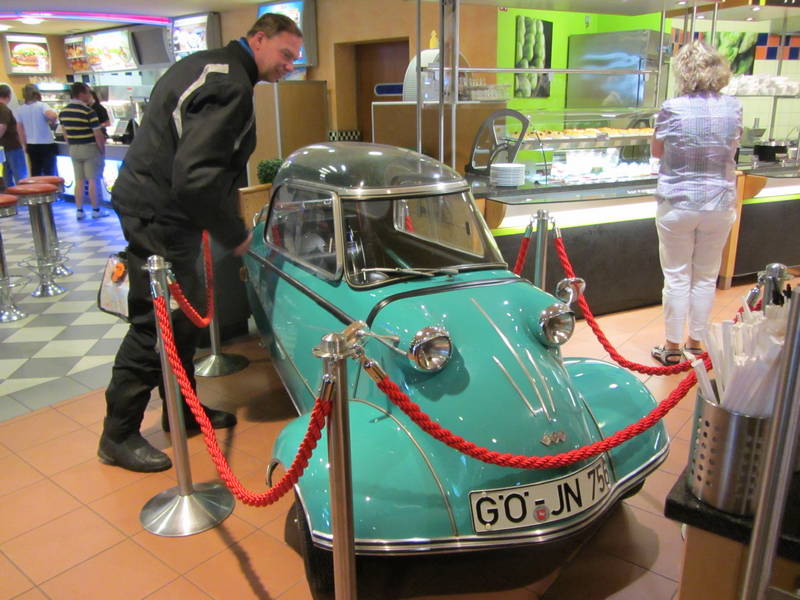
Our last day on the road, August 2, started off foggy but cleared up quickly. This gave us an opportunity to make sure everything was completely dry before packing it away. We wanted to make sure that everything packed away nicely to put in storage for an entire year. By 11:30 we were all set and started riding towards Neufinsing where Karl Maier BMW was located. The road to Freising, where I was hospitalised in 2007, was simply wonderful after being on Autobahns for the last couple of days. Audrey mentioned that her new F650GS really seemed to be made for these roads as it effortlessly arced through curve after curve. In hindsight, with the BMW headquarters being so close by in Munich, perhaps it really was made for these roads. We stopped by Gästehaus Huber in Schwaig, where we had lived for four months, but there was no answer at the door so we continued on to Karl Maier BMW. There we tried to make an appointment to have an oil change performed prior to putting the bikes in storage but they didn't need one. Instead they simply did it while we waited. Great service! Stopping off at Gästehaus Huber on the way back we were delighted to get an answer at the door and were promptly invited inside for lemonade. After a great time getting caught up with each other we rode to Kronwinkl where Audrey's family had already arrived in preparation for the wedding on Friday, August 5.
Home Sweet Schwaig

The room at the lower right was ours for four months in 2007
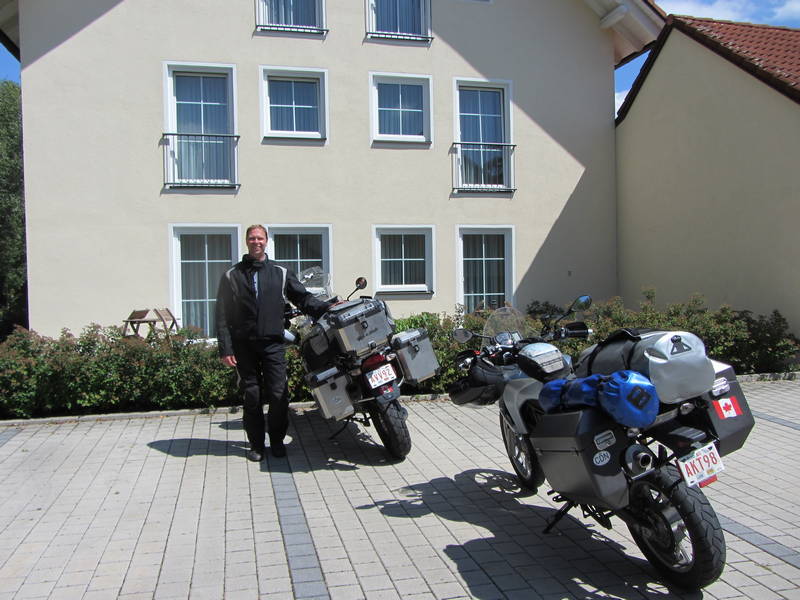
Helena welcomes us to their home
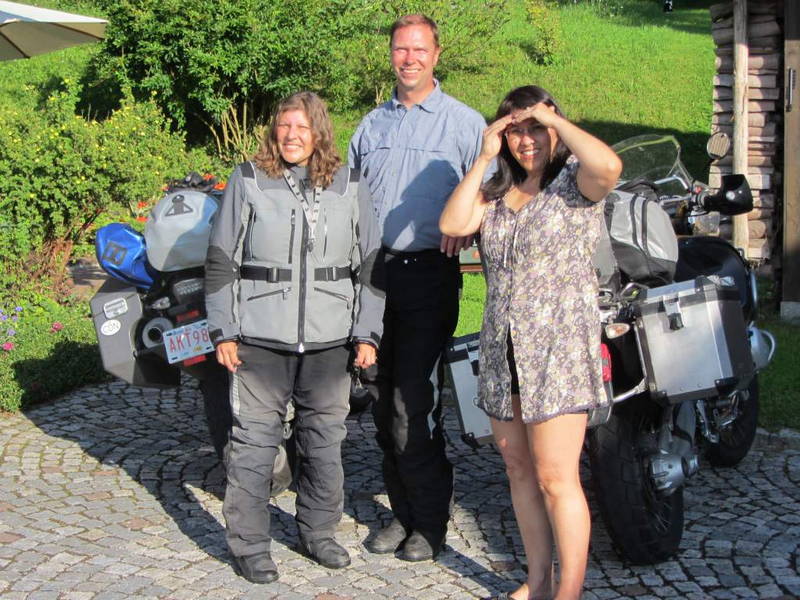
It was a blur for the next few days as we prepared to put the bikes in storage (at Willi's mom's garage) and got ready for the wedding. The wedding itself on Friday was absolutely beautiful, first with a civil ceremony at the town hall followed by a church ceremony and then a reception at the hotel in Kronwinkl. Peter Munro had managed to obtain a Rolls Royce Ghost for the wedding and, unbelievably, agreed to get up early Saturday morning to take me to the airport in it. Wafting down the autobahn at 235 kph was a real highlight of the trip. Thanks Peter!
The civil wedding ceremony takes place at the town hall; Andrew, Helena, Willi and Robin
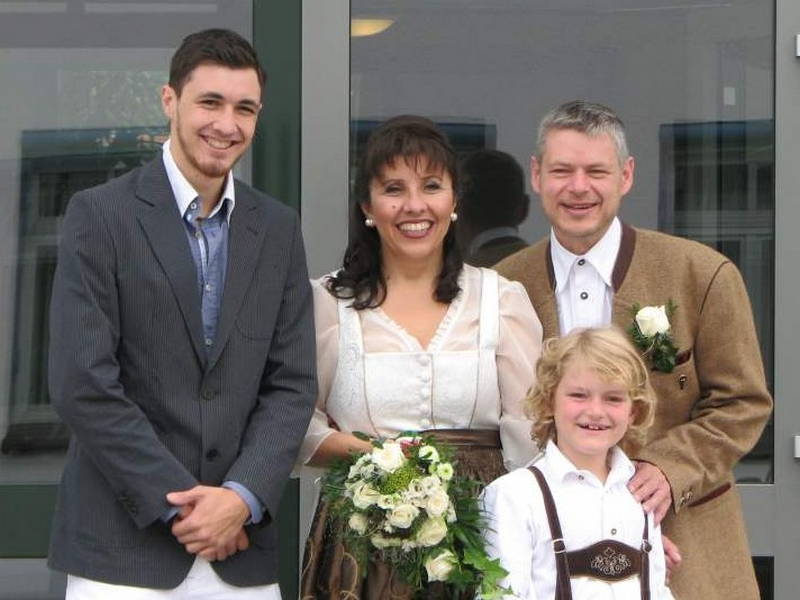
Peter Munro arranged a Rolls Royce Ghost for the wedding car
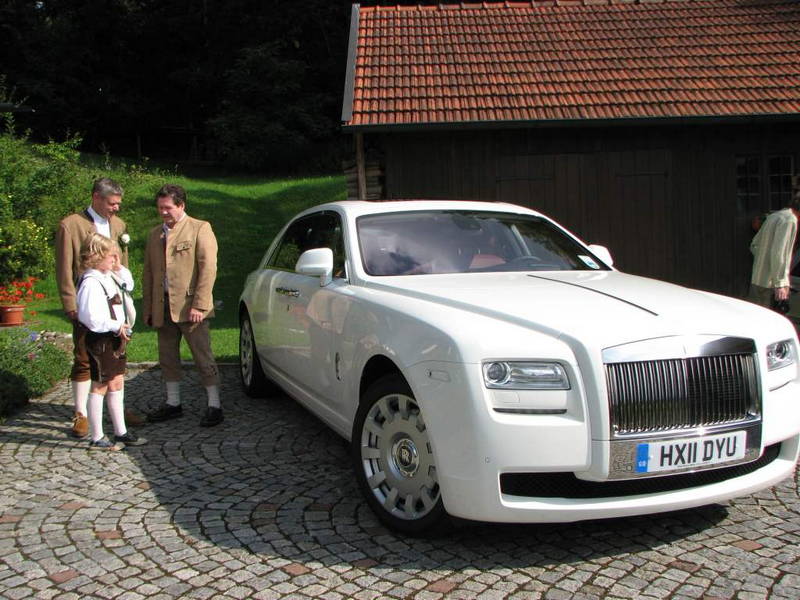
As I went back to work, Audrey stayed an additional week and toured Bavaria and Austria with family and friends. The bikes were tucked away under covers, waiting patiently for the next leg of the journey starting in 2012.
Map of our trip to Nordkapp
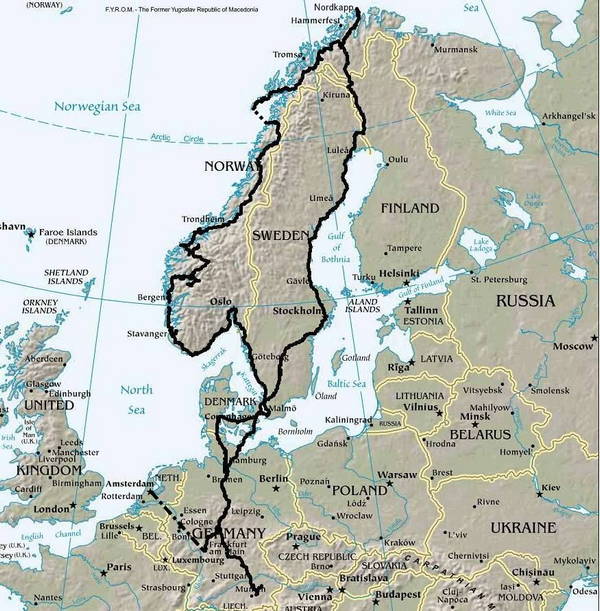
Home / Norway | 2011
Norway | 2011
Ekke writes:We have another leave of absence lined up for 2012 at which time we plan to ride from Germany east across Russia to Japan and back via Southeast Asia. When Audrey's sister Helena (who lives near Munich) mentioned that there might be a wedding in the offing for the summer of 2011 we immediately thought of the possibility of flying our bikes to Europe, having a great summer vacation, enjoying the wedding and then storing the bikes in Germany until the summer of 2012. That would mean one less hassle before our departure in 2012 and an opportunity to finally ride to Nordkapp, Norway after the failed attempt in 2007 (See the Africa Section).
The Motorcycle Express website (a company that specializes in shipping motorcycles between North America and Europe with air cargo) showed that they would be able to fly our bikes into Amsterdam and checking Expedia.ca indicated that KLM now offered direct flights from Calgary to Amsterdam. Perfect, we could then visit relatives in the Netherlands, head north to Norway and return to Germany for the wedding. The KLM flights were booked early in order to secure the best possible price. A couple of months prior to departure we contacted Motorcycle Express to arrange the shipment to Amsterdam and were taken by surprise when we learned that their website had not been showing the most current information. Schiphol no longer took Dangerous Cargo and so Motorcycle Express couldn't ship our bikes there after all. What a rookie mistake from a couple of veteran travellers. Always arrange the motorcycle shipment first since it's easy to fly people anywhere in the world but bikes are a bit more difficult. The closest destination to Amsterdam that Motorcycle Express could take the bikes was Frankfurt and since it was quite expensive to change our flights with KLM we took the opportunity to arrange for a train ride from Amsterdam to Frankfurt.
A few days prior to departure we dropped the bikes at YYC Freight Services. Audrey dropped the F650 one day and the next day I rode the Adventure to the airport, making sure that the bikes were on reserve. We really hoped that we could store all of our camping gear in the hard luggage of the bikes and when we asked they said it would be no problem at all. We simply disconnected the batteries and left the bikes with YYC Freight Services to put on to the next flight to Frankfurt. On Saturday, July 2, we drove our car to Airdrie to leave at my parent's house (they were away on vacation) and then called a cab to take us to the airport where we boarded KLM's "Ingrid Bergman" for a pleasant flight to Amsterdam.
Audrey at YYC Freight Services dropping off her bike for shipment to Frankfurt


We flew KLM while our bikes went on Air Transat

Oom Alle picked us up at Schiphol Airport on Sunday morning and brought us back to his apartment for a great breakfast. My uncle is quite the traveller so it was fun getting caught up on his latest trips. In fact, that afternoon he was going to a concert in Belgium (isn't Europe great?) so we walked to the local train station together. He went one way and we took a train the other way, towards downtown Amsterdam. We knew that the best thing for jet lag was to get outside in the sunshine and get as close as possible to the current time with our biological clocks as soon as possible. So we were determined to stay awake and be active. At Centraal Station we started walking. And walking. It was a beautiful day and we were in a great city for walking but it was getting increasingly difficult to stay awake. A lengthy break at a cafe rejuvenated us so that we could continue exploring. Later in the afternoon we found ourselves sitting on a dock beside a canal enjoying the sunshine. When I fell asleep and nearly tumbled into the canal we thought that it was about time to head back to my uncle's apartment. Once we collapsed on the train we had to prod each other every now and again in order to remain awake and get off at the right station. A few more feeble attempts to stay awake were made but in the end, resistance was futile. We made it to about 8:00 PM before falling into bed and didn't hear oom Alle return later that evening.
Oom Alled at Schiphol


Ekke almost falls into the canal...

OK, how can they be the Sauce Masters but the price does not include the sauce???


After breakfast on Monday morning oom Alle drove us down to the Centraal Station (easier than taking the commuter train with our entire luggage) and we hopped on board an Intercity Express train bound for Frankfurt, arriving in the early afternoon. We weren't planning to pick up the bikes right away, especially since we were still a bit jetlagged, but we did have to pick up the European insurance. So after taking the short cab ride from the train station to the same Ibis Accor hotel we had stayed at in 2002 we used the GPS to walk to the nearest ADAC (German automobile club) store. In 2007 insurance was 22 euros per month per bike so we were floored by the new price of 105 euros. Since I was flying back to Canada on August 6 we needed a month plus a couple of days of coverage. At 22 euro we would have happily paid for an entire extra month for those few days but at 105 it didn't make a lot of sense (105 x 2 euro = $320) so we planned to put the bikes in storage a few days earlier than anticipated. From the ADAC office we walked to the nearest BMW motorcycle store so that Audrey could purchase rain gear. She had mail ordered new rain gear in Canada but a postal strike meant that we didn't receive it before we left home. A stroll along the river Main, stopping for dinner at a riverside café, brought us back to the hotel ready to collapse into bed after a fairly full day.
Altstadt Frankfurt am Main


Audrey tries out for the FIFA Women's Football tournament but finds the ball a bit bigger than it looks on TV

Rock band am Main
Tuesday we finally hit the road. We walked up to the train station and took the S-bahn to the airport where we hired a cab to drive us around to the cargo terminal. Again, super friendly people helped us through the process of getting bikes out. After an hour or so the bikes were brought out by a forklift and we could free them. We worked slowly and methodically so as not to injure anyone this time around. We rode back to the hotel in time to check out, loaded our stuff on board (will we ever learn not to overpack?) and wobbled out of Frankfurt, heading north. As Audrey's bike was well and truly onto Reserve we needed to find a gas station right after we got out of the city but that was a bit of a challenge once on the Autobahn. We ended up doing a U-turn to get back to a Shell on the other side of the highway. A great restaurant (it seems all German Autobahn restaurants are great) gave us some respite from the heat before going back north. 150 kilometres further up, while stopping for a drink, we decided to use the GPS to find the closest campground. Finally, off the Autobahn, we enjoyed 25 kilometres of small, winding roads through picture-perfect German villages to get to Frielendorf and a lovely campground. We took stock of our stuff and decided to mail to Helena the helmet bags and other gear we had needed for the airplane ride. I also thought that with the 30 degree heat a down-filled jacket was just taking up space that I could use for carrying important things like Nutella.
Carefully taking the bikes off the pallets at the cargo terminal


Our favourite hotel in downtown Frankfurt, cheap, clean and central

An autobahn gas station restaurant

After a typical (for us) German breakfast of fresh buns with Butterkäse (literally butter cheese) and Nutella we stopped off at the local post office in Frielendorf and sent the package south. A lovely ride through the countryside got us back on the autobahn towards Hamburg where we were greeted by a traffic jam. Traffic jam sounds so nice. I think the German word "stau" has a more unpleasant sound to it and more accurately reflects sitting in heavy traffic on a hot motorcycle. In any case, once clear of the stau and out of Hamburg the sky got darker and darker but it was quite warm and we didn't want to get into all the rain gear just to get soaked with sweat. Just a few kilometres from the campground we had chosen, while sitting at a railroad crossing waiting for a train, the skies simply opened up. We were instantly drenched. Amazing. We must have looked like drowned rats as we sloshed into the camp office and stood dripping in front of the counter. Rather than putting up the tent in the rain we hopped on the bikes and went out for supper which, except for nearly losing Audrey on the entrance to the autobahn and the GPS leading us down a dead-end, muddy path, was eventless. That evening, as I was laying my head down on a jacket and pile of clothes, I thought to myself, "Who thought it was a good idea to send away the fleece-lined pillow case and down-filled jacket?"
July 7 dawned foggy but dry so we packed up the wet tent and headed to a roadside stop for breakfast. The crossing into Denmark was a bit too uneventful and it wasn't even possible to take a photo at the border as we crossed into a new country. After paying a 155 kroner toll we took a beautiful bridge across the Storebælt and onto the island of Zealand where we stopped at the town of Køge to look for a cash machine. Køge had a beautiful medieval town centre with half-timbered houses, a cash machine and delicious ice cream. After wandering around while licking ice cream cones we jumped back on the bikes and rode the remaining distance into Copenhagen and to the Absalon Campground arriving at about 6:00 PM.
Crossing an 18 kilometre long bridge to Zealand in Denmark


Køge

Audrey writes:
We stayed at the Absalon campground in Copenhagen and took the train into the wonderful city for a day of sightseeing. Our umbrellas came in handy for some torrential showers and we slipped into the Nationalmuseet to escape the rain. The Viking artefacts were fantastic, with plenty of cauldrons, horns, jewellery and weapons and the treasures were really quite advanced with sophisticated designs and decoration. Giant rune stones were very impressive, painted with runic inscriptions that had marked graves or important events such as when King Harald Bluetooth brought Christianity to the region. What a thrill to look at oak coffins that still contained remains of important Danes and had undergone a preservation process similar to mummification, with clothing and jewellery still intact.
National Museum




It was fun just walking around and enjoying the palaces and monuments built by great Danish kings, the oldest monarchy in Europe. Our favourite area was quayside Nyhavn with its pastel-coloured canal-side townhouses from the 17th century. Sailors had frequented here, enjoying beer and other activities, but now restaurants and shops had taken over. As it was still raining, we caught a harbour boat tour, the one with the roof. The scenery was beautiful but the most entertaining part was when a couple of tourists got pretty excited when any new sight was announced: the best restaurant in the world, Amelienborg palace, the opera house. When the tour guide announced that the Little Mermaid was up ahead, they went completely ballistic, screaming in delight. From the boat, we saw the back of the famous mermaid and I was, quietly, delighted. The sun eventually came out, which made a walk to Rosenborg Slot castle, the Latin Quarter and Tivoli gardens quite pleasant. The Tivoli is an antique amusement park, and a lot of it took us back to the Victorian era. The modern roller-coasters have now taken over.



An excitable tourist...

... who went completely insane at the sight of the Little Mermaid






With no groceries with us, we searched out some fast food for breakfast. I don't think McDonald's breakfasts have caught on in Denmark as the McDonald's near the campground wasn't open in the morning. In fact, the next day in a McDonalds in Sweden we saw an illustrated pamphlet explaining what an egg McMuffin was. So we just continued riding, through a four km long tunnel and over the Oresund bridge. The 8 kilometres of bridge cost us motorcyclists 160 Kronor ($28) each. This was the first of many costly bridges, toll roads and ferries that we would encounter on the trip. Getting around Scandinavia by highway is expensive. At a little rest area in Malmo, I dug out the 160 Swedish Krona I had purchased in Canada, about $25. It barely paid for a couple of ham, brie and salmon sandwiches and coffee for breakfast at a rest area. Yikes. But we found a small town with a bank machine and replenished our Krona supply. We wanted to make good time so we headed north on the four-lane highway with speed limits of up to 120 kph, past Goteborg. But we didn't want to pay for toll highways if possible, so Ekke then set the GPS to avoid them. This took us to some quaint little side roads, which were a lot of fun. The narrow two-lane roads wound through cottage country beside sparkling lakes and green forests, and the curvy roads were a motorcyclist's playground. Every time we stopped we had big grins on our faces at the thrilling ride. My BMW F650 GS twin finally had a chance to show what it could do and it effortlessly carved through the turns, with little help from me. Crossing into Norway was a non-event, with just a small sign to mark the new country. A three-country day.


Ekke easily found the campground in Oslo, a big, crowded spot but with great views of the city and fjord. There were plenty of motorcyclists, and after supper we sat down and chatted with Richard from Southampton, England. He had been travelling for a couple of months, and regaled us with tales of his journey through Eastern Europe and Scandinavia. He had been to the Horizons Unlimited motorcycle world travellers meeting in Germany, which was very cool, as we help host the same meeting in Canada. www.horizonsunlimited.com

A day in Oslo was not enough to see all the sites but we tried our best. A sea-ferry took us over to three very different museums on the Bygdoy peninsula. Outside the Viking Ship Museum we were greeted by a statue of Helge and Anne Stine Ingstad, the very couple who discovered the L'Anse Meadows viking settlement in Newfoundland, which we had visited in 2008. What a great connection to our own country. A couple of the Viking ships were completely intact, and one could imagine the marauding that had been done in them. They had been excavated from under burial mounds, and contained plenty of artefacts, like silk clothing and carved wooden sleds. It was an eerie feeling seeing little leather booties, fully preserved, worn by the important woman or her slave girl, who had both been buried in the boat.


The Kontiki Museum contained replicas of Thor Heyerdahl's balsa wood and reed boats that had taken him across the Pacific and Indian oceans. He wanted to prove that ancient peoples could have survived long trips on the water. His documentary film about the expeditions had won an Oscar, which, to my delight, was on display.


A totally different museum, the Fram, housed the ship that explorers Amundsen and Nansen had taken on polar expeditions. These Norwegians really got around.

This would probably have been more dangerous if the bear wasn't on wheels

After a walk around the the fortress grounds, we were pretty much done for the day, but there were a few sites I did not want to miss. So, the next morning we made use of our still-valid 24 hour city bus ticket and stopped by the Opera House and City Hall, where the Nobel Peace Prize is awarded. Later, an old-style tram took us to Vigeland Park where the flowers and fountains were stunning in the bright sunshine. But the main attraction was the more than 200 bronze and granite sculptures of people, young and old, families or friends, all sizes and shapes, all completely nude.





That afternoon at 3:00 PM, after packing up camp, we were able to get 150 kilometres of riding in through some scenic areas of southern Norway. This is very rustic and rocky countryside, with little 'Peggy's Cove-like' harbours and steep and winding roads. Our campground was tucked into a rocky area by the sea.
The next day we rounded the southernmost point of Norway and immediately felt the chill of the North Sea. I found myself very happy that I had packed my electric vest and down-filled jacket. After a pleasant day's ride along the coast, we settled in at the campground in Stavanger. The only grocery store nearby had a limited selection so we settled on a can of stew for supper. It tasted a bit strange to me, and I thought it was because the meat was processed and pressed into little chunks. We were then curious about what kind of meat it was, so we typed the names of the ingredients, all in Norwegian of course, into Google Translator on my iPhone. I thought that when we typed in 'rein' it would be some sort of pork product, but it turns out we had eaten...reindeer! Ewwww. After the initial shock, we were eventually able to joke about it. Is it good luck if you get the red meatball (i.e., Rudolph)? I think we are both on Santa's naughty list this year.

Ekke and I were still unsure as to whether we would spend our five weeks' vacation time riding the thousands of kilometres to the most northerly point in Europe, or just take it slow and enjoy riding around the central parts of Norway. So, for every day that we stopped to take time for sightseeing, it meant the former option was slipping away from us. It was very slow-going on these roads, with speed limits of 80 kph and a lot of traffic, which often came to a complete halt near heavily populated areas. At this rate we would have to ride every day, all day, to make it to Nordkapp. After much discussion, we convinced ourselves that it would probably be less crowded further north, and we could rack up a lot of kilometres each day up there. So, we took a day out to hike up to Preikestolen, a place that we were, looking back, so happy not to have missed. The trailhead was 25 kilometres from Stavanger, on winding single-lane roads passing by idyllic farms with white, fluffy sheep grazing in the fields. On the 15 minute ferry ride (45 Kroner or $8 each), we chatted with a couple from Finland, who were vacationing on their BMW K1200GT. Just as we were riding off, I was in a bit of a panic as I noticed my key was not in the ignition and I had visions of holding up the Finns and all the other ferry traffic behind me. Luckily there was a bit of a delay and I whipped off my gloves and just dug the key out of my pocket in time. Phew.

Being on motorcycles in Europe definitely has advantages, and we found motorcycle parking spots very close to the start of the trail. Other vehicles had to park at least a kilometre away from the trailhead. The guidebook said it was a 2-hour hike up to Preikestolen (Pulpit Rock). We were stunned by the amount of tourists from many different parts of the world, in various forms of footwear ranging from hiking boots to flimsy sandals. The steady queue of people inching their way up the steep trail reminded me of that classic picture of Klondike gold miners climbing the icy Golden Stairs on their way to the Yukon. We climbed up and up, over rocky bluffs, past little lakes. As we rounded the final corner, we were met with an unbelievable sight: A 600 metre tall cliff, perfectly flat on top, with sheer drops on three sides down to Lysefjord, and what must have been 200 people sitting on or near it. Ekke and I caught our breath as we watched little kids running around on top. People were sitting on the edge with their feet dangling over the edge. I attempted to slither carefully on my belly toward the edge, but alas, was too scared to look over once I got there. I climbed up a cliff to get some better photos but was literally shaking on the climb down, the drop-off was so scary. Our guidebook said that guardrails were not put up because it would spoil the scenery, and apparently no one has ever accidentally gone over the edge. Lunchtime was interesting as the people sitting near us whipped out a campstove and began making omelettes for the whole family. Our sandwiches looked a little boring now.
Preferred parking at the trail head



Audrey crawls out the edge as Norwegian children run and play on the Preikestolen



Our only chance to see Stavanger itself was that evening, so we rode right to the town centre, parked on a nearby sidewalk, locked up the bikes, and enjoyed a stroll around the Gamla stan, or old town. It was still bright and sunny along the gorgeous harbour-front and we marvelled at the picturesque scene. The medieval town was chock-a-block with cobble-stoned streets and quaint architecture, and we dragged our hike-weary bodies around, farther than we thought we ever would. The oil museum was evidence of the importance of that natural resource here, and a lot of companies, some from Canada, are based in Stavanger.



Cat on a road

On the Stavangerfjord ferry the next day, we had a bit of excitement. I got down to the bikes a bit late. Ekke was down there waiting and ready to go, me nowhere to be seen. He was very surprised when all of a sudden the floor opened up and cars started driving up a ramp right behind him. I ran down the stairs, found my key, threw on my helmet, no time for earplugs or gloves, and rode off the ferry. Once again, I just made it without holding up hundreds of cars behind me. The bad part about not getting the earplugs in is that we had to pull over and put them in later, which meant that much of the ferry traffic got by us, making for slow going on the next curvy set of roads. But we eventually made it to Kokstad which we couldn't miss as Ekke's last name is Kok. 'Stad' means city. This was our second visit to a 'Kokstad', the first in South Africa in 2008. Now, we were north of 60. Lone Camping near Bergen was easy to find with the GPS. Campgrounds in Scandinavia are quite civilized, with modern washroom and laundry facilities. But most don't have a table and chairs, so we were glad that we had brought our own with us from Canada.
238 Kroner for this ferry meal = $40 Cdn

Audrey taking a picture of Ekke who is parked in front of the ramp for the vehicles from below deck

The ramp for the vehicles opens up as Audrey runs back to the bike


Heading south to Kokstad

Arriving "home"

Camping near Bergen

Bergen is legendary for having an average of 275 days of rain a year, so we felt very fortunate to enjoy a bright, sunny day there. It was easy to take public transport into the city and leave the bikes parked safely at the campground. The description of fishcakes in our guidebook made them sound so appealing that we headed straight for the fish market to try some. They were absolutely delicious, and a real bargain compared to other items, probably because they were 1/10 fish and 9/10 tapioca. For lunch, Ekke got a lovely salmon sandwich. I bought a skewer of 5 grilled shrimp for 100 kroner and only later realized that I had paid about $20, or $4 per shrimp. Norway isn't cheap.
Expensive shrimp

As we walked along the harbour, we stared in awe at the wooden buildings of Bryggen, the city's old town. The World Heritage Site is beautifully restored, and each warehouse front has its own unique characteristics. The sidewalk cafes were just begging to be visited, and we happily paid $20 for coffee, tea, a pastry, and some great ambiance. At Bergen Castle, Rosenkrantz Tower's spiral stone staircases were fun to explore, from dungeon to tower. At nearby Haakon's Hall, a medieval feast structure, one could just imagine the royal celebrating that must have gone on there. We pretty much had the place to ourselves and just sat inside the stone hall for ages, listening to the haunting music, reminiscent of what was played in medieval times. Our day finished with a ride up the funicular, a slanted train on the side of the mountain, with sweeping views of Bergen and the harbour. While up there, we were approached by a tourism employee and asked to do a survey about our trip and how safe we felt in Norway. Did we worry about mad cow disease or SARS, or have any other concerns? We got the guy to take our picture, with Bergen in the background.
Bryggen



We didn't try the whale sausage








The bikes were all packed up and ready to go the next day, but when Ekke pressed the start button on his 1200 GS Adventure, nothing happened. We knew his battery must be dead as we had been charging my phone all night via his BMW plug. I had visions of push-starting the big bike, (flashback to Africa, push-starting each others' motorcycles), when he reminded me that he had received motorcycle booster cables for his birthday from his folks. I started tearing up with joy. It was almost too easy attaching the cables to my bike, starting it up, and then pressing his start button. The engine roared to life. We were soon on our way and we had discovered a new advantage to having two motorcycles.

Ekke and I were really interested in riding the whole length of the biggest fjord in Norway, Sognefjord. At 204 kilometres long and 1308 metres deep, it was pretty impressive and took us all day to ride. The narrow road wound gently beside the sparkling, blue water of the fjord, often darting into tunnels or passing over bridges. Once we had set up camp in a lovely orchard in Sogndal, we rode around the end of the fjord to have a look at our first Stave church, in Kaupanger. In anticipation, we rode down a small hill, rounded the last corner, came out of the trees, and were awestruck by the beautiful structure. Stave churches of Norway were built in the middle ages. Wooden posts, or 'staves' were used in their construction, hence the name. Out of 1000 original churches, only 25 remain, several of them still in use. Kaupanger stave church was beautiful and, for a wooden church, a lot bigger than I thought it would be.
Lunch break

Viking burial mound

Our first stave church

One arm of Songefjord, Naerofjord, is a World Heritage Site and has a ferry going the length of it. So the next day we got up early, rode to the ferry station and boarded the boat for our very own fjord cruise. The narrow fjord was flanked by rugged, steep cliffs and waterfalls tumbling from great heights. Information about the geography and history of the area poured out of a loudspeaker. We loved just sitting there, floating along, watching the scenery go by.


The boat docked at Gudvangen where we really lucked out. A Viking festival, complete with period costumes and tents, was in full swing. It's always great to see the locals trying to preserve the past in interesting ways. Later, we rode to Borgund Stave Church, a bit out of our way, but well worth the detour. It was such a quaint-looking structure, I half expected Hansel and Gretel to walk out the front door. It had many intricate carvings of abstract designs and wildlife. Ekke and I amused ourselves by trying to get photos of each other riding our motorcycles in front of the stave church, in the gently-falling rain.






A choice as to where to ride was upon us: tunnel or road. The road route promised great scenery, a curving paved highway over mountain passes, a view of fjords - a motorcyclist's dream. Tunnels, on the other hand, are chilly, dark and mostly boring. So, we chose the tunnel route. But, of course, this wasn't just any tunnel - the Laerdal Tunnel is the longest road tunnel in the world. We decided to ride 24.5 kilometres underground, just to see what it was like. As it turns out it was very cool, both literally and figuratively, and fairly dark, but not boring. The ride just went on and on, with the occasional blue-lit pull-out area in case of emergency. Longer tunnels in the world are train tunnels, but you can't drive through those on your own, so this was very special. Ekke calculated that out of our 90 kilometres of riding that day, 60 kilometres of it was ridden underground.



Our route the next day took us over some highlands beside the Jostedalsbreen glacier. The highway took us up and up, over I don't know how many switchbacks - lots. The landscape got more alpine with every turn, and eventually we came up and over the pass, above the treeline. It had been drizzling a bit all day, and we thought the Gore-Tex liners in our jackets would take care of us. Eventually were soaked, and when the rain came, it seemed pointless to stop and put on rain gear. So, we froze a bit passing by the chilly glacier, trying to take pictures in the rain. The road had a series of hills, resembling a roller-coaster. A tour-bus operator coming toward us was giving his passengers a thrill by driving so fast that the bus looked like it was going to fly up off one of the hills while we pulled to the right as far as possible. I don't know what the temperature was up top, but it gradually warmed up to +8 C as we descended into Lom. The pizza and hot chocolate in a quaint little touristy restaurant never tasted so good.

A common room at the campground allowed us a place to dry off. We got into an interesting conversation with a local Norwegian who was camping with his family in a tipi-style tent. We were baffled by how much these tents looked like North American tipis, but he explained that they were modelled after traditional structures of the indigenous Sami people. Very curious. We also talked about how shocked we were at how expensive things were in Norway. How could people afford to live? He said that the government paid for so many social programs, but that people often went into debt to afford their high standard of living.
The next day was bright and sunny, so we did laundry, and then made breakfast. We had it all laid out on a huge picnic table. Ekke sat down first, and then I sat down beside him because the other side of the table was wet. All of a sudden, the table tilted backwards, and next thing you know, we were on our backs on the grass, the table on its side, and our breakfast all over us. No one was hurt, and we did eventually laugh about how ridiculous we must have looked, lying there under a picnic table. The day improved, however, and, happily, turned into one of the best riding days of the whole trip. After visiting the Lom Stave Church, we rode on some beautifully paved highways into more alpine scenery. The gently curving roads took us past glacial lakes, tumbling waterfalls, and snow-covered hills. A roadside picnic table gave us an opportunity to just sit and take it all in. A group of motorcyclists roared off nearby, obviously having a great day.




The road was officially called the Trollstiggen, or Troll's Ladder and photo ops presented themselves at every turn in the road. On one such stop, we happened to be at a crossroads, and saw a sign leading to the Dalsnibba viewpoint. The name sounded vaguely familiar, and then I remembered that Ekke's dad had said that this viewpoint was a highlight of their trip to Norway. We decided to check it out. It turned out to be a toll-road, and the cost, 100 Kroner or $20 each to ride up to a viewpoint, had us shaking our heads. (Coincidentally the exact same price as five small shrimp in Bergen.) But, we soon got over the outrageous price as we ascended the gravelly, switchback-littered road, enjoying a bit of challenging riding. We got a glimpse of the view as we were going up, but after parking and walking over to the edge, the sight was nothing short of jaw-dropping. Geiranger Fjord, a World Heritage Site, lay in the distance, flanked by high, green cliffs meeting the deep, blue waters below. A huge cruise ship looked like a puny toy from this distance, and we were amazed. We looked at the road we would be riding to get down to the fjord, curving and twisting over rocky alpine meadows, down, down, down. On the other side of the fjord we could see where the Trollstiggen road continued, traversing up the steep cliffside and beyond. The parking lot was strewn with all kinds of tour buses from the cruise ships. We chatted with some lovely people, though, who were quite amazed that we had brought motorcycles over from Canada.

The classic Norwegian fjord scene from Dalsnibba



That looks like a cool place to camp

We stopped at the campground by the fjord, in Geiranger, long enough to set up camp and eat some lunch. The campground was the most stunning of our trip, a grassy field right on the edge of the fjord. A huge cruise ship, the Queen Elizabeth was anchored nearby, making for an interesting view. It was only 4:00 PM and knowing that it would be daylight well into the evening, we decided to ride the remainder of the Trollstiggen. The traverses up the side of the cliff were a lot of fun, and we took the corners as fast we dared, hitting the gas on the straight sections. The bike handled even better without being loaded down with luggage. A viewpoint partway up had us looking back at Geiranger fjord and our campground, stunning from this angle as well.

One ferry ride and a number of kilometres later, we came to the highlight of the Trollstiggen road. This was a very steep, switched-back section, with a huge waterfall dropping down the middle. Riding down beside sheer drop-offs was quite impressive, especially when we had to squeeze over to let a big truck pass. I can't believe semis were driving this road. Later, from a cantilevered lookout point, we saw them trying to negotiate the switchbacks. Very talented drivers.
Watch out for Trolls








Our ride back to Geiranger was fun, back down the switchbacks to the fjord. I was really appreciating the performance of my BMW F650 GS and felt quite confident powering through the tight corners, especially with such responsive brakes. It was still quite light out at 9:30 PM when we arrived, the end of a really long and eventful day. So, we splurged on a restaurant meal and enjoyed the touristy ambiance of this beautiful place. Ekke had the turnips, beets and potatoes and I enjoyed some fish and chips. Some Swedish bikers came over, back at camp, and we chatted for a while before hitting the hay at 11:00 PM.
The ferry ride up the Geiranger Fjord the next day was made quite enjoyable with classical music by the composer Grieg, a former local, playing over the loudspeaker. We 'cruised' beside a steep cliffside with a small farm tucked into an alcove on the side. The running commentary told us that when the farm kids went out to play, they had to be tethered with ropes so that they didn't accidentally fall over the edge of the cliff. Another farmer built on the side of a cliff so steep, a ladder was used to access it from above. The story goes that when the tax collector was due for a visit, the ladder would be pulled away so access to the farm was, essentially, cut off. If only it were that easy to avoid the tax-man here.


Enjoying the cruise

Rope the children

The ferry ride continued for quite some time, and then we rode gently curving roads to the seaside city of Alesund. Luckily for us, according to Lonely Planet, the city had burned to the ground in 1904. It was rebuilt in the Art Nouveau style, with lovely pastel-coloured buildings. It was easy to park the motorcycles on a side street and walk around the city for an hour, enjoying the maritime atmosphere and refurbished architecture.


Camping in the rain in Kristiansund was made bearable with access to a kitchen and common room. How civilized. The next day we rode the Atlantic Road, a series of eight bridges that skip between several islands. One of the bridges has a distinctive curve in it, unlike anything we'd seen before. With the barren, rocky landscape, it was an impressive place and definitely fun to ride on a motorcycle.
The Atlantic Highway


More ferries and winding roads by the sea made for a pleasant afternoon of riding. We stopped for lunch in Trondheim, a medieval city founded by the Viking king, Olav. I was quite surprised that there were so many medieval buildings still intact, like the huge cathedral and town square. There was even a wooden royal palace still in use, the largest in Scandinavia. We thought we could get a less expensive lunch in Trondheim since it was a university town but Ekke paid 149 kroner ($30) for a hamburger and fries. Shocking.
Entering Trondheim



Camping by the ocean was fun, with little bird-inhabited, rocky islands in the distance. We walked along the beach, and then enjoyed a relaxing evening watching the sun not go down. The next day, we rode to Hell. Really. It's on the photo of Ekke's GPS. It's a small place with its only draw being the name. There's even a sign, 'Welcome To Hell'. Further north we were relieved that the roads were far less crowded than in the south. Five-hundred kilometres and many curvy roads later, we arrived at Krokstrand and the Polar Campground. It was great to have a restaurant nearby where I could enjoy veal schnitzel and Ekke, some mystery meatballs. Breakfast at the same restaurant the next morning was pricey, and the only thing special about it was the caviar in a tube. Very salty. Ekke was thinking that they should have bacon in a tube for breakfast.

We crossed the Arctic or 'Polar' Circle early in the morning. Since we were at a fairly high elevation, the landscape was quite alpine and very barren. Tour buses lined the parking lot and tourists filled the gift shop. We spent a bit of time getting the obligatory photos and buying some souvenir buffs. This was our second visit to the Arctic Circle, the first in 2006 in the Yukon, Canada, on our trip to Inuvik on the Dempster Highway.
Crossing the Polar Circle

Ekke's zipper on his motorcycle jacket decided it wasn't going to work anymore. At first the waterproof zipper was just sticky, then it wouldn't undo at all and he was stuck. We got the jacket off by pulling it up over his head. Then, the zipper broke completely and would not do up again. Taping it up with duct tape worked for a while.
I had lost my flip-flops (cheap, rubber shower shoes) at the last campground, which was no big deal, really, as I'd only paid $3.99 in Canada for them. But to replace them in Norway was another matter. Ekke and I wandered the shoe stores of Bodø searching for a new pair. Exhaustion turned to exhilaration when we finally found a pair. But they were pretty pricey at 199 kroner. Ekke, obviously weary of walking through shoe shops, said, "Just buy them". A quick calculation determined that they really cost about $40 Canadian. Yikes. Good thing they were 30% off. $28 for cheap flip-flops didn't quite seem so bad. And they did have a Nike symbol on them, almost justifying the price. I think I'll have them insured. We thought we'd save some money by eating at a fast food place. A Whopper meal cost about $16. The same meal would be about $7 in Canada. No wonder Norwegians eat so much fish.
Bodø

We had parked our bikes in the ferry line-up to go shopping, and returned to find the 3:00 PM ferry loading. Unfortunately, the beautiful boat that we thought was our ferry was not, and the other, not-so-nice small ferry filled up pretty quickly. A ferry staff member came around with a clipboard asking us if we would be taking the 6:30 PM ferry if we didn't make it onto this one. What? There was a chance that we might not get on? They loaded what looked like the last car, and we just about teared up at the thought of having to wait for the evening boat. But, alas, luck was with us as we saw an attendant frantically waving us to go ahead of other vehicles. They just had room for three motorcycles. Phew. The bright sunny day made for some great photos as we departed Bodø. It was mostly a very pleasant voyage. But then the clouds covered the sun and the wind came up, which made for a chilly time on deck.

A chilly ride but it was way too stuffy inside

The Lofoten Islands appeared on the horizon and were lovely. Craggy, fairy-tale like peaks pushed up in the distance, veiled with lofty clouds. The campground was easy to find and we immediately went in search of supper in the little town of Å. Å (pronounced 'awe') is a picture-perfect place with red Rorbuers, or fishing huts, everywhere. The Bryggen Restaurant only had one dish available on the menu, so we both enjoyed the Bacalau fish stew with creme fraiche. Much tastier than Burger King though even more expensive.
Approaching the Lofoten islands




Riding through the little towns of Rein, Sakrisoy and Svolvær the next day was an absolute pleasure. The road wound around cliffs and through the little fishing villages with bright red Rorbuer huts everywhere. There were more interesting bridges, curving up and over small inlets, and we caught a glimpse of the ocean every now and again. When it started to rain, we ducked into a shopping centre for refuge and lunch. Ekke tried the egg smørrebrød, an open-faced sandwich typical of these parts - delicious.


Cod drying racks


The rain didn't let up, so we put on all of our wet-riding gear. It gave me the first opportunity to try out the new BMW raincoat that I had purchased in Frankfurt. The hood fit nicely under the helmet, and I rode like that for hours. We had also purchased some overmitts in Canada. As we rode on, the rain just pounded, and we did get wetter. Ekke and I took a break and talked and agreed not to stop to try and dry out. It's interesting, that once you've got all the gear on, you don't want to stop and take it all off, only to put all the soggy stuff back on. So, we rode and rode. It got foggier as we climbed a hilly pass, and I just remember thinking, "Was it going to be like this all the way to Nordkapp?" Yikes. Signs of civilization were pretty sparse, and it was disheartening to follow some signs to a hotel, only to find it abandoned. Ekke eventually found a campground on the GPS, thank goodness. We were fairly elated when we learned they had camping cabins, with heaters, for 310 kronor or $60 per night. The wettest parts of us were our motorcycle helmet straps. They looked like they were designed to sponge up water, and were cold against our skin. My motorcycle overpants didn't work, and the overmitts also let in water. After drying off, and hanging wet gear all over our cabin, we ate at the little on-site restaurant. A small glass of uninspiring wine cost $13. I didn't go for the second glass.
A warm, dry cabin but why the puzzle from Switzerland on the wall?

In the morning, we found the fog had lifted and we woke to a bright, sunny day. I was elated, as it had looked so grim the evening before. Everything had dried out, and with great anticipation, we started riding further north. Direction: Nordkapp, the most northerly point in Europe. We had decided to go for it. Our route took us around fjords as, up north, there are fewer ferries to take you across. We'd ride for ages and look across a kilometre of water, seeing the spot we'd ridden by much earlier that day. Also, you'd think it would be easy to put in a lot of kilometres on the well-maintained highways, but the speed limit was only 90 kph. We had heard of big fines doled out for speeding in Norway, so we were careful. Finally, stopping to take pictures took up a lot of time, the scenery was so stunning. Pink wildflowers lined the roads, with the fjords sparkling in the bright sunshine. And beyond, glaciers topped the peaks of beautiful mountains.
Stunning scenery



We were happy to find a 7-11 store open on a Sunday, and got some fresh baked buns and fruit for lunch. 7-11s are a bit more upscale here in Norway, and always have fresh food. There was a picnic table by a little harbour and we basked in the sunshine. After a long day of riding, we arrived at our destination, Alta. We stopped at the ancient rock carvings, a World Heritage Site, and spent an hour wandering around. Some of the 4000 carvings date back to 4000 B.C. What a thrill to be wandering among art done by people of the Stone Age. The carvings represented reindeer herding, fishing and bear worshipping. Quite reminiscent of our trip to the Tsodillo Hills in Botswana, but with rhinos and penguins the highlights of their rock carvings.



Ekke's GPS found us a campground, this one with a Sami settlement nearby. Perhaps the Sami tents were set up for us tourists, but we really enjoyed experiencing the culture. A restaurant was set up in one tent, with reindeer hides to sit on, and reindeer stew to eat. The reindeer tasted much better than the canned version we had tasted before. They also had a few artefacts for sale and some traditional clothing on display.

Tucking into a reindeer stew

The Alta River Campground was aptly named: The place was a veritable river the next day. The rain looked as if it wouldn't stop, so we just packed up, staying as dry as we could in the process. The Gore-Tex boots worked really well when we had to wade in shin-deep water from the tent to the bikes. It was great to have a kitchen area to put on all of our gear. After stopping at a Statoil for gas and a raisin boller bun, we rode for 80 km before stopping at a cafe to dry out. It pretty much rained the whole day, but we'd learned a different technique for our overmitts - put them under the jacket sleeves. The first glove was easy to put on, but for the second one, an obliging tourist came to help us. We rode through more rocky landscapes, sometimes near short, stunted trees, often beside long fjords. We had seen our first real reindeer the previous day, but on this day, we saw so many of them. They are the same species as the caribou in Canada, which we had seen before. But the subspecies in Norway, we both agreed, look a lot more like the reindeer of popular culture, that is, those that pull Santa's sleigh. They were on hillsides, on the beaches and on the road. Other wildlife that Lonely Planet had warned us about were swarms of mosquitoes. We didn't see a single one.

Not many reindeer on our way up to Nordkapp

I nearly cried tears of joy when I saw the sign for Nordkapp, or North Cape, our most northerly destination at 71 degrees north. We had come so far. But it was like something was conspiring against us on the final leg of the trip to throw everything in our way to try and stop us from getting there - howling winds that threatened to push us off steep drop-offs, huge tour buses that claimed the entire road, thick fog and driving rain that meant we could see nothing, expensive toll-roads and tunnels. The fog thickened and our speed was barely a crawl. But eventually we came to that over-priced toll-booth that would let us into the most northerly point in Europe. 230 kroner, or $50. Each. Well, at this point you just pay the money. We had also paid 70 kroner to get through the final tunnel and would pay that again on the return trip. We rode into a rocky parking lot, got off the bikes, and looked around. We could see nothing. The fog was so thick that we could only see ourselves and a few other vehicles parked nearby. We'd made it to Nordkapp but, in the end, didn't know where it was. Eventually we made out the outline of a building in the distance, through the fog, and went over to have a look. A sign on the structure indicated that it was a private dwelling. Now what? Thank goodness we saw some people walking toward us, and knew there was something in that direction. Bracing ourselves against howling winds and driving rain, we put our heads down and walked.
What a miserable ride

When we eventually found the visitor centre, it turned out to be a beautiful, modern building, with eateries, gift shops and displays. We immediately commandeered an entire coat rack for our wet gear. We sat around, savouring our accomplishment at making it here on motorcycles, which was only slightly diminished by the bicyclists who had also made the trip. We wrote a few postcards from Europe's most northerly point, and mailed them on-site. There was a film showing Nordkapp's people, wildlife and landscapes in all seasons of the year, and it was so well done that we had to purchase our own copy of it. Dioramas showed early visitors to the area, and how a visit by King Oscar in the late 19th century made the place a tourist destination. After a lovely fish stew for lunch, we decided we'd better brave the howling winds and get the obligatory photo by the big globe statue. It was just us two, enjoying the solitude beside the globe at the top of Europe. A cloudy, foggy day at Nordkapp does have its advantages.

Having lunch while our stuff dries

Enjoying the view from the restaurant at Nordkapp

Eventually we brave the elements and head out

The classic photo

After rejecting an opportunity to pay 1440 kroner, or $280 for a night at the Rica Hotel, we opted for a camping cabin for $160. It was big and luxurious and so warm and dry. We also got to pay $20 each for a meagre breakfast the next day. There was no fog or rain that morning and we took a few pictures of Nordkapp from a distance, glad to be able to see what it really looked like. We debated for a moment whether it would be worth $100 to go the short distance back North and actually see Nordkapp but then decided that the only direction to go was south. A 657 km riding day lay before us. The shortest distance was back through Alta, and the ride was pleasant and dry. It was a great opportunity to get some photos of the bikes beside herds of wild reindeer.
Another warm dry cabin

A 100 Kroner breakfast

Nordkapp in the distance

The reindeer came out to play their reindeer games when the weather improved


One of the games involves hiding in tunnels waiting for motorcyclists

After riding a shortcut around Alta, things really warmed up and we even had to shed clothing. The trees were really leafy, quite unlike the arctic landscape we had been in earlier in the day. I believe the higher temperatures are due to the warm Gulf Stream winds. We crossed into Finland early in the afternoon and found a quaint farmhouse cafe. The artwork on the walls showed Sami people in traditional dress, hunting reindeer. I took some photos of them, hoping to find a hunting dog that resembled a Norwegian Elk Hound that we know, back in Canada. That night, we went out for pizza. We were used to paying so much for food in Norway that we bought the 13 Euro pizza ($18), hoping it would be enough. It turns out that 13 Euros worth of pizza in Finland could probably have fed a small army and we couldn't finish it.
Crossing back over the Arctic Circle the next day was uneventful. We were at a lower elevation, so the landscape looked like it could be from anywhere in central Alberta. Soon enough we were in Sweden, riding south near the Gulf of Bothnia and put in another 657 kilometre day, exactly the same as the day before. Speed limits increased in Finland and Sweden, so it was easier to make good time. The camping was a lot less expensive than in Norway, and even nicer. We were near a lake with a sandy beach, and the place was packed with locals on vacation. Someone had attached a motor and wings to a dinghy and was flying it around, over the lake which made for some good evening entertainment.

Ekke Writes:
We had used a lot of our time getting to Nordkapp and now had to rush south in order to get to a wedding on time. So we took as many highways as we could, and arrived in Stockholm in the late afternoon of July 28. There was nothing to be seen but tennis courts and some construction at the campground location that the GPS guided us to. So we rode around for a little while looking for any signs of a campground and eventually decided to try another camp on the other side of the city. It was a hot ride in heavy traffic but we made it to Angy Camp and got set up before a bus load of young Australian tourists commandeered the laundry facilities.
The next day we took a bus to Drottningham palace and after a cup of coffee at the gift shop wandered the grounds. An interesting tour of the inside of the palace itself really gave a good overview of Swedish royalty and its interesting dynamics over the centuries (no photos allowed). After the tour we took boat ride from the palace grounds to Stockholm proper. We walked to Riddarholmen, the historic nucleus of Stockholm. The oldest building, Riddarholm church, was inaugurated in the year 1300, about 50 years after the founding of Stockholm. Delicious Panini sandwiches were available at a stand outside another palace in the Riddarholmen. There seem to be quite a few palaces here. A one hour harbour cruise was a relaxing way to see a lot of the city. We had a quick bite to eat at a 7-11 (very popular in Sweden and they have delicious raisin buns) and then took the subway back to camp. Of all the cities we visited on this trip to Scandinavia, Stockholm is definitely one we need to return to as there is so much to see and do that we barely scratched the surface.
Drottningham Palace outside Stockholm


Security is tight as even the guards need guards





We zoomed southwesterly across Sweden from Stockholm, enjoying a tail wind, and caught the ferry to Helsinor. It was only 430 Kroner for both bikes (about $60) and we had a great view of the Helsinor castle made famous by William Shakespeare in Hamlet. Another place we'll need to come back to. We rode in a light rain back to Absalon camp in Copenhagen and popped into the Kvickly supermarket to buy dinner supplies just before they closed.
Helsinor Castle

We left Copenhagen and rode south to catch the Rødby to Puttgarden Scanlines ferry which at 730 Kroner for both bikes was quite expensive for a 45 minute boat ride. We arrived in Hamburg in the early afternoon and parked the bikes on the sidewalk, dwarfing a scooter. Boat tours of the Alster departed only a few steps from our parking spot and the boat allowed us to see idyllic residential mansions while remaining relatively dry. The rain had let up when we returned and we strolled around the heart of the city ending up at beer gardens set up in the square in front of the Rathaus (city hall) for a late lunch of spätzle and goulash. Afterwards we walked to the harbour, wow, it was enormous and obviously a major shipping port. A boat tour here would have been very interesting but we had already spent our time and money on the boat tour of the Alster. Leaving Hamburg we found a campground located about 40 kilometres south.
They'll never notice the two Canadian motorcycles parked by the scooter



The first day of August we zipped along the autobahn (top speed on the GPS indicated 167 kph) southeast to Nurnberg. Riding at those high speeds was really tiring though, so we ended up stopping fairly often and it wouldn't surprise me if with a slower pace we might have made better time. We arrived at camp and set up the tent in a big grassy field that a tractor was busy mowing. Camping in Germany is so civilised that every campground seems to have a high quality restaurant. This one was no different as we enjoyed cordon bleu and schnitzel in the courtyard of the on-site cafe.
Ekke checks out a Messerschmidt at a gas station restaurant but decides to keep his motorcycle for the headroom

Our last day on the road, August 2, started off foggy but cleared up quickly. This gave us an opportunity to make sure everything was completely dry before packing it away. We wanted to make sure that everything packed away nicely to put in storage for an entire year. By 11:30 we were all set and started riding towards Neufinsing where Karl Maier BMW was located. The road to Freising, where I was hospitalised in 2007, was simply wonderful after being on Autobahns for the last couple of days. Audrey mentioned that her new F650GS really seemed to be made for these roads as it effortlessly arced through curve after curve. In hindsight, with the BMW headquarters being so close by in Munich, perhaps it really was made for these roads. We stopped by Gästehaus Huber in Schwaig, where we had lived for four months, but there was no answer at the door so we continued on to Karl Maier BMW. There we tried to make an appointment to have an oil change performed prior to putting the bikes in storage but they didn't need one. Instead they simply did it while we waited. Great service! Stopping off at Gästehaus Huber on the way back we were delighted to get an answer at the door and were promptly invited inside for lemonade. After a great time getting caught up with each other we rode to Kronwinkl where Audrey's family had already arrived in preparation for the wedding on Friday, August 5.
Home Sweet Schwaig

The room at the lower right was ours for four months in 2007

Helena welcomes us to their home

It was a blur for the next few days as we prepared to put the bikes in storage (at Willi's mom's garage) and got ready for the wedding. The wedding itself on Friday was absolutely beautiful, first with a civil ceremony at the town hall followed by a church ceremony and then a reception at the hotel in Kronwinkl. Peter Munro had managed to obtain a Rolls Royce Ghost for the wedding and, unbelievably, agreed to get up early Saturday morning to take me to the airport in it. Wafting down the autobahn at 235 kph was a real highlight of the trip. Thanks Peter!
The civil wedding ceremony takes place at the town hall; Andrew, Helena, Willi and Robin

Peter Munro arranged a Rolls Royce Ghost for the wedding car

As I went back to work, Audrey stayed an additional week and toured Bavaria and Austria with family and friends. The bikes were tucked away under covers, waiting patiently for the next leg of the journey starting in 2012.
Map of our trip to Nordkapp

